Session 2008/2009
Eleventh Report
PUBLIC ACCOUNTS COMMITTEE
Third Composite Report on
Issues Dealt with by Correspondence
TOGETHER WITH THE MINUTES OF PROCEEDINGS
OF THE COMMITTEE RELATING TO THE REPORT
Ordered by The Public Accounts Committee to be printed 21 May 2009
Report: 38/08/09R (Public Accounts Committee)
This document is available in a range of alternative formats.
For more information please contact the
Northern Ireland Assembly, Printed Paper Office,
Parliament Buildings, Stormont, Belfast, BT4 3XX
Tel: 028 9052 1078
Membership and Powers
The Public Accounts Committee is a Standing Committee established in accordance with Standing Orders under Section 60(3) of the Northern Ireland Act 1998. It is the statutory function of the Public Accounts Committee to consider the accounts and reports of the Comptroller and Auditor General laid before the Assembly.
The Public Accounts Committee is appointed under Assembly Standing Order No. 51 of the Standing Orders for the Northern Ireland Assembly. It has the power to send for persons, papers and records and to report from time to time. Neither the Chairperson nor Deputy Chairperson of the Committee shall be a member of the same political party as the Minister of Finance and Personnel or of any junior Minister appointed to the Department of Finance and Personnel.
The Committee has 11 members including a Chairperson and Deputy Chairperson and a quorum of 5.
The membership of the Committee since 9 May 2007 has been as follows:
Mr Paul Maskey *** (Chairperson)
Mr Roy Beggs (Deputy Chairperson)
Mr Thomas Burns ** Mr Trevor Lunn
Mr Jonathan Craig Mr Mitchel McLaughlin
Mr John Dallat Ms Dawn Purvis
Mr George Robinson **** Mr Jim Wells *
Mr Jim Shannon *****
* Mr Mickey Brady replaced Mr Willie Clarke on 1 October 2007
* Mr Ian McCrea replaced Mr Mickey Brady on 21 January 2008
* Mr Jim Wells replaced Mr Ian McCrea on 26 May 2008
** Mr Thomas Burns replaced Mr Patsy McGlone on 4 March 2008
*** Mr Paul Maskey replaced Mr John O’Dowd on 20 May 2008
**** Mr George Robinson replaced Mr Simon Hamilton on 15 September 2008
***** Mr Jim Shannon replaced Mr David Hilditch on 15 September 2008
Table of Contents
List of abbreviations used in the Report
Report
Education and Health and Social Services Transport (HC 32)
Private Practice in the Health Service (HC 1088)
Memorandum of Reply: DARD: Brucellosis Outbreak at the Agricultural Research Institute
Appendix 1
Minutes of Proceedings of the Committee Relating to the Report
Appendix 2: Correspondence
(a) Recoupment of Drainage Infrastructure Costs:
Department of Agriculture and Rural Development (HC 614) and Departmental
Responses to Recommendations in NIAO Reports (HC 1149)
Correspondence of 10 March 2009 from Mr John C Clarke, Chief Executive, Rivers Agency.
(b) Education and Health and Social Services Transport (HC 32)
Correspondence of 21 January 2009 from Mr Will Haire, Accounting Officer,
Department of Education.
Chairperson’s letter of 5 May 2009 to Mr Will Haire, Accounting Officer,
Department of Education.
(c) Private Practice in the Health Service (HC 1088)
(d) Departmental Responses to Recommendations in NIAO reports (HC 206) -
Areas of Special Scientific Interest
(e) Memorandum of Reply: Department of Agriculture and Rural Development:
The Sheep Annual Premium Scheme
(f) Memorandum of Reply: DARD: Brucellosis Outbreak at the Agricultural Research Institute
List of Abbreviations used
in the Report
NIA Northern Ireland Assembly
NIAO Northern Ireland Audit Office
DARD Department of Agriculture and Rural Development
MOR Memorandum of Reply
C&AG Comptroller and Auditor General
DSO Departmental Solicitors Office
DE Department of Education
DHSSPS Department of Health, Social Services and Public Safety
ELB/Boards Education and Library Boards
MIS Management Information System
ESA Education and Skills Authority
GPA Government Purchasing Agency
HSS Health and Social Services
The Strategy Transport Strategy for Health and Social Care Services
RPA Review of Public Administration
Trusts Health and Social Care Trusts
MOSS Management of Sensitive Sites
ASSI Areas of Special Scientific Interest
EHS (now NIEA) Environmental Heritage Service – now Northern Ireland Environment Agency
SACs Special Areas of Conservation
SPAs Special Protection Areas
CNCC Council for Nature Conservation and the Countryside
PSA Public Service Agreement
PFG Programme for Government
NICMS Northern Ireland Countryside Management Scheme
PPS Public Prosecution Service
MoU Memorandum of Understanding
SLA Service Level Agreement
Executive Summary
1. Due to the suspension of the Northern Ireland Assembly (NIA) on 15 October 2002, a number of the Northern Ireland Audit Office (NIAO) reports were available for the Public Account’s Committee to consider when the NIA resumed in May 2007. The Committee decided that it would not be able to consider all the outstanding reports individually and agreed to take written evidence and report on a number of these reports in a composite.
NIAO Reports
2. The Committee decided that this report should consider written evidence on the following NIAO reports:
- Recoupment of Drainage Infrastructure Costs: Department of Agriculture and Rural Development (HC 614) and Departmental Responses to Recommendations in NIAO Reports (HC 1149);
- Education and Health and Social Services Transport (HC 32);
- Private Practice in the Health Service (HC 1088); and
- Departmental Responses to Recommendations in NIAO Reports (HC 206) - Areas of Special Scientific Interest.
Conclusions
3. In the Committee’s view the Departments have provided full information to support the recommendations in these reports.
4. In two instances, namely the recoupment of drainage infrastructure costs by the Department of Agriculture and Rural Development (DARD), and fleet management under the report on Education and Health and Social Services Transport, the Committee is disappointed and concerned that progress was so slowly made.
5. Accordingly, the Committee requests that DARD notifies the Committee when the recommended progress has been achieved, and notes that the recommended Management Information System has been in place in Department of Education from March 2009.
Memoranda of Reply
6. The Committee also decided to request updates on a Memorandum of Reply (MOR) in which the Department of Agriculture and Rural Development (DARD) responded to recommendations in the House of Commons Committee for Public Accounts report during the suspension of the NIA, and a further MOR on which DARD responded to the NIA Public Accounts Committee before suspension.
7. The updated information on the recommendations on the following Memoranda of Reply have been included within this report:
- Department of Agriculture and Rural Development: The Sheep Annual Premium Scheme (CM 6136); and
- DARD: Brucellosis Outbreak at the Agricultural Research Institute (NIA 61/01).
Conclusions
8. The Committee is satisfied that it has been fully informed about progress resulting from these Memoranda of Reply.
Introduction
1. During the 2008/09 Session, the Public Accounts Committee (the Committee) wrote to the relevant Accounting Officers on 17 December 2008 in relation to issues arising from the first three reports from the Comptroller & Auditor General (C&AG) listed below, and on 16 March 2009 in relation to the fourth report, for details on what action had been taken on the C&AG’s recommendations:
- Recoupment of Drainage Infrastructure Costs: Department of Agriculture and Rural Development (HC 614) and Departmental Responses to Recommendations in NIAO Reports (HC 1149);
- Education and Health and Social Services Transport (HC 32);
- Private Practice in the Health Service (HC 1088); and
- Departmental Responses to Recommendations in NIAO Reports (HC 206) - Areas of Special Scientific Interest.
2. On receipt of each response, the Committee assessed the action taken by the department in order to ensure that it had adequately addressed the findings, conclusions and recommendations of the relevant reports. The results of these assessments are detailed below.
3. The Committee also decided to request an update from the Department of Agriculture and Rural Development (DARD) on the progress against the Department’s responses to the House of Commons Committee of Public Accounts’ conclusions in relation to the Memorandum of Reply (MOR) on Department of Agriculture and Rural Development: The Sheep Annual Premium Scheme (CM 6136) and the Northern Ireland Assembly (NIA) Public Accounts Committee’s conclusions on the MOR on DARD: Brucellosis Outbreak at the Agricultural Research Institute (NIA 61/01).
4. On receipt of each response, the Committee assessed the action taken by DARD in order to ensure that it had adequately addressed its commitment to the recommendations outlined in the MOR. The results of these assessments are detailed below.
Recoupment of Drainage Infrastructure Costs: Department of Agriculture and Rural Development (HC 614)
Departmental Responses to Recommendations in NIAO Reports (HC 1149)
5. The Committee wrote to the Accounting Officer, Department of Agriculture and Rural Development, on 17 December 2008, detailing a number of questions in relation to the above reports (see Appendix 2 (a)).
6. The Accounting Officer replied to the Committee on 20 January 2009 providing a full response to the Committee’s questions (see Appendix 2 (a)).
7. The Committee focused on five areas where the NIAO report had highlighted problems, namely:
- The reason for the 15 year delay (1990 – 2005) in obtaining the necessary statutory authority for the Department to charge in order to recover the costs of development-related drainage infrastructure schemes, through agreements with developers;
- Whether the public consultation on the proposed subordinate legislation took place as planned between June and September 2006, and the results of the consultation; whether the subordinate legislation has been prepared and brought into operation; and if not, the circumstances which prevented this happening and the anticipated date when the subordinate legislation will be implemented;
- Whether the Department established the necessary administrative systems and procedures to facilitate collection of charges from developers;
- The amount spent since June 1990 by the Department and its agencies, on development related drainage infrastructure schemes in Northern Ireland;
- The Department estimated a long term average cost recovery of approximately £1.2 million per annum from developers and the Committee asked for an estimate of the potential revenue lost to the public purse since the NIAO report of June 2004, due to the absence of charging.
8. The Accounting Officer responded to the Committee on 20 January 2009. The following is a summary of the response.
- The Rivers Agency has been seeking to implement a development infrastructure charge since 1984; there have been significant difficulties in identifying a suitable methodology and a number of previous proposals have been rejected. The Accounting Officer set out these difficulties dating from 1989 to 1999 since when attempts have been made to examine possibilities of a ‘joined up’ government approach to enable a single, combined approach for infrastructure charging to developers. However, the parties involved were unable to reach agreement on a combined approach. In May 2004 the Rivers Agency appointed Consulting Engineers, Atkins to identify and evaluate the possible options for charging developers for infrastructure works. The consultants considered a number of methodologies and after further analysis of two approaches concluded that the standard charge – i.e. “an historic based notional charge" – was the most suitable and recommended accordingly. The Agency issued a public consultation paper in October 2005 and the consultation closed in January 2006. No adverse responses were received and the next steps included preparation of subordinate legislation which would also be subject to public consultation.
- The Department has confirmed that consultation of the subordinate legislation has not taken place as the legislation is still at drafting stage and has not therefore been brought into operation. The required legislation was prepared by Rivers Agency and issued to Departmental Solicitors Office (DSO) on 8 June 2006. However, due to competing priorities of Rates, and Reform of Public Administration (RPA), DSO were not in a position to deal with it immediately. DSO have highlighted that the progression of the legislation coincides with the development of the Department of the Environment proposals to charge developers for a range of publicly provided infrastructure, as recorded in ‘Planning Reform: Emerging Proposals’ paper of 13 June 2008. DSO has also stated that there is now the potential for duplication/double charging for developers which would breach the First Protocol of the European Convention on Human Rights.
- The Department’s administrative processes required to facilitate the collection of charges from developers are at an advanced stage but cannot be finalised until subordinate legislation is agreed. The project team working on this issue have recommended that continuing development without DSO progressing the subordinate legislation to final draft will result in nugatory work.
- The Rivers Agency estimates that £33m has been spent between June 1990 and March 2008 on development led schemes. The element of expenditure attributed to meeting development need between June 1990 and March 2008 is estimated at £7m. These figures are based on the detailed assessment for years 2004/5 – 2007/8 respectively.
- The Department informed the Committee that any assessment of potential revenue in the first few years is dependent on the subordinate legislation. This would most likely only allow charging for development within catchments which had benefited from Rivers Agency works carried out after charging came into operation – virtually no revenue in the first year and rising very slowly thereafter.
9. The Chief Executive of the Rivers Agency also provided the Committee with background and details of its work to progress the recommendations of the NIAO report. This letter is attached at Appendix 2 (a).
10. The Committee considered the Accounting Officer’s response at its meeting on 30 April 2009.
11. Members were disappointed to note the delay in bringing forward subordinate legislation on charging and that it is still at the drafting stage. The Committee urges the Department to address the problems in relation to the potential for duplication/double charging for developers and introduce the required legislation as soon as possible.
12. Accordingly, the Committee requests that the Department notify the Committee when this has been achieved.
13. The Chairperson acknowledged the response to the Accounting Officer on 5 May 2009.
Education and Health and Social Services Transport (HC 32)
14. The Committee wrote to the Accounting Officer, Department of Education (DE), and the Accounting Officer, Department of Health, Social Services and Public Safety (DHSSPS), on 17 December 2008, detailing a number of questions in relation to the above report (see Appendix 2(b)).
15. The Accounting Officer, Department of Education, responded to the Committee on 21 January 2009, and the Accounting Officer, Department of Health, Social Services and Public Safety, responded to the Committee on 23 January 2009 (see Appendix 2(b)), providing a full response.
16. The Committee focused on nine areas where the NIAO report had highlighted problems relating to the Department of Education, and four points in relation to the Department of Health, Social Services and Public Safety.
17. The issues raised with the Department of Education are as follows:
- Whether the Boards have a common transport fleet management system in place.
- Whether the Boards have established a common performance measurement framework for transport services.
- Whether transport performance is monitored and reviewed against inter-Board targets.
- Whether inter-Board transport performance reports are prepared on a 6-monthly basis.
- Whether the Boards have sound fuel monitoring systems in place.
- Whether the monitoring of all Board vehicles – not just school transport – has been centralised under Board transport officers.
- What the outcome has been of deliberations on how transport assets in the education sector might be integrated with those in the health and social services to improve efficiency and enhance services.
- Whether the issue of pooling education and health transport funding has been addressed.
- The steps taken by the Department to establish arrangements with the health service for the joint purchasing of vehicles, maintenance and fuel.
18. The following is a summary of the Accounting Officer’s response:
- The Department answered bullet points 1 – 6 above in a single response as they related to various aspects of a transport management system capable of providing timely and accurate monitoring and evaluation of fleet performance. The Education and Library Boards had developed a manual system and through their Transport Officers’ Group had developed a limited common transport fleet management system and performance measurement framework. However, a broader-based and more effective system could only be produced by a computerised Management Information System (MIS); accordingly funding was obtained to develop an MIS. Work began on this system in 2003 with a business case and will conclude by the end of March 2009. The Department is disappointed that this is two years behind schedule but a number of difficulties arose. However, as the Department moves towards the establishment of the Education and Skills Authority (ESA) there is the basis for a more effective overall management of the fleet, and for better planning and integration.
The six recommendations contained in the NIAO report were central to the specification of the system. Consequently, MIS which is currently functioning to a greater extent in all Boards provides a common transport fleet management system, based upon a common performance measurement framework. The system permits Boards to review their performance vis-à-vis one another and will permit the full integration of transport management ahead of the establishment of the ESA, now set for January 2010. Performance reports are currently prepared biannually or as required. The MIS also provides measurement and evaluation of fuel performance when required.
The centralisation of the monitoring of all Board vehicles – not just school transport – under Board transport officers has not been taken forward under MIS as it was essential to develop, implement and assess the systems relating to the school bus fleet in the first instance as this was the priority business area, involving by far the largest part of the overall ELB provision. It was agreed that other vehicles would be added to the system once school bus fleet management had been fully established. Given the delays experienced with the implementation of the MIS, the inclusion of other vehicles will be taken forward by ESA.
- The Department informed the Committee that DE and DHSSPS formed a Steering Group, the purpose of which was to determine whether the transport assets in the education and health sectors might be integrated, with the aims of improving efficiency and enhancing services. The Steering Group commissioned research on the usage of each vehicle in the respective fleets. The research was based on the amount of ‘usable downtime’ available for each vehicle. The Department gave further details of the basis of the research which is available in the Accounting Officer’s letter (see Appendix 2(b)).
The “downtime" survey revealed that only a tiny fraction of vehicles in four out of five boards/health areas met the usable downtime criterion. In the remaining Board, drivers were hired on a part-time basis, so while some vehicles were available for periods that could have exceeded the usable downtime minimum, there were no drivers available for these. There were other reasons for such limited downtime, such as the use of the fleet for tasks such as transporting school meals to schools without production kitchens, conveying pupils to curriculum-related activities such as swimming lessons and field trips. There would have been considerable additional expense if school buses had been removed from these duties. Other issues were uncovered by the survey, for example ELB buses are designed to accommodate younger passengers and many are simply unsuitable for transporting adults; and the peak times of usage for both fleets overlapped considerably.
The Steering Group therefore concluded that there was no effective scope for vehicle sharing.
- The Department explained that the Steering Group considered the issue of joint purchasing of vehicles, maintenance, and fuel, in the context of existing procurement practice. After discussions with the Government Purchasing Agency (GPA), and Board and Health managers, it was determined that the latter adhere to existing best practice guidelines, particularly in relation to the procurement of fuel. Joint purchasing of vehicles was regarded as more problematical since different manufacturers and suppliers produce the range of vehicles required by the fleets. Vehicles are also built to specifications that meet the requirements of the respective passenger groups, making joint procurement in this area problematical. It was agreed that the area of maintenance might provide scope for improvements; however, it was concluded that the ESA and new health structures should take this issue forward once rationalisation under RPA had taken place. This is an issue which the Department will ask ESA to address once it has consolidated its transport system.
- The Department informed the Committee that the Steering Group considered the issue of pooling of funding; however, given the very limited scope for vehicle sharing, and the fact that both the HSS and Board fleets adhere to best procurement practices by centralising their procurement through the GPA, and availing of, for example, centralised contracts for fuel and insurance in order to exploit economies of scale, there is no effective scope to modify programmes and budgets.
19. The issues raised with the Department of Health, Social Services and Public Safety are as follows:
- Whether the Department has developed a clear statement of objectives for its transport services setting out what is to be achieved, how, by what date and at what cost.
- The outcome of the deliberations on how transport assets in the health and social services might be integrated with those in the education sector to improve efficiency and enhance services.
- Whether the issue of pooling health and education transport funding has been addressed.
- The steps taken by the Department to establish arrangements with the education sector for the joint purchasing of vehicles, maintenance and fuel.
20. The following is a summary of the Accounting Officer’s response:
- The Department explained that the Transport Strategy for Health and Social Care Services in NI (the Strategy) (which is accessible at http://www.dhsspsni.gov.uk/a_strategy_for_health_and_social_care_services_in_northern_ireland.pdf) was published in August 2007 and sets out the principles and best practice guidance that should underpin the assessment of need for and provision of transport services to patients and clients. It relates to the provision of non-emergency transport for patients and transport provided by Trusts to facilitate access to social care services.
The Strategy reflects the comments and views expressed in response to the widespread consultation exercise carried out by the Department in 2005 and carries forward the proposals set out in the consultation document, which are listed in the Accounting Officer’s letter. The Strategy also provides for monitoring arrangements under which all Trusts are required to compile and submit transport services returns. Included in this information are the costs associated with the various categories of transport and activity level indicators such as miles travelled, patient journeys, etc. There is provision for annual monitoring of achievement against the objectives, inclusive of costs, beginning from April 2008. The first such set of monitoring information will be available by mid 2009.
- The Department answered the issues at bullet points 2 – 5 above in the following response:
A DE/DHSSPS Interdepartmental Steering Group led jointly by the two departments was set up to consider and share information on a series of transport issues. The Steering Group held a series of meetings beginning in June 2005. The Public Accounts Committee recommendations were considered and further researched by the Steering Group, which concluded that diversity of need and the requirement to provide transport at the same peak times significantly reduced the opportunity for shared transport. The Group compiled detailed information on driver and vehicle downtimes which showed that, mainly for logistical reasons, there is negligible scope for vehicle sharing between DE and DHSSPS.
The issue of joint procurement of vehicles together with the shared provision of fuel, parts and other consumables has also been raised with the Central Procurement Directorate and the Regional Supplies Service. Staff from both organisations made it clear that these issues are being taken forward in compliance with public procurement policies. As part of this process there are projects in place which are intended to identify new purchasing practices with the potential for further savings. Education and health bodies are taking advantage of national and local contracts to ensure value for money in procurement.
It is further expected that the 2007 Transport Strategy, together with changes being brought about as a result of RPA, will enable the efficiencies envisaged in the NIAO report to be delivered to the maximum extent possible. However, while it is not possible at this stage to quantify the full effects of RPA efficiencies for both health and education transport services, all opportunities will be taken by DHSSPS to avail of these efficiencies, and they will be monitored and reported as appropriate.
21. The Committee considered the Accounting Officers’ responses at its meeting on 30 April 2009.
22. Members were pleased that the Management Information System has been in place from March 2009, but noted that progress had been very slow. The work on the system started in March 2006, and it would have been expected that implementation should not have taken three years.
23. The Chairperson acknowledged the responses to the Accounting Officers on 5 May 2009.
Private Practice in the
Health Service (HC 1088)
24. The Committee wrote to the Accounting Officer, Department of Health, Social Services and Public Safety, on 17 December 2008, detailing a number of questions in relation to the above report (see Appendix 2(c)).
25. The Accounting Officer responded to the Committee on 23 January 2009 (see Appendix 2(c)), providing a full response.
26. The Committee focused on three areas where the NIAO report had highlighted problems, namely:
- The evidence that Trusts have been effectively managing the process of agreeing job plans for consultants and monitoring the performance of the contract.
- The effectiveness of the Trusts in controlling and documenting the process whereby private patients can revert to health service status following initial private sector consultations.
- The steps taken by Trusts to improve the identification and recovery of the full cost to the health service of treating private patients.
27. The following is a summary of the Accounting Officer’s response:
- The Department confirmed that it monitors implementation of the contract and that at the final monitoring point (September 2007) 98% of consultants in Northern Ireland had signed up to the new contract and agreed job plans. The job planning process is a key element of the contract and, carried out effectively, is designed to help improve productivity, efficiency, and the quality of care for patients. However, this process has proved to be a challenging element of the contract. A working group was set up to oversee implementation of the contract and it includes representatives of the Trusts, the British Medical Association and the Department, and is chaired by the Medical Director of the largest Trust. The working group recently agreed new regional guidance on job planning. It is hoped that the guidance will enable Trusts to more efficiently manage the job planning process. The working group will continue to monitor implementation, in particular the effectiveness of the job planning process.
- The Department informed the Committee that all five Health and Social Care Trusts that provide facilities for private patient treatment have confirmed that they have formal policies and procedures in place to identify, authorise and document private patients who revert to health service status following initial private sector consultation. They have also confirmed that they are keeping, and will continue to keep, their policies and procedures under continuing review in light of recommendations arising from the NIAO report and other developments. This will include the sharing of best practice from within and across Trusts.
- The Department confirmed that it issued a circular to Trusts in November 2007 drawing their attention to revised guidance ‘The Management of Private Practice in Health Service Hospitals in Northern Ireland – A Handbook’. The guidance directed Trusts to recover the full cost of private treatment based on the application of appropriate costing techniques. It is also in the best interests of Trusts to identify the full cost of private practice as it contributes to the Trusts’ achievement of its break-even duty. The Trusts have also confirmed that where possible they invoice insurance companies directly in recovering costs, and Trusts also require patients availing of private treatment in health service hospitals to pay a deposit in instances where this is feasible.
28. The Committee considered the Accounting Officer’s response at its meeting on 30 April 2009, and members expressed that they were content with the detailed response.
29. The Chairperson acknowledged the response to the Accounting Officer on 5 May 2009.
Departmental Responses to Recommendations in NIAO Reports (HC206) – Areas of Special Scientific Interest
30. The Committee wrote to the Accounting Officer, Department of the Environment, on 16 March 2009, detailing a number of questions relating to the NIAO report (see Appendix 2(d)).
31. The Accounting Officer responded to the Committee on 27 April 2009 (see Appendix 2(d)).
32. The Committee focused on ten questions, namely:
- Details of when the designations of three additional sites, required under the EC Birds Directive and EC Habitats Directive, were completed.
- An update on those areas where the Department indicated that it would undertake further action, i.e. results of yearly progress reports and the 2006 review of targets; progress on meeting the 2015 target for site designation; progress on meeting the Department’s annual Operational Plan designation targets; and the current status of the integrated, geo-referenced database for all sites, due to be in place during 2006-07.
- Details of the numbers of management agreements currently in place under the Management of Sensitive Sites (MOSS) scheme, and the associated financial savings now realised.
- Details of what further payments, if any, have been made in respect of management agreements relating to buyout of turbary rights; and whether the financial guidelines referred to in the Department’s previous response have now been published.
- An update, from the date of the last Departmental response, on performance in processing applications from Areas of Special Scientific Interest (ASSI) landowners requesting Environment Heritage Service (EHS) consent to carry out certain activities on their sites.
- The target date for completing the monitoring cycle for existing ASSIs, to assess their condition, was March 2008; details were requested of the outcome of the conditions monitoring cycle, together with remedial action undertaken, or planned, to address any shortfalls identified.
- Details of any amendments to policy or procedures since the Department’s last response, in relation to compliance action taken on ASSIs, together with details of further compliance actions undertaken in the interim.
- The progress on the Service Level Agreements between the Department and DARD and the Department and Planning Service.
- Confirmation that the proposed database for all ASSI data has been completed and that online access has been provided to regional offices, Planning Service and DARD.
- An update on the outcome of the work with DARD to explore closer, even unified, links for delivering related conservation objectives and associated payments.
33. The Accounting Officer responded to the Committee’s questions on 27 April 2009. The following is a summary of the response. The Accounting Officer has informed the Committee that the Environmental Heritage Service (EHS) was replaced by the Northern Ireland Environment Agency (NIEA) on 1 July 2008 and that he will refer to NIEA in his response.
- The Department confirmed that at the time of publication of the NIAO report, EC obligations related to the designation of Special Areas of Conservation (SACs) and Special Protection Areas (SPAs) under the Habitats and Birds Directives respectively. These obligations were met with the designation of the River Roe and Tributaries SAC on 30 November 2005, and the classification of Antrim Hills on 31 March 2006 SPA and Slieve Beagh/Mullaghfad/Lisnaskea SPA on 28 March 2008. In addition, the River Faughan and Tributaries was submitted to the EC as a candidate SAC on 31 August 2008 to provide further protection for Atlantic Salmon within Northern Ireland.
- The Department has confirmed that a review of the ASSI declaration programme was undertaken by NIEA in 2006. The review was carried out in conjunction with the Department’s statutory advisory body, the Council for Nature Conservation and the Countryside (CNCC). A key outcome of the review was the identification of a priority list of an additional 200 ASSIs to be declared by 2016. This will bring the total number of ASSIs to approximately 440 and at that stage the programme will be considered substantially complete. The priority list of proposed ASSIs was agreed with CNCC in January 2007. An additional target to declare 25 ASSIs yearly during the currency of the present Programme for Government (PFG) is regarded as an important milestone towards the completion of the programme by 2016 and is a Public Service Agreement (PSA) target for the Department. The PFG target to declare 25 ASSIs during 2008/09 has been met.
The PFG target to declare 25 ASSIs in 2008/09 was reflected in the Operational Plans for the Conservation Designations and Protection, Conservation Science and Regional Operations Units within NIEA.
- The Department informed the Committee that compensatory management agreements were introduced under the Nature Conservation and Amenity Lands (Northern Ireland) Order 1985 and a total of 261 were issued, with total payments amounting to £2,513k. The Environment (Northern Ireland) Order 2002 resulted in a change in the nature of management agreements and the introduction of the Management of Sensitive Sites (MOSS) Scheme. Payments have been made under this scheme for the positive and beneficial land management required to secure or enhance the special scientific interests of designated sites. Since the introduction of MOSS in March 2002, 117 management agreements have been issued attracting payments totalling £2,103k to date. Given the significant differences in the two types of agreement it is not thought possible to make a reasoned determination of the total savings realised. The change to agreements which are supported by payments calculated on an income foregone basis was also a requirement of State Aid rules administered by the EC.
- The Department has confirmed that one payment of £4,750 has been made in respect of turbary. Guidance notes for entrants to the MOSS scheme were published in 2002. MOSS has recently been reviewed and has been re-launched as the ‘MOSS Recovery Scheme’. Payments made under the revised MOSS scheme are now aligned with those paid by DARD under its Northern Ireland Countryside Management Scheme (NICMS). A notice of this change has been published on the NIEA website.
- The Department provided details of the ASSI consent applications processed and outcomes in the financial years 2005/06 – 2008/09.
- The Department informed the Committee that NIEA initiated a programme of site quality monitoring (also known as condition assessment) in 2002. In March 2008 the first full cycle was completed, allowing a comprehensive assessment of the condition of the ASSI network to be made. NIEA published the report of this work on its website in August 2008. The results show that around two thirds of the features of ASSIs are meeting their objectives, i.e. are in favourable condition. However, a significant proportion (slightly less than one third) is in unfavourable condition. The reasons for this vary; inappropriate grazing levels, changes in agricultural practices, the presence of invasive species, drainage activities and water quality are some of the factors which influence their condition.
NIEA recognises that restoring ASSIs to favourable condition will be challenging, and, as a result, has adopted a new strategic approach to the management of designated sites. The aim is to identify for every ASSI in unfavourable condition, a ‘remedy’ to its adverse condition. A system for agreeing the delivery with landowners/managers and key partners will be put in place, targeted spatially across each of the management units. It is anticipated that DARD, working closely with NIEA, will deliver favourable condition for many sites through NICMS. Where additional management works are required, NIEA’s re-launched MOSS Recovery Scheme will provide beneficial management of the land for nature conservation purposes.
- The Department confirmed that the provision of new enforcement powers through the introduction of the Environment Order 2002 resulted in the issue of a compliance policy document in September 2002 and the subsequent introduction of related procedures. The policy has been subsequently revised and re-issued as the ‘Corporate Policy and General Guidance for Protection of ASSIs’, which includes the procedures for dealing with reports of damage and is on the NIEA website.
In response to the recommendations of the Criminal Justice Inspectorate, NIEA has reviewed its policies for compliance and enforcement, and a draft policy document setting out the general principles that NIEA will follow in relation to enforcement and prosecution has recently been issued for consultation.
From 1 April 2005 to 31 March 2009, a further 5 cases were sent to the Public Prosecution Service (PPS) for consideration for prosecution and this resulted in 4 convictions; in one case PPS considered there was insufficient evidence for prosecution. In addition, 206 cautionary letters have been issued to possible offenders, and 38 referrals have been sent to other departments/agencies for consideration of possible breaches of their legislation.
- The Department has confirmed that a Memorandum of Understanding (MoU) rather than a Service Level Agreement (SLA) was considered appropriate to formalise relationships between DARD and NIEA with regard to agri-environmental schemes. This MoU was agreed in March 2008. A second MoU with DARD relating to forestry operations was completed in February 2008 and in March 2009 a MoU relating to fisheries was signed by both parties. An SLA between Planning Service and NIEA has been in place since March 2007.
- The Department informed the Committee that the development of a single, integrated database for all aspects of ASSI work has not progressed as envisaged in 2005. The transfer of ASSI casework to staff based in regional offices did not proceed following a review by the Business Improvement Service which concluded that the perceived benefits would not outweigh costs. Furthermore, proceeding with the database as envisaged at that time would have created substantial resource difficulties for the Agency and impacted on its ability to meet its declaration targets. NIEA is satisfied that existing databases meet its operational requirements with regard to the declaration of ASSIs.
However, with the development of its ‘remedies’ approach to the management and enhancement of ASSIs, the Agency perceives a growing need for a bespoke database that will record site details at the level of individual management units. NIEA has set aside funding within 2009/10 to scope the requirements of the database.
- The Department has confirmed that NIEA and DARD have agreed and implemented a co-ordinated approach to providing conservation and agricultural assistance to owners and occupiers in ASSIs and have established links for the delivery of associated payments. This has successfully delivered 530 joint conservation management plans on farms within ASSIs based on conservation objectives during 2008/09.
34. The Committee considered the Accounting Officer’s response at its meeting on 30 April 2009, and members expressed that they were content with the detailed response.
35. The Chairperson acknowledged the response to the Accounting Officer on 5 May 2009.
Memorandum of Reply:
Department of Agriculture and
Rural Development: The Sheep Annual Premium Scheme (CM 6136)
36. The Public Accounts Committee decided to request an update on the progress against the Department of Agriculture and Rural Development’s response to the conclusions of the House of Commons Committee of Public Accounts report ‘The Sheep Annual Premium Scheme’, and wrote to the Department on 14 January 2009 (see Appendix 2(e)).
37. The Department replied to the Committee’s correspondence on 4 March 2009 (see Appendix 2(e)).
38. The Accounting Officer provided the Committee with a detailed update of the current position in Annex 1 to his response.
39. The Committee considered and discussed the updated information at its meeting on 30 April 2009, and agreed that it was broadly content. However, members noted that the implementation of the recommendations had been slower than they would have expected.
Memorandum of Reply:
DARD: Brucellosis Outbreak
at the Agricultural Research Institute
(NIA 61/01)
40. The Public Accounts Committee decided to request an update on the progress against the Department of Agriculture and Rural Development’s responses to the conclusions of the Northern Ireland Assembly Public Accounts Committee report ‘Brucellosis Outbreak at the Agricultural Research Institute’, and wrote to the Department on 14 January 2009 (see Appendix 2(f)).
41. The Department replied to the Committee’s correspondence on 4 March 2009 (see Appendix 2(f)).
42. The Accounting Officer provided to the Committee an update on progress against each of the conclusions of the Public Accounts Committee in Annex 2 to his response. He also provided a copy of the Risk Management Assessment: Biosecurity Protocol for the Agri-Food and Biosciences Institute (formerly known as the Agricultural Research Institute) at Hillsborough, Co Down.
43. The Committee considered and discussed the updated information at its meeting on 30 April 2009, and was broadly content with the response. However, the Committee asked the NIAO to do some follow-up work on this issue, and members will consider the NIAO report in due course.
Recoupment of Drainage Infrastructure Costs: Department of Agriculture and Rural Development
(HC 614) Departmental Responses to Recommendations in NIAO Reports (HC 1149)
Appendix 1
Minutes of Proceedings
of the Committee
Relating to the Report
Thursday, 16 October 2008
Room 144, Parliament Buildings
Present: Mr Paul Maskey (Chairperson)
Mr Roy Beggs (Deputy Chairperson)
Mr Jonathan Craig
Mr John Dallat
Mr Trevor Lunn
Mr Mitchel McLaughlin
Mr George Robinson
Mr Jim Shannon
Mr Jim Wells
In Attendance: Mr Jim Beatty (Assembly Clerk)
Ms Alison Ross (Assembly Clerk)
Mrs Gillian Lewis (Assistant Assembly Clerk)
Mr John Lunny (Clerical Supervisor)
Apologies: Ms Dawn Purvis
The meeting opened at 2.00pm in public session.
2.03pm Mr McLaughlin joined the meeting.
4. Forward Work Programme.
Members discussed the draft forward work programme for the period January to April 2009 and considered the updated list of reports provided by Northern Ireland Audit Office (NIAO). The witnesses were Mr Kieran Donnelly, Deputy C&AG, and Mr Joe Campbell, Audit Manager, NIAO.
Agreed: Members agreed that the following NIAO reports would be included in the forward work programme for the period January to April 2009:
a) Road Openings by Utilities: Follow-up to Recommendations of the Public Accounts Committee
b) The PFI Contract for Northern Ireland’s New Vehicle Testing Facilities
c) Financial Auditing and Reporting: 2006-07 – Accountability of North/ South Bodies
d) Control of Bovine Tuberculosis
Members considered reports for the Third Composite Report for Issues Dealt with by Correspondence.
Agreed: Members agreed that the following reports would be included in the Third Composite Report:
a) Recoupment of Drainage Infrastructure Costs: Department of Agriculture and Rural Development
b) Private Practice in the Health Service
c) Decision-Making and Disability Living Allowance
d) Education and Health and Social Services Transport
Members considered Memoranda of Reply (MOR) on which to obtain updates.
Agreed: Members agreed to ask for updates of the following MORs from the relevant Accounting Officers:
a) Department of Agriculture and Rural Development: The Sheep Annual Premium Scheme
b) DRD: Water Service: Leakage Management and Water Efficiency
c) DARD: Brucellosis Outbreak at the Agricultural Research Institute
[EXTRACT]
Thursday, 23 October 2008
Confex 2 & 3, Stormont Hotel, Belfast
Present: Mr Roy Beggs (Deputy Chairperson)
Mr Jonathan Craig
Mr John Dallat
Mr Trevor Lunn
Mr Mitchel McLaughlin
Ms Dawn Purvis
Mr George Robinson
Mr Jim Shannon
Mr Jim Wells
In Attendance: Mr Jim Beatty (Assembly Clerk)
Ms Alison Ross (Assembly Clerk)
Mrs Gillian Lewis (Assistant Assembly Clerk)
Mr John Lunny (Clerical Supervisor)
Apologies: Mr Paul Maskey (Chairperson)
Mr Thomas Burns
The meeting opened at 2.00pm in public session, the Deputy Chairperson in the Chair.
2.11pm Mr Wells joined the meeting.
3.52pm The evidence session finished and the witnesses left the meeting.
4. Matters arising.
(d) Forward work programme:
Members agreed at a previous meeting that they would ask for an update on the Memorandum of Reply – Department for Regional Development: Leakage Management and Water Efficiency. The Deputy Chairperson informed members that the NIAO is in the process of compiling a report on this issue.
Agreed: Members agreed that, in the circumstances, they would not ask for an update at this time.
The Deputy Chairperson informed members that the NIAO proposes to publish a report on Disability Living Allowance Appeals next year.
Agreed: Members agreed that, in the circumstances, they would not take written evidence on this issue but substitute the NIAO report ‘Areas of Special Scientific Interest’ in the Third Composite Report on Issues Dealt with by Correspondence.
[EXTRACT]
Thursday, 11 December 2008
Northern Ireland Audit Office, University Road, Belfast
Present: Mr Paul Maskey (Chairperson)
Mr Roy Beggs (Deputy Chairperson)
Mr John Dallat
Mr Mitchel McLaughlin
Ms Dawn Purvis
Mr Jim Shannon
In Attendance: Mr Damien Martin (Clerk Assistant)
Ms Alison Ross (Assembly Clerk)
Mrs Gillian Lewis (Assistant Assembly Clerk)
Mr John Lunny (Clerical Supervisor)
Mr Darren Weir (Clerical Officer)
Apologies: Mr Jonathan Craig
Mr Thomas Burns
Mr Trevor Lunn
Mr George Robinson
The meeting opened at 2.00pm in closed session.
2.20pm Mr Dallat joined the meeting.
5. Third Composite Report on Issues Dealt with by Correspondence.
Members considered a series of draft questions to be issued to Accounting Officers in relation to the Third Composite Report. NIAO staff attending were Mr John Dowdall CB, C&AG, and Mr Joe Campbell, Audit Manager.
Agreed: Members agreed the questions and that they should issue to the Accounting Officers.
[EXTRACT]
Thursday, 30 April 2009
Room 144, Parliament Buildings
Present: Mr Paul Maskey (Chairperson)
Mr Roy Beggs (Deputy Chairperson)
Mr Jonathan Craig
Mr Trevor Lunn
Mr Mitchel McLaughlin
Ms Dawn Purvis
Mr George Robinson
Mr Jim Shannon
In Attendance: Ms Aoibhinn Treanor (Assembly Clerk)
Mrs Gillian Lewis (Assistant Assembly Clerk)
Mr John Lunny (Clerical Supervisor)
Mr Darren Weir (Clerical Officer)
Apologies: Mr Thomas Burns
Mr John Dallat
The meeting opened at 2.00pm in public session.
2.03pm Mr Beggs joined the meeting.
2.04pm Mr Shannon joined the meeting.
2.05pm Ms Purvis joined the meeting.
2.20pm The meeting went into closed session.
9. Third Composite Report.
Members considered the responses from Departmental Accounting Officers in relation to the Committee’s request for written evidence on a number of NIAO reports and Memoranda of Reply. The witnesses were Mr Kieran Donnelly, Deputy C&AG, and Mr Joe Campbell, Audit Manager.
Agreed: Members agreed to note in the report progress on implementation of the NIAO recommendations within the following reports: Recoupment of Drainage Infrastructure Costs; Education and Health and Social Services Transport; Areas of Special Scientific Interest; and the Memorandum of Reply regarding the report on the Sheep Premium Scheme and the Brucellosis Outbreak at the Agricultural Research Institute.
Agreed: Members further agreed to comment qualitatively on items of the above correspondence in the conclusions of its Third Composite Report.
3.23pm Mr Beggs left the meeting.
3.25pm Mr Beggs rejoined the meeting.
Agreed: Members agreed that the Committee staff should proceed to draft a report for Members’ consideration.
[EXTRACT]
Thursday, 21 May 2009
Room 152, Parliament Buildings
Present: Mr Paul Maskey (Chairperson)
Mr Roy Beggs (Deputy Chairperson)
Mr Thomas Burns
Mr John Dallat
Mr Trevor Lunn
Mr Mitchel McLaughlin
Ms Dawn Purvis
Mr Jim Shannon
Mr Jim Wells
In Attendance: Ms Aoibhinn Treanor (Assembly Clerk)
Mrs Gillian Lewis (Assistant Assembly Clerk)
Miss Danielle Best (Clerical Supervisor)
Mr Darren Weir (Clerical Officer)
Apologies: Mr Jonathan Craig
Mr George Robinson
The meeting opened at 2.03pm in public session.
2.10pm Mr Wells joined the meeting.
2.20pm Mr Burns left the meeting.
2.22pm Mr Beggs left the meeting.
2.37pm Mr Burns rejoined the meeting.
2.55pm The meeting went into closed session.
3.10pm Mr Burns left the meeting.
3.20pm Ms Purvis left the meeting.
3.35pm Mr Burns rejoined the meeting.
3.47pm Mr Burns left the meeting.
8. Consideration of the draft Third Composite Report on Issues Dealt with by Correspondence.
Members considered the draft report paragraph by paragraph.
The Committee considered the main body of the report.
Paragraphs 1 – 13 read and agreed.
Paragraph 14 read, amended and agreed.
Paragraphs 15 – 23 read and agreed.
Paragraph 24 read, amended and agreed.
Paragraphs 25 – 43 read and agreed.
The Committee considered the Executive Summary.
Paragraphs 1 – 4 read and agreed.
Paragraph 5 read, amended and agreed.
Paragraphs 6 – 8 read and agreed.
Agreed: Members ordered the report to be printed.
Agreed: Members agreed to include in the report the Chairperson’s letters to the Accounting Officers of the Department of Agriculture and Rural Development, Department of Education, Department of Health, Social Services and Public Safety, and Department of the Environment, together with their responses and the letter from the Chief Executive, Rivers Agency.
Agreed: Members agreed that the report would be embargoed until 00.01am on Thursday, 11 June 2009.
Agreed: Members agreed that they would not issue a press release to launch the report.
[EXTRACT]
Appendix 2
Correspondence
Contents
(b) Education and Health and Social Services Transport (HC 32).
(c) Private Practice in the Health Service (HC 1088).
Annex A
Chairperson’s Letter of 17 December 2008
to Dr Malcolm McKibbin
Public Accounts Committee
Room 371, Parliament Buildings
Belfast BT4 3XX
Tel: (028) 9052 1208
Fax: (028) 9052 0366
Email: Alison.Ross@niassembly.gov.uk
Dr Malcolm McKibbin
Accounting Officer
Department of Agriculture and Rural Development
Dundonald House
Upper Newtownards Road
Belfast BT4 3SB Date: 17 December 2008
Dear Malcolm
Recoupment of Drainage Infrastructure Costs (NIA 30/03, HC 614, 8 June 2004) and
Departmental Responses to Recommendations in NIAO Reports (HC 1149, 15 June 2006)
The Committee has requested that I ask you to provide written evidence in relation to the above reports detailing progress on a number of issues. The Committee intends to publish your response as part of its Third Composite Report on Issues Dealt with by Correspondence.
The Committee has a number of questions as follows:
1 In June 1990, the Westminster Public Accounts Committee reported on drainage matters in Northern Ireland, noting that the Department was considering how to recover the costs of development-related drainage infrastructure schemes, through agreements with developers. The Department’s response to Question 1 in the NIAO Composite Report (HC 1149) stated that a general power for the Department to charge came into operation in August 2005. Why did it take 15 years to obtain the necessary statutory authority?
2. The Department’s response to Question 3 in the NIAO Composite Report (HC 1149) stated that, following the close of consultation in January 2006 on the policy for charging, the next steps included preparation of subordinate legislation:
(a) Did the public consultation on the subordinate legislation take place as planned between June and September 2006? What was the result of the public consultation?
(b) Has the subordinate legislation been prepared and brought into operation?
(c) If not, what slippage has there been, how did this arise and when does the Department expect the subordinate legislation to be completed?
3. Has the Department established the necessary administrative systems and procedures to facilitate collection of charges from developers?
4. How much has been spent, since June 1990, by the Department and its agencies, on development-related drainage infrastructure schemes in Northern Ireland?
5. The Department’s response to Question 2 in the NIAO Composite Report (HC 1149) estimated a long-term average cost recovery of the order of £1.2 million per annum from developers. Can the Department provide an estimate of the potential revenue lost to the public purse, since the NIAO June 2004 report (NIA 30/03), due to the absence of charging?
I should be grateful for a response by 23 January 2009.
Yours sincerely

Paul Maskey
Chairperson
Public Accounts Committee
Correspondence of 20 January 2009
from Dr Malcolm McKibbin
 Dundonald House
Dundonald House
Upper Newtownards Road
Belfast BT4 3SB
Tel: 028 9052 4608
Fax: 028 9052 4813
Email: malcolm.mckibbin@dardni.gov.uk
Mr Paul Maskey
Chairperson
Public Accounts Committee
Parliament Buildings
Room 371
Stormont
Belfast BT4 3XX
Our Ref: PS/2123/08 Date: 20 January 2009
Dear Paul
Recoupment of Drainage Infrastructure Costs and Departmental Responses to Recommendations in NIAO Reports
1. On the 17 December 2008, you wrote to me, in your role as Chairperson of the Public Accounts Committee, on behalf of the Public Accounts Committee seeking written evidence on both the Recoupment of Drainage Infrastructure Costs (NIA 30/03, HC 614, 8 June 2004) and Departmental Responses to Recommendations in NIAO Reports (HC 1149, 15 June 2006).
2. The Committee had five questions which I will deal with in the order raised:
Question 1
The Rivers Agency has been seeking to implement a development infrastructure charge since 1984. There have been significant difficulties in identifying a suitable methodology and there are a number of previous proposals that have been rejected for various reasons:
- 1989 – In its 1989 report on Economy, Efficiency and Effectiveness the Northern Ireland Audit Office (NIAO) drew attention to the fact that developers made no contribution to the costs of off-site drainage works. In response to the subsequent 1990 Public Accounts Committee report the Department indicated that it was considering how to recover the cost of development schemes through agreements with developers.
- 1994 – Rivers Agency paper recommended funding through rates. This was rejected by the Department of Finance and Personnel (DFP) as it would look like a ‘development tax’
- 1996 – Rivers Agency approached the Water Service to combine off site drainage charging through a single payment, but this was rejected as being outside the scope of Water Service Legislation
- 1997 – Rivers Agency sought to amend the Drainage Order but the Departmental Solicitor’s Office recommended apportionment of costs by agreement with developers. This was rejected as unworkable by the Rivers Agency because of technical practicalities.
- 1999 – Since 1999 attempts have been made to examine possibilities of a ’joined up’ government approach to enable a single , combined approach for infrastructure charging to developers (including Water Service, Rivers Agency and Road Service). The parties involved were unable to reach agreement on a combined approach.
The NIAO report on the recoupment of drainage infrastructure costs, published in June 2004 reviewed the progress on recovering costs made by the Department and the Agency since 1990. It noted that the Agency was still not in a position to charge for this service. It recommended, inter alia, that the Department evaluates the merits and potential difficulties of alternative charging methodologies.
In May 2004, the Rivers Agency appointed Consulting Engineers, Atkins, to identify and evaluate the possible options for charging developers for infrastructure works.
The consultants examined a number of methodologies and refined these to two main approaches – “an historic based national charge" (standard charge) and a deductive catchment bases charge “. Further analysis of these two approaches brought them to the conclusion that the former (the standard charge) was the most suitable for drainage infrastructure works and they have recommended accordingly.
The Agency issued a public consultation paper “Recoupment of Drainage Infrastructure costs" - Consultation on a Proposed Policy for Charging. The consultation ran from October 2005 until January 2006 and received no adverse response. The next steps included preparation of subordinate legislation, which would also be subject to public consultation.
Question 2
(a) Consultation on subordinate legislation has not taken place as the legislation has not yet been made.
(b) The legislation is still at drafting stage and therefore has not been brought into operation.
(c) The required legislation was prepared by Rivers Agency and issued to Departmental Solicitors Office on 8 June 2006, but due to competing priorities of Rates and Reform of Public Administration, Departmental Solicitors Office were not in a position to deal with it immediately.
Departmental Solicitors Office has highlighted that the progression of the legislation coincides with the development of the Department of the Environment proposals to charge developers for a range of publicly provided infrastructure, as recorded in “Planning Reform; Emerging Proposals" paper 13 June 2008. Departmental Solicitors Office has also stated that there is now the potential for duplication / double charging for developers which would breach the First Protocol of European Convention on Human rights.
Question 3
The administrative processes required to facilitate the collection of charges from developers are at an advanced stage but cannot be finalised until subordinate legislation is agreed. However, the project team developing systems and procedures to facilitate the administration and policing of the drainage infrastructure charge have recommended that continuing development without Departmental Solicitor’s Office progressing the subordinate legislation to final draft will result in nugatory work.
Question 4
The Agency estimates that £33m has been spent between June 1990 and March 2008 on development led schemes. The element of this expenditure attributed to meeting development need between June 1990 and March 2008 is estimated at £7m. These figures are based on the detailed assessment for years 2004/05 – 2007/08 respectively.
Question 5
Any assessment of potential revenue in the first few years is dependent on the subordinate legislation. This would most likely only allow charging for development within catchments which had benefitted from Rivers Agency works carried out after charging came into operation - virtually no revenue in the first year and rising very slowly thereafter.
3. If you require any additional information please let me know.
Yours sincerely

D M McKIBBIN (Dr)
Permanent Secretary
CC: John Clarke
Philip Mehaffey
Pat Aldrige
Jeff Glass
Correspondence of 10 March 2009
from Mr John C Clarke

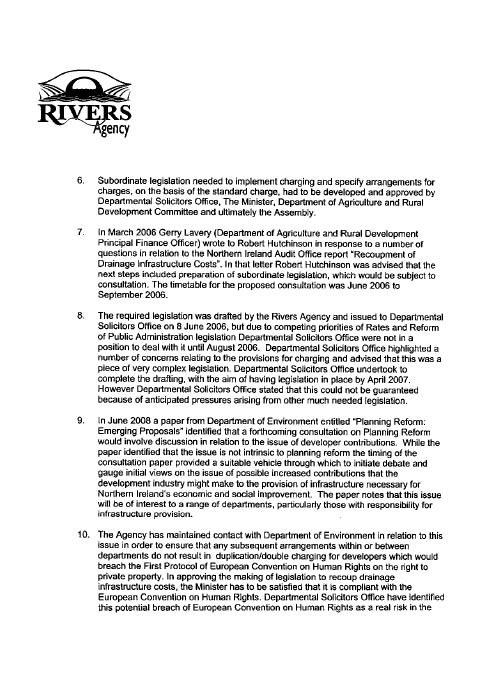
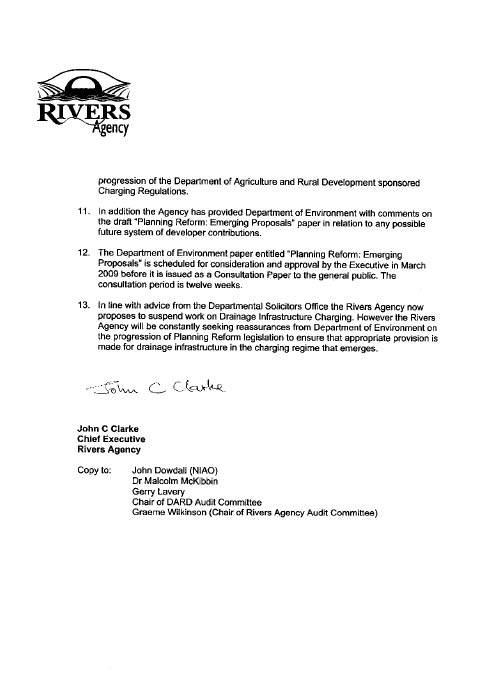
Chairperson’s Letter of 5 May 2009
to Dr Malcolm McKibbin
Public Accounts Committee
Room 371, Parliament Buildings
Belfast BT4 3XX
Tel: (028) 9052 1208
Fax: (028) 9052 0366
Email: Aoibhinn.Treanor@niassembly.gov.uk
Date: 5 May 2009
Dr Malcolm McKibbin
Accounting Officer
Department of Agriculture and Rural Development
Dundonald House
Upper Newtownards Road
Belfast
BT4 3SB
Dear Malcolm
NIAO Report: Recoupment of Drainage Infrastructure Costs (HC 614) and Departmental Responses to Recommendations in NIAO Reports (HC 1149)
Memoranda of Reply: DARD: The Sheep Annual Premium Scheme; and DARD: Brucellosis Outbreak at the Agricultural Research Institute
Thank you for your responses of 20 January 2009 and 4 March 2009 to the Committee’s request for written evidence in relation to the NIAO report and Memoranda of Reply above, which were considered at Committee meeting on the 30 April 2009.
This information will be included in the report which the Committee will publish in due course.
Yours sincerely

Paul Maskey
Chairperson
Public Accounts Committee
Annex B
Chairperson’s Letter of 17 December 2008
to Mr Will Haire
Public Accounts Committee
Room 371, Parliament Buildings
Belfast BT4 3XX
Tel: (028) 9052 1208
Fax: (028) 9052 0366
Email: Jim.Beatty@niassembly.gov.uk
Mr Will Haire
Accounting Officer
Department of Education
Rathgael House
Balloo Road
Bangor
BT19 7PR Date: 17 December 2008
Dear Will
NIAO Report: ‘Education and Health and Social Services Transport’
(HC 32, NIA 178/03, 9th June 2005)
The Committee has requested that I ask you to provide written evidence in relation to the above report.
The Committee is aware that some of the points raised may well have been answered as part of NIAO’s on-going follow-up work. However, the Committee wishes to complete the accountability cycle and publish the responses as part of its Third Composite Report on Issues Dealt with by Correspondence.
The Committee has a number of questions detailed below.
The following relate to paragraph 2.7 of the report:
1 Do the Boards have a common transport fleet management system in place?
2 Have the boards established a common performance measurement framework for transport services?
3 Is transport performance monitored and reviewed against inter-Board targets?
4 Are inter-Board transport performance reports prepared on a 6-momthly basis?
5 Do the Boards have sound fuel monitoring systems in place?
6 Has the monitoring of all Board vehicles (not just school transport) been centralised under Board transport officers?
7 In relation to paragraphs 3.6 and 3.7, what has been the outcome of deliberations on how transport assets in the education sector might be integrated with those in the health and social services to improve efficiency and enhance services?
8 Has the issue of pooling education and health transport funding been addressed as referred to in paragraph 3.24?
9 With reference to paragraph 3.29, what steps have the Department taken to establish arrangements with the health service for the joint purchasing of vehicles, maintenance and fuel?
I should be grateful for a response by 23 January 2009.
Yours faithfully

Paul Maskey
Chairperson
Public Accounts Committee
Correspondence of 21 January 2009
from Mr Will Haire
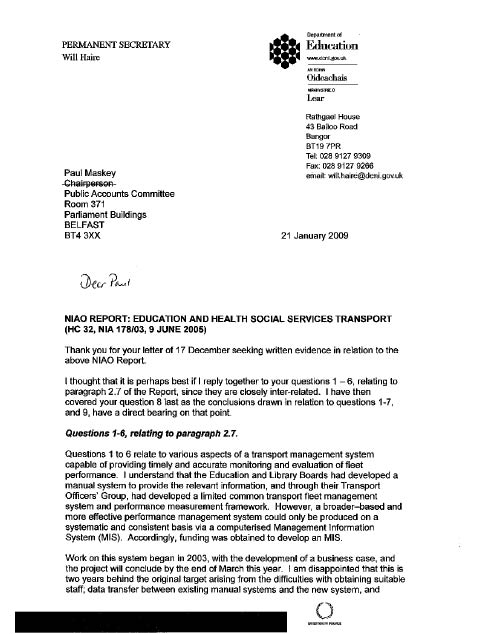
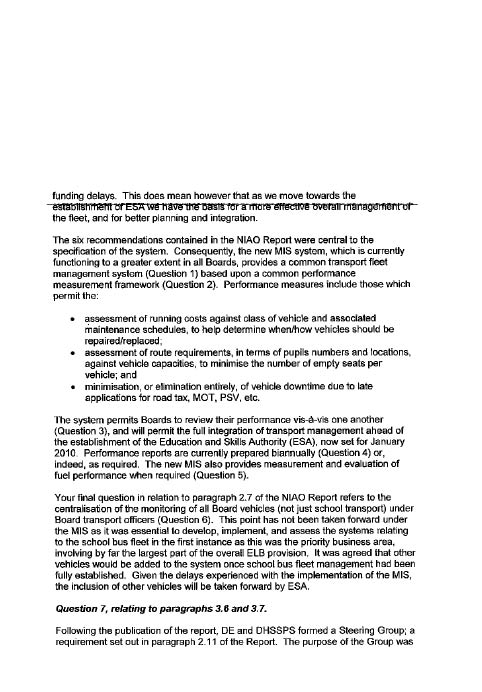
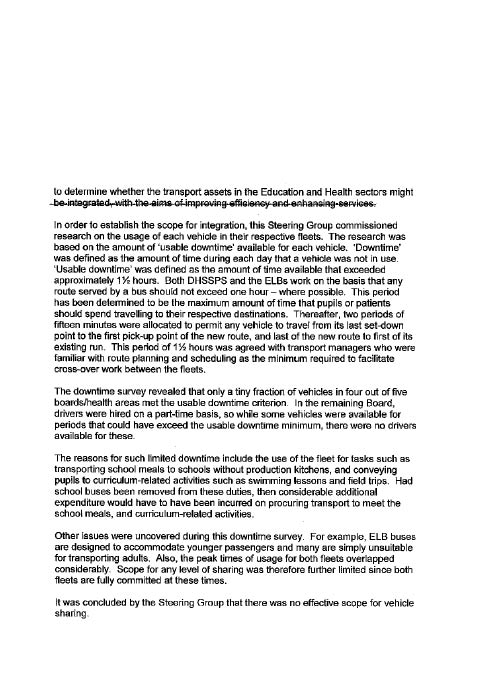

Chairperson’s Letter of 5 May 2009
to Mr Will Haire
Public Accounts Committee
Room 371, Parliament Buildings
Belfast BT4 3XX
Tel: (028) 9052 1208
Fax: (028) 9052 0366
Email: Aoibhinn.Treanor@niassembly.gov.uk
Mr Will Haire
Accounting Officer
Department of Education
Rathgael House
Balloo Road
Bangor
BT19 7PR Date: 5 May 2009
Dear Will
NIAO Report: Education and Health and Social Services Transport (HC 32)
Thank you for your response of 21 January 2009 to the Committee’s request for written evidence in relation to the NIAO reports listed above, which was considered at the Committee meeting on the 30 April 2009.
This information will be included in the report which the Committee will publish in due course.
Yours sincerely

Paul Maskey
Chairperson
Public Accounts Committee
Chairperson’s Letter of 17 December 2008
to Dr Andrew McCormick
Public Accounts Committee
Room 371, Parliament Buildings
Belfast BT4 3XX
Tel: (028) 9052 1208
Fax: (028) 9052 0366
Email: Alison.Ross@niassembly.gov.uk
Dr Andrew McCormick
Accounting Officer
Department of Health, Social Services & Public Safety
Room C5.11
Castle Buildings
Stormont
Belfast
BT4 3SQ Date: 17 December 2008
Dear Andrew
NIAO Report: Education and Health and Social Services Transport
(HC 32, NIA 178/03, 9 June 2005)
NIAO Report: Private Practice in the Health Service (HC 1088, 18 May 2006).
The Committee has requested that I ask you to provide written evidence in relation to the above report.
The Committee is aware that some of the points raised may well have been answered as part of NIAO’s on-going follow-up work. However, the Committee wishes to complete the accountability cycle and publish the responses as part of its Third Composite Report on Issues Dealt with by Correspondence.
The Committee’s questions in relation to the NIAO report on Education and Health and Social Services Transport are as follows:
1 In relation to paragraph 2.11 of the report, has the Department developed a clear statement of objectives for its transport services setting out what is to be achieved, how, by what date and at what cost?
2 With reference to paragraphs 3.6 and 3.7, what has been the outcome of deliberations on how transport assets in the health and social services might be integrated with those in the education sector to improve efficiency and enhance services?
3 Has the issue of pooling health and education transport funding been addressed, as referred to in paragraph 3.24?
4 With reference to paragraph 3.29, what steps have the Department taken to establish arrangements with the education sector for the joint purchasing of vehicles, maintenance and fuel?
The Committee has a number of questions in relation to the NIAO report on Private Practice in the Health Service as follows:
5 What evidence is there that Trusts have been effectively managing the process of agreeing job plans for consultants and monitoring the performance of the contract (paragraph 1.13 refers)?
6 With reference to paragraph 1.17, how effectively are Trusts controlling and documenting the process whereby private patients can revert to health service status following initial private sector consultations?
7 In relation to paragraphs 2.9 and 2.21, what steps have been taken by Trusts to improve the identification and recovery of the full cost to the health service of treating private patients?
I should be grateful for a response by 23 January 2009.
Yours sincerely

Paul Maskey
Chairperson
Public Accounts Committee
Correspondence of 23 January 2009
from Dr Andrew McCormick

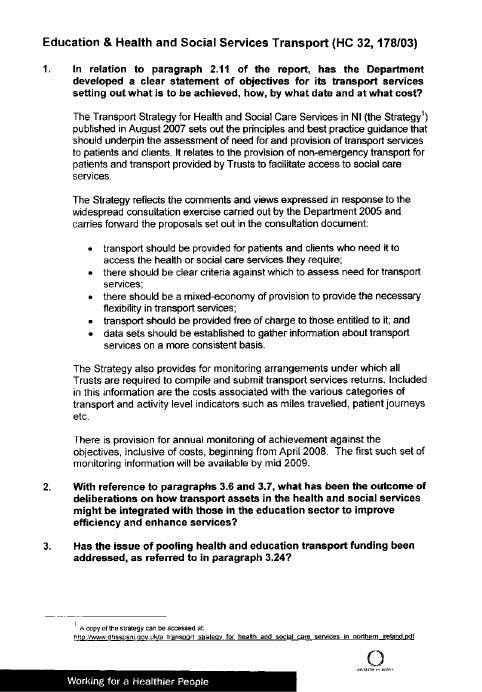
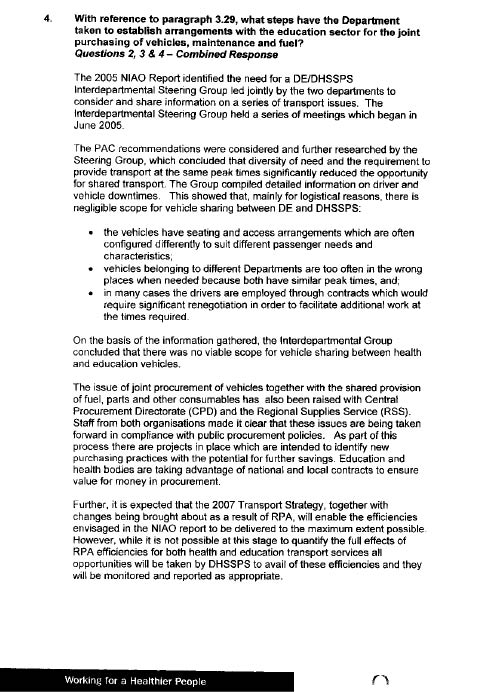
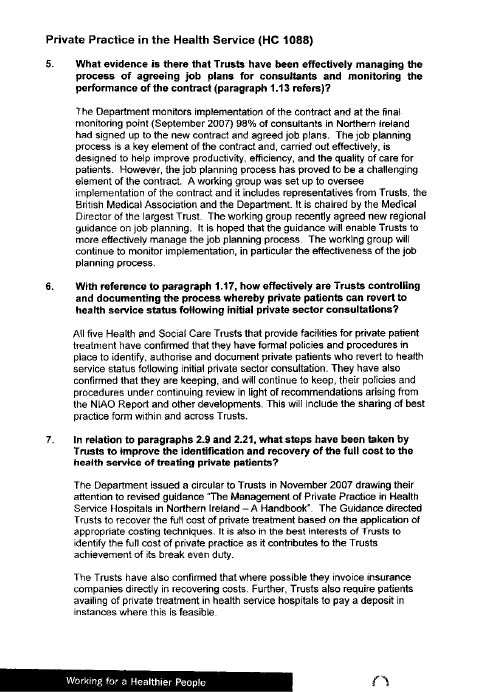
Chairperson’s Letter of 5 May 2009
to Dr Michael McBride
Public Accounts Committee
Room 371, Parliament Buildings
Belfast BT4 3XX
Tel: (028) 9052 1208
Fax: (028) 9052 0366
Email: Aoibhinn.Treanor@niassembly.gov.uk
Dr Michael McBride
Accounting Officer
Department of Health, Social Services & Public Safety
Room C5.11
Castle Buildings
Stormont
Belfast
BT4 3SQ Date: 5 May 2009
Dear Michael
NIAO Report: Education and Health and Social Services Transport (HC 32)
NIAO Report: Private Practice in the Health Service (HC 1088)
Thank you for Dr McCormick’s response of 23 January 2009 to the Committee’s request for written evidence in relation to the NIAO reports listed above, which was considered at Committee meeting on
30 April 2009.
This information will be included in the report which the Committee will publish in due course.
Yours sincerely

Paul Maskey
Chairperson
Public Accounts Committee
Annex C
Chairperson’s Letter of 17 December 2008
to Dr Andrew McCormick
Public Accounts Committee
Room 371, Parliament Buildings
Belfast BT4 3XX
Tel: (028) 9052 1208
Fax: (028) 9052 0366
Email: Alison.Ross@niassembly.gov.uk
Dr Andrew McCormick
Accounting Officer
Department of Health, Social Services & Public Safety
Room C5.11
Castle Buildings
Stormont
Belfast
BT4 3SQ Date: 17 December 2008
Dear Andrew
NIAO Report: Education and Health and Social Services Transport
(HC 32, NIA 178/03, 9 June 2005)
NIAO Report: Private Practice in the Health Service (HC 1088, 18 May 2006).
The Committee has requested that I ask you to provide written evidence in relation to the above report.
The Committee is aware that some of the points raised may well have been answered as part of NIAO’s on-going follow-up work. However, the Committee wishes to complete the accountability cycle and publish the responses as part of its Third Composite Report on Issues Dealt with by Correspondence.
The Committee’s questions in relation to the NIAO report on Education and Health and Social Services Transport are as follows:
1 In relation to paragraph 2.11 of the report, has the Department developed a clear statement of objectives for its transport services setting out what is to be achieved, how, by what date and at what cost?
2 With reference to paragraphs 3.6 and 3.7, what has been the outcome of deliberations on how transport assets in the health and social services might be integrated with those in the education sector to improve efficiency and enhance services?
3 Has the issue of pooling health and education transport funding been addressed, as referred to in paragraph 3.24?
4 With reference to paragraph 3.29, what steps have the Department taken to establish arrangements with the education sector for the joint purchasing of vehicles, maintenance and fuel?
The Committee has a number of questions in relation to the NIAO report on Private Practice in the Health Service as follows:
5 What evidence is there that Trusts have been effectively managing the process of agreeing job plans for consultants and monitoring the performance of the contract (paragraph 1.13 refers)?
6 With reference to paragraph 1.17, how effectively are Trusts controlling and documenting the process whereby private patients can revert to health service status following initial private sector consultations?
7 In relation to paragraphs 2.9 and 2.21, what steps have been taken by Trusts to improve the identification and recovery of the full cost to the health service of treating private patients?
I should be grateful for a response by 23 January 2009.
Yours sincerely

Paul Maskey
Chairperson
Public Accounts Committee
Correspondence of 23 January 2009
from Dr Andrew McCormick

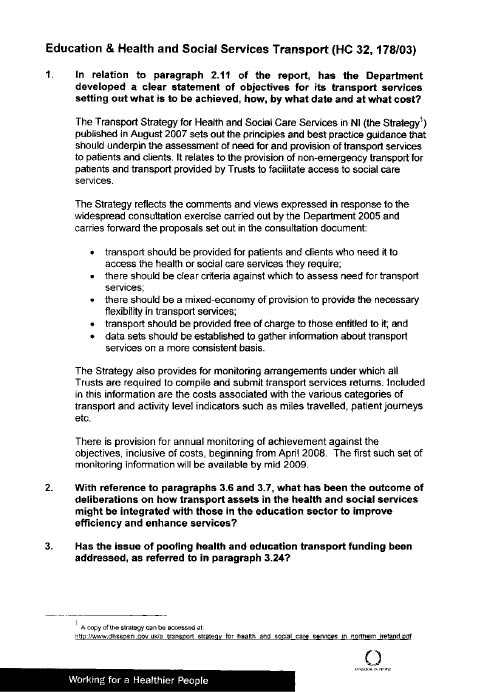
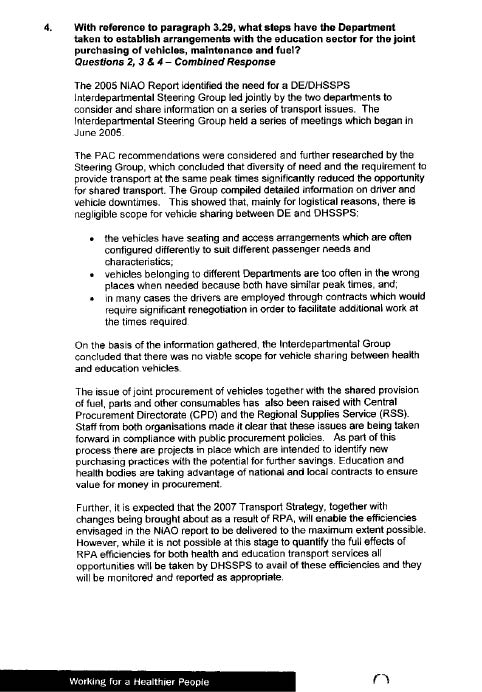
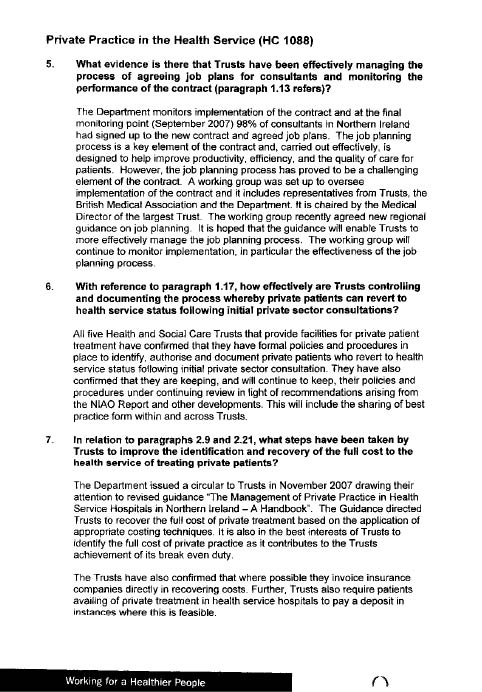
Chairperson’s Letter of 5 May 2009
to Dr Michael McBride
Public Accounts Committee
Room 371, Parliament Buildings
Belfast BT4 3XX
Tel: (028) 9052 1208
Fax: (028) 9052 0366
Email: Aoibhinn.Treanor@niassembly.gov.uk
Dr Michael McBride
Accounting Officer
Department of Health, Social Services & Public Safety
Room C5.11
Castle Buildings
Stormont
Belfast
BT4 3SQ Date: 5 May 2009
Dear Michael
NIAO Report: Education and Health and Social Services Transport (HC 32)
NIAO Report: Private Practice in the Health Service (HC 1088)
Thank you for Dr McCormick’s response of 23 January 2009 to the Committee’s request for written evidence in relation to the NIAO reports listed above, which was considered at Committee meeting on
30 April 2009.
This information will be included in the report which the Committee will publish in due course.
Yours sincerely

Paul Maskey
Chairperson
Public Accounts Committee
Annex D
Chairperson’s Letter of 16 March 2009
to Mr Stephen Peover
Public Accounts Committee
Room 371, Parliament Buildings
Belfast BT4 3XX
Tel: (028) 9052 1208
Fax: (028) 9052 0366
Email: Alison.Ross@niassembly.gov.uk
Mr Stephen Peover
Accounting Officer
Department of the Environment
Clarence Court
10 - 18 Adelaide Street
Belfast
BT2 8GB 16 March 2009
Dear Stephen
Departmental Responses to Recommendations in NIAO reports HC206 published 19 July 2005 – Areas of Special Scientific Interest (ASSIs)
The Committee has requested that I ask you to provide written evidence in relation to the above report. The responses will be publishes as part of its Third Composite Report on Issues Dealt with by Correspondence.
The Committee’s questions in relation to the NIAO report are follows:
The arrangements for identifying and designating ASSIs
1. Your response to question 1 in the report stated that designation of three additional sites, required under the EC Birds Directive and EC Habitats Directive would be completed during the 2005-06 financial year. Please provide details of when these designations were completed.
2. Your response to question 2 outlined progress made in relation to seven steps suggested in the C&AG’s report, designed to improve management of the ASSI designation programme. Please provide an update on those areas where your response indicated that you would undertake further action, i.e.
- Point 1: Results of yearly progress reports and the 2006 review of targets;
- Point 3: progress on meeting the 2015 target for site designation;
- Point 4: progress on meeting your annual Operational Plan designation targets; and
- The current status of the integrated, geo-referenced database for all sites, due to be in place during 2006-07.
The proper management of ASSIs
3. Your response to question 3 provided details on the numbers of management agreements in place under the Management of Sensitive Sites (MOSS) scheme, and associated financial savings, when compared with the previous compensation arrangements. Please provide details of the numbers of agreements currently in place and the total estimated savings now realised.
4. Your response to question 4 gave an account of progress in implementing the Environment Order’s five key changes to site monitoring and management, and the additional steps recommended in the report (paragraph 2.20). Please provide details of the following:
- Point 2: what further payments, if any, have been made in respect of management agreements relating to buyout of turbary rights?
- Point 3: Have the financial guidelines referred to in your response now been published?
5. Your response to question 5 provided information on the timeliness of processing applications from ASSI landowners requesting EHS consent to carry out certain activities on their sites. Please provide an update on performance in processing consent applications since the date of your response to question 5.
Protecting ASSIs from damage
6. Your response to question 6 stated that the target date for completing the monitoring cycle for existing ASSIs, to assess their condition, was March 2008. Please provide details of the outcome of the conditions monitoring cycle, together with remedial action undertaken, or planned, to address any shortfalls identified,
7. In your response to question 7, you provided details of compliance action taken in respect of ASSIs, including DPP referral and court action, and referred to ongoing review of policy and procedures. Please provide details of any amendments to policy or procedures since the date of your response, together with details of further compliance actions undertaken in the interim.
8. Your response to question 8 stated that it was intended to replace the Memorandum of Understanding between your Department and DARD, in relation to MOSS and DARD’s agri-environment schemes, with a Service Level Agreement in the 2005-06 financial year. You also stated that a draft SLA with Planning Service would be progressed as a matter of urgency. Please provide an update on the progress of both SLAs.
9. Question 9 referred to the NIAO recommendation that all ASSI data should be consolidated into one database, with online access for Planning Service and DARD. Your response indicated that you intended to provide regional offices with online access to the database by early 2006-07, with access for Planning Service and DARD by the end of that year. Can you please confirm that both steps are now in place?
10 Your response to question 10 indicated that there would be further work with DARD to explore closer, even unified, links for delivering related conservation objectives and associated payments. Please provide an update on the outcome of this work.
I would appreciate your response by Monday, 16 March 2009.
Yours sincerely

Paul Maskey
Chairperson, Public Accounts Committee
Correspondence of 27th April 2009
from Mr Stephen Peover
From the office of the Clarence Court
Permanent Secretary 10-18 Adelaide Street
Stephen Peover Belfast BT2 8GB
Telephone: (028) 9054-0002
Facsimile: (028) 9054-0082
Email: stephen.peover@doeni.gov.uk
Mr Paul Maskey MLA
Chairperson
Public Accounts Committee
Room 371
Parliament Buildings
Belfast
BT4 3XX 27th April 2009
Your reference:
Our reference: PSE: 0090.09
Dear Mr Maskey
Departmental Responses to Recommendations in NIAO Report HC206 Published
19 July 2005 – Areas of Special Scientific Interest
I refer to your letter of 16 March 2009 advising that the Public Accounts Committee seeks written evidence in relation to the above report.
I have responded to each of your questions using your numbering sequence. Should you require documentary evidence of the Department’s achievements since 2005 or any additional information please do not hesitate to let me know, or alternatively you may wish to go direct to Graham Seymour, the Director of Natural Heritage in the Northern Ireland Environment Agency (NIEA).
You will no doubt be aware that NIEA came into being on 1 July 2008 replacing the former Environment and Heritage Service who were the recipients of the original NIAO report and who provided the response in 2005. For ease I shall refer to NIEA throughout this response.
1. EC obligations at the time of publication of the above report related to the designation of Special Areas of Conservation (SACs) and Special Protection Areas (SPAs) under the Habitats and Birds Directives respectively. These obligations were met with the designation of the River Roe and Tributaries SAC on 30 November 2005; and the classification of Antrim Hills on 31 March 2006 SPA and Slieve Beagh/Mullaghfad/Lisnaskea SPA on 28 March 2006.
In addition, the River Faughan and Tributaries was submitted to the EC as a candidate SAC on 31 August 2008 to provide further protection for Atlantic Salmon within Northern Ireland.
2. Points 1 and 3. A review of the ASSI declaration programme was undertaken by NIEA in 2006 in keeping with the Department’s response to NIAO. This review was carried out in conjunction with the Department’s statutory advisory body, the Council for Nature Conservation and the Countryside (CNCC). A key outcome of the review was the identification of a priority list of an additional 200 ASSIs to be declared by 2016. This will bring the total number of ASSIs to approximately 440 and at that stage the programme will be considered substantially complete. The priority list of proposed ASSIs was agreed with CNCC in January 2007.
An additional target to declare 25 ASSIs yearly during the currency of the present Programme for Government is regarded as an important milestone towards the completion of the programme by 2016 and is a PSA target for the Department. The PFG target to declare 25 ASSIs during 2008/09 has been met.
2. Point 4. The PFG target to declare 25 ASSIs in 2008/09 was reflected in the Operational Plans for the Conservation Designations and Protection, Conservation Science and Regional Operations Units within NIEA.
See 9 for a response to the question on ASSI databases.
3. Compensatory management agreements were introduced under the Nature Conservation and Amenity Lands (Northern Ireland) Order 1985 and a total of 261 were issued, with total payments amounting to £2,513k.
The Environment (Northern Ireland) Order 2002 resulted in a change in the nature of management agreements and the introduction of the Management of Sensitive Sites (MOSS) Scheme. Payments have been made under this scheme for the positive and beneficial land management required to secure or enhance the special scientific interests of designated sites. Since the introduction of MOSS in March 2002, 117 management agreements have been issued attracting payments totalling £2,103k to date.
Given the significant differences in the two types of agreement it is not thought possible to make a reasoned determination of the total savings realised. The change to agreements which are supported by payments calculated on an income foregone basis was also a requirement of State Aid rules administered by the EC.
4. Point 2. One payment of £4,750 has been made in respect of turbary.
4. Point 3. Guidance notes for entrants to the MOSS scheme were published in 2002. MOSS has recently been reviewed and has been re-launched as the “MOSS Recovery Scheme." Payments made under the revised MOSS scheme are now aligned with those paid by the Department of Agriculture and Rural Development (DARD) under its Northern Ireland Countryside Management Scheme. A notice of this change has been published on the NIEA website.
5. ASSI consent applications processed and outcomes in each financial year are as follows:
| Year | No. processed | Outside statutory deadline |
| 2005/06 | 98 | 0 |
| 2006/07 | 139 | 2 |
| 2007/08 | 173 | 1 |
| 2008/09 | 113 | 0 |
6. NIEA initiated a programme of site quality monitoring (also known as condition assessment) in 2002. In March 2008 the first full cycle was completed, allowing a comprehensive assessment of the condition of the ASSI network to be made. NIEA published the report of this work on its website in August 2008.
The results show that around two thirds of the features on ASSIs are meeting their objectives – i.e. are in favourable condition. However, a significant proportion (slightly less than one third) is in unfavourable condition. The reasons for unfavourable condition of features vary; inappropriate grazing levels, changes in agricultural practices, the presence of invasive species, drainage activities and water quality are some of the factors which influence their condition.
Even though changes in the wider countryside are likely to reduce some of the pressures on ASSIs, NIEA recognises that restoring ASSIs to favourable condition will be a challenging task. As a result, NIEA has adopted a new strategic approach to the management of designated sites. The aim of this approach is to identify for every ASSI in unfavourable condition, a “remedy" to its adverse condition. A system for agreeing the delivery with land owners/managers and key partners will be put in place, targeted spatially across each of the management units.
It is anticipated that DARD, working closely with NIEA, will deliver favourable condition for many sites through the Northern Ireland Countryside Management Scheme. Where additional management works are required, NIEA’s re-launched MOSS Recovery Scheme will provide beneficial management of the land for nature conservation purposes.
7. The provision of new enforcement powers through the introduction of the Environment Order 2002 resulted in the issue of a compliance policy document in September 2002 and the subsequent introduction of related procedures. The policy has been subsequently revised and re-issued as the “Compliance Policy and General Guidance for Protection of ASSIs". This document includes the procedures for dealing with reports of damage and can be viewed on the NIEA website.
In response to the recommendations of the Criminal Justice Inspectorate, NIEA has reviewed its policies for compliance and enforcement. A draft policy document setting out the general principles that NIEA will follow in relation to enforcement and prosecution has recently been issued for public consultation.
Between the period of 1 April 2005 and 31 March 2009 a further 5 cases were sent to Public Prosecution Service (PPS) for consideration for prosecution and this resulted in 4 convictions. One case was deemed unsuitable for prosecution by PPS due to insufficient evidence. In addition, 206 cautionary letters have been issued to possible offenders, and 38 referrals have been sent to other departments/agencies for consideration of possible breaches of their legislation.
8. A Memorandum of Understanding (MoU), rather than a Service Level Agreement (SLA), was considered appropriate to formalise relationships between DARD and NIEA with regard to agri-environment schemes. This MoU was agreed in March 2008. A second MoU with DARD relating to forestry operations was completed in February 2008 and in March 2009 a MoU relating to fisheries was signed by both parties.
A SLA between Planning Service and NIEA has been in place since March 2007.
9. The development of a single, integrated database for all aspects of ASSI work has not progressed as envisaged in 2005. The transfer of ASSI casework to staff based in regional offices did not proceed following a review by the Business Improvement Service which concluded that the perceived benefits would not outweigh the costs. Furthermore, proceeding with the database as envisaged at that time would have created substantial resource difficulties for the Agency and impacted on its ability to meet its declaration targets. NIEA is satisfied that existing databases meet its operational requirements with regard to the declaration of ASSIs.
However, with the development of its “remedies" approach to the management and enhancement of ASSIs, the Agency perceives a growing need for a bespoke database that will record site details at the level of individual management units. NIEA has set aside funding within 2009/10 to scope the requirements of this database.
10. NIEA and DARD have agreed and implemented a co-ordinated approach to providing conservation and agricultural assistance to owners and occupiers in ASSIs and have established links for the delivery of associated payments. This has successfully delivered 530 joint conservation management plans on farms within ASSIs based on conservation objectives during 08/09.
Yours sincerely
Stephen Peover
Chairperson’s Letter of 5 May 2009
to Mr Stephen Peover
Public Accounts Committee
Room 371, Parliament Buildings
Belfast BT4 3XX
Tel: (028) 9052 1208
Fax: (028) 9052 0366
Email: Aoibhinn.Treanor@niassembly.gov.uk
Mr Stephen Peover
Accounting Officer
Department of the Environment
Clarence Court
10-18 Adelaide Street
Belfast
BT2 8GB Date: 5 May 2009
Dear Stephen
NIAO Report: Departmental Responses to Recommendations in NIAO Reports (HC 206) –
Areas of Special Scientific Interest (ASSIs)
Thank you for your response of 27 April 2009 to the Committee’s request for written evidence in relation to the NIAO report above, which was considered at Committee meeting on 30 April 2009.
This information will be included in the report which the Committee will publish in due course.
Yours sincerely

Paul Maskey
Chairperson
Public Accounts Committee
Annex E and F
Chairperson’s Letter of 14 January 2009
to Dr Malcolm McKibbin
Public Accounts Committee
Room 371, Parliament Buildings
Belfast BT4 3XX
Tel: (028) 9052 1208
Fax: (028) 9052 0366
Email: Alison.Ross@niassembly.gov.uk
Dr Malcolm McKibbin
Accounting Officer
Department of Agriculture and Rural Development
Dundonald House
Upper Newtownards Road
Belfast
BT4 3SB Date: 14 January 2009
Dear Malcolm
Memoranda of Reply: DARD: The Sheep Annual Premium Scheme, and
DARD: Brucellosis Outbreak at the Agricultural Research Institute
The Committee has requested that I write to you for an update on the progress against the Department’s responses to the Committee’s conclusions, including the main conclusions, of the House of Commons Committee on Public Accounts reports on The Sheep Annual Premium Scheme, and Brucellosis Outbreak at the Agricultural Research Institute.
I would be grateful if we could have your response by Friday, 13 February 2009.
Yours sincerely

Paul Maskey
Chairperson
Public Accounts Committee
Correspondence of 4 March 2009
from Dr Malcolm McKibbin
 Room 636, Dundonald House
Room 636, Dundonald House
Upper Newtownards Road
Belfast BT4 3SB
Tel: 028 9052 4608
Fax: 028 9052 4813
Email: malcolm.mckibbin@dardni.gov.uk
Mr Paul Maskey
Chairperson
Public Accounts Committee
Room 371
Parliament Buildings
BELFAST
BT4 3XX Date: 4 March 2009
Our Ref: PS/40/09
Dear Mr Maskey
Memoranda of Reply: DARD: The Sheep Annual Premium Scheme, and DARD: Brucellosis Outbreak at the Agricultural Research Institute
Thank you for your email letter dated 14 January 2009 requesting an update on progress against the Department’s responses to the Committee’s conclusions, including the main conclusions of the House of Commons Committee, on Public Accounts reports on The Sheep Annual Premium Scheme and the Brucellosis Outbreak at the Agricultural Research Institute.
Please find attached DARD’s memoranda of reply in respect of the Public Accounts Committee’s conclusions.
If you require any additional information please do not hesitate to contact me.
Yours sincerely

D M McKibbin (Dr)
Permanent Secretary
Response to Conclusions & Recommendations in respect of the Sheep Annual Premiums
The Committee’s main conclusions
It is clear that this scheme has not received the close management and supervision that it deserves. The most damning aspect of the Department’s handling is the extent to which key requirements of the scheme were repeatedly ignored, over a long period of time. Non-compliance was not confined to unscrupulous claimants-there is evidence that Departmental staff were at times complicit in turning a blind eye to the rules. As a result, the integrity of the scheme has been undermined. With non compliance often leading to overpayment of premium, we can only conclude that the Department has been failing in its duty as custodian of the public purse.
The Department of Agriculture and Rural Development (“the Department") notes the Committee’s comments. The issues raised by Committee are addressed in response to PAC Conclusion 26.
Current Position
As above, the issues raised by Committee are addressed in response to PAC Conclusion 26 below.
The Department’s failure to properly address the weakness in control, highlighted by the European Court of Auditors 1994, was a serious error in judgement. Given the risk of disallowance for failing to enforce EU controls, the Department’s disregard for the auditor’s recommendations, especially on flock records and markings, was irresponsible. The Department has to understand that ignoring EU requirements is not an option as it creates a liability which the taxpayer may have to repay.
The Department notes the Committee’s comments. The issues raised by Committee are addressed in response in response to PAC Conclusion 7.
Current Position
As above, the issues raised by Committee are addressed in response to PAC Conclusion 7 below.
We want to emphasise that a ‘£’ of EU subsidy is as much taxpayers’ money as any other form of voted money-this Committee makes no distinction between the rigorous safeguards we expect to see operated for EU subsidies and any other form of grant payment. The Department must be in no doubt that we expect all of its schemes to be administered in line with best practice. We welcome the Accounting Officer’s assurance that he has accepted all of the recommendations in the C&AG’s Report. However, we have asked the C&AG to re-examine this scheme in due course and to report on the outcome.
The Department can confirm that it has accepted all the recommendations in the C&AG’s report and notes the Committees request that the C&AG should re-examine the Sheep Annual Premium Scheme (SAPS) in due course. The other issues raised by the Committee are addressed in response to PAC Conclusion 27.
Current Position
As above the issues raised by Committee are addressed in response to PAC Conclusion 27 below.
Our overall impression is that the Department has in the past been soft on fraud and this has contributed to unacceptably high levels of fraud within Northern Ireland agriculture. Indeed, having carefully examined the evidence, we are convinced that many fraudsters would have regarded an attempt to cheat the scheme as a risk worth taking, given the slackness in control and the Department’s poor record of prosecution. We welcome the Accounting Officer’s assurances that his Department now operates a policy of zero tolerance to fraud and that attempts to cheat the system are being tackled in a much more vigorous way. We expect to see a much improved performance when the C&AG next examines this or any other scheme in the Department.
The Department is confident that when C&AG next examines SAPS, or any other departmental scheme, he will see evidence of considerable improvements. The other issues raised by the Committee are addressed in response to PAC Conclusion 25.
Current Position
As above, the issues raised by Committee are addressed in response to PAC Conclusion 25 below.
Improving the effectiveness of Farm Inspections
PAC Conclusion 1
It is of major concern that the level of discrepancies noted by the Department’s inspectors, when accompanied on farm visits by the Audit Office, was many times higher than when they were not accompanied. It appears to us that, by turning a blind eye to irregularities during on-farm visits, some inspectors were complicit with farmers in claiming more money than they were properly due. The Department must ensure that all irregularities are reported by inspectors.
The Department fully appreciates the Committee’s concern about the level of discrepancies noted by the Department’s inspectors and accepts the Committee’s recommendation that all irregularities must be reported. It also takes very seriously the views expressed by the Committee in relation to possible collusion between inspectors and farmers. There is no evidence that collusion has taken place or that inspectors failed to follow agreed procedures. Had there been, the Department can assure the Committee that it would have taken appropriate action against all those involved. However, it does recognise that inspectors had been provided with a considerable degree of discretion, in relation to the type of irregularities that can be reported during the inspection process. As a consequence, the Department has revised its procedures to minimise further the potential for collusion and to provide a clearer audit trail.
Accordingly, for 2004, revised inspection report forms are being introduced to enable the comprehensive recording of all inspection findings. As a result, inspectors will no longer have the lead role in judging what is material to the application of penalties – this will be left to the scheme management section which operates independently from inspectors. This further separation of duties will help to ensure and demonstrate the application of a clear and consistent approach to the inspection process. Further information on this issue is provided in the response to PAC Conclusion 20.
Departmental Commitment
The Department to ensure that all irregularities during on-farm visits are reported.
For 2004, revised inspection report forms are being introduced to enable the comprehensive recording of all inspection findings.
Current position
Systems are in place to record all irregularities found at inspections. Supervisors and Grade 2’s undertake two reinspections for each of the inspectors they supervise. Each year in advance of the annual Single Application cycle, inspectors are briefed and issued with updated guidance. The department is currently rolling out the use of GPS equipment and E- inspection reporting. These facilities will provide an audit trail of fields visited and ensure that inspection findings are recorded in the field and any revisions to findings identified. The department has aerial photography for all fields and that provides a means of corroborating inspection findings.
The Sheep Annual Premium Scheme closed down in 2004
PAC Conclusions 2 & 3
We were surprised to find that payments were being made for sheep that had apparently died, but which had not been reported or replaced. Decisions by inspectors to ignore well-established rules cannot be justified. It also sends out the wrong message to farmers, making it harder to enforce the rules on future occasions. This practice must stop immediately.
There is compelling evidence that the vast majority of sheep losses have not been reported, despite the requirement to do so. It is likely, therefore, that many payments of premium which were not properly due have been made. Given the large numbers of sheep involved, the overall level of overpayment is probably substantial. The Department must take action to ensure that all sheep deaths are reported, where premium has been claimed. Where farmers fail to comply, penalties should be rigorously applied.
The Department notes the Committee’s comments and agrees that well-established rules must be applied in all cases. It agrees that its policy of allowing inspectors to accept unnotified losses in some circumstances was wrong and open to abuse by less scrupulous farmers. It also agrees that the practice must stop and that all sheep deaths which affect subsidy payments must be reported. Procedures have been tightened accordingly. From January 2002, if a farmer claimed that a shortfall in sheep was attributable to natural losses, inspectors were required to ask to see carcasses or fresh graves. From January 2004, with the banning of on-farm burial, sight of fresh carcasses or appropriate disposal documentation is obligatory at inspection and, in addition, the flock records will be checked for confirmation. Losses will only be accepted for a reduction in the claim without penalty in accordance with EU regulations. As noted in the Audit Office report, because of the extensive nature of sheep farming, particularly in hill areas, farmers may not be aware of some losses until the inspection. In such cases, if fresh carcases are found at the inspection, the claim will be reduced accordingly without penalty. Otherwise, if the Department has evidence that a farmer has failed to meet the notification requirement, penalties will be rigorously applied.
Departmental commitment
The Department has tightened its inspection checks and procedures where the shortfall in sheep is attributable to natural circumstances.
Current position
From January 2004 on farm burials of animals are banned. The Department runs stocking density checks against APHIS and data on Single Farm applications to establish eligibility under the Less Favoured Area Compensatory Allowances Scheme (LFACA).
The Sheep Annual Premium Scheme closed down in 2004.
PAC Conclusion 4
We find the circumstances surrounding the Department’s 1998 decision to allow payments for sheep at unnotified locations quite extraordinary. Not only was this contrary to EU rules, but the Department has no record of its decision, despite a senior official apparently travelling to Brussels to discuss the matter. This is astonishing. Unauthorised changes to EU rules are wholly unacceptable, not least because they carry the risk of disallowance. We take a very dim view of any breach of well-established rules, but especially where it is compounded by such shabby administration. We also want to make clear that this Committee will only accept explanations from the Accounting Officers where these are adequately supported by documentary evidence.
The Department accepts that’s its decision to allow payments for sheep at unnotified locations was vulnerable to challenge because it was based on a particular interpretation of EU requirements, albeit consistent with the practice elsewhere in the UK at that time. The Department regrets that there is no record of the specific meeting in Brussels where the acceptability of the Department’s interpretation of the EU requirements was confirmed.
As part of the general strengthening of counter-fraud policy in the Agricultural Sector across the UK in 2002, the Department revised its policy and now disallows sheep on unnotified locations with the single exception where sheep are judged to have strayed into an adjoining field. It wishes to assure the Committee that its normal practice is to ensure that all policy decisions and significant policy discussions are properly documented. The Department of Finance and Personnel (DFP) fully supports the Committee’s conclusion that all explanations from Accounting Officers should be adequately supported by documentary evidence and will bring this conclusion to the attention of all Accounting Officers.
Departmental commitment
The Department revised its policy in 2002 with regards to sheep found at unnotified locations, in line with the counter-fraud policy across the UK Agriculture sector.
Current position
The Sheep Annual Premium Scheme closed down in 2004. The only scheme relying on stock levels is LFACA and in that case only a minimum stocking level is required (0.2 LU per hectare) to achieve eligibility. There is no advantage under the scheme in overstating stocking levels.
PAC Conclusion 5
Despite all farmers signing an undertaking to provide reasonable assistance during inspections, there were a number of cases where farmers had refused to help inspectors. Allowing farmers to get away with this is indicative of the slack control regime the Department has been operating. We welcome the Accounting Officer’s undertaking that, from now on, any farmer who refuses to co-operate will not be paid.
The Department notes the Committee’s comments and has strengthened its controls to apply the maximum penalties available under the EU and domestic legislation where farmers fail to co-operate at an on-farm inspection. If a farmer prevents an inspection from taking place, the claim is disallowed and the farmer prosecuted. Prosecution will also be pursued in any case where a farmer fails to provide reasonable assistance to enable an inspector to exercise his powers under the Scheme legislation. Written guidelines have been introduced for 2004 to assist inspectors in handling and recording lack of co-operation. Farmers will be warned at inspection of the consequences of failure to co-operate and any non-co-operation will be recorded on the inspection form, so that the case for prosecution can be assessed and it is the Department’s intention to pursue prosecution in such cases. The Accounting Officer’s letter of 21st January 2004 to the Clerk of the Committee is appended and provides further clarification on this matter.
Departmental commitment
The Accounting Officer gave a commitment that farmers who fail to co-operate will not be paid.
Current position
The Sheep Annual Premium Scheme closed down in 2004. The Department ensures the required inspection is completed before any current scheme payment is made.
Raising the standard of flock records and markings
PAC Conclusions 6 & 7
We find it disturbing that, some seven years after the European Court of Auditors reported that flock records were in a lamentable state, there appears to have been little improvement. It is utterly pointless to instruct farmers to maintain proper flock records and threaten to penalise them for non-compliance, but then fail to check and enforce the requirement. The Department needs to get a grip on flock records and demonstrate to farmers that any failure to comply with the regulations will no longer be tolerated.
The Department’s failure to properly address the weaknesses in control, highlighted by the European Court of Auditors in 1994, was a serious error in judgement. Given the risk of disallowance for failing to enforce EU controls, the Department’s disregard for the auditor’s recommendations, especially on flock records and markings, was irresponsible. The Department has to understand that ignoring EU requirements is not an option as it creates a liability, which the taxpayer may have to repay.
The Department accepts that it should have been more diligent in addressing the weaknesses in control highlighted in 1994, particularly on flock records and markings, and that the approach which it had adopted in relation to flock records was based on a misinterpretation of EU requirements.
The Department has strengthened and publicised its approach to record keeping for 2004 and has advised all individual claimants accordingly. Revised instructions have been drawn up for inspectors, setting out detailed requirements for the inspection of records. All farmers are expected to ensure that their flock records are held on the farm and are available at all times for inspection. This will occur in the vast majority of cases. However, where the farmer is not present at the time of inspection or the records are not present on the farm (for example, they are with the farmer’s accountant), the farmer will be told to present them urgently and in any event within a maximum of 48 hours, otherwise their claim will be rejected. In all cases where they have no current records, their claim will also be rejected. The issue of flock markings is dealt with in the Department’s response to PAC Conclusion 10.
The Department would assure the Committee that it accepts fully its responsibility to the taxpayer and has never considered ignoring EU requirements as an option.
Departmental commitment
The Department strengthened and publicised its approach to record keeping for the 2004 Scheme.
Current position
The Sheep Annual Premium Scheme closed down in 2004. Since 2004, all flocks are required to return an annual sheep inventory to DARD in the first week of December each year. In support of this, all sheep flocks were issued with a new 6 digit flock number (flock mark) and a new individual animal identification policy was introduced under the Northern Ireland Sheep and Goats Identification and Movement System. A further development, the introduction of individual movement recording using EID, is anticipated to roll out from 31 December 2009 under EU Regulation 21/2004.
The Department implements a rigorous enforcement policy, including approximately 450 Sheep Identification Inspections year in Northern Ireland. Where necessary, this is complemented by a series of random spot checks on farm, and in sheep markets and meat plant lairages. Non-compliances discovered at inspection can be fed forward to inform the selection of inspection visits in the following year. Prosecution is considered where breaches are regarded as sufficiently serious.
PAC Conclusion 8
We regard flock records as an extremely important control, with benefits over and above sheep annual premium – for example, they are a key source of information during disease outbreaks, as was demonstrated during Foot and Mouth in 2001. Because of these wider benefits, checks on flock records should not be confined solely to the retention period, but should take place throughout the year
The Department welcomes the Committee’s recommendation, particularly in the context of wider control objectives, and will make provision for regular checks of flock records throughout the year.
Departmental commitment
The Department to make provision for regular checks of flock records throughout the year.
Current position
While the Sheep Annual Premium Scheme closed in 2004, flock records continue to be checked as part of the Single Farm Payment cross-compliance inspection programme.
Veterinary Service also carries out sheep inspections under animal welfare and other legislation. Any breaches found in these are also reported under the cross-compliance framework and can affect the claimant’s Single Farm Payment. Approximately 450 of these Sheep Identification Inspections are carried out each year in Northern Ireland. Non-compliances discovered at inspection can be fed forward to inform the selection of inspection visits in the following year. The level of compliance is currently comparable to that across the United Kingdom.
PAC Conclusion 9
It seems to us that the Department’s system of checking flock records is rendered completely useless by allowing a delay of up to 10 days to complete the check. In our view, the Department should make clear that it is up to farmers to ensure that their flock records are held on the farm and are available at all times for inspection. Failure to comply should result in some form of sanction.
The Department notes the Committee’s recommendation and, for the 2004 sheep Annual Premium Scheme, it is introducing a much tighter approach, as explained in the response to conclusions 6 and 7. It will ensure that failure to comply with these more restrictive procedures will result in appropriate sanctions being applied.
Departmental commitment
The Department to introduce a much tighter approach in respect of checking flock records for the 2004 Sheep Annual Premium Scheme.
The Department to ensure that failure to comply with these more restrictive procedures will result in appropriate sanctions being applied.
Current position
Sanctions being applied in accordance with Commission Regulation 2419/01 (as amended).
Under the current European Regulations Paying Agencies may give 14 days notice in respect of land eligibility inspections and a number of cross-compliance checks. However, at most 48 hours notice may be given in respect of animal welfare and animal identification cross compliance checks. These limits are respected by the Department.
Approximately 450 of Sheep Identification Inspections are carried out each year in Northern Ireland, during which Flock registers are checked. Non-compliances discovered at inspection can be fed forward to inform the selection of inspection visits in the following year. The level of compliance is currently comparable to that across the United Kingdom
PAC Conclusions 10 & 11
Flock markings is another control measure where the Department appears to have paid scant regard to the findings of the EU auditors in 1994. We recognise that flock marking is not foolproof, but it can provide added assurance at inspection, as a counter to the fraudulent ‘borrowing’ of sheep. As with flock records, the department needs to send a clear message to farmers that flock markings is obligatory and failure to comply with the regulations will no longer be tolerated.
While we welcome the department’s decision to introduce the individual tagging of sheep, we are concerned that the timetable for implementation appears open-ended. Although there could be some advantage in waiting for EU guidance, the resulting delay means that it may be some time before a system of tagging is fully developed and operational. We expect the Department to progress this issue at an early juncture.
The Department notes the Committee’s views. The Department would like to clarify that there is no requirement for flock marking under EU rules for the Sheep Annual Premium Scheme and the identification of sheep is only required under separate animal health provisions when they leave a holding. Nonetheless, as part of its drive to improve sheep traceability for disease control purposes in the wake of Foot and Mouth Disease outbreak, the Department plans to introduce a system of individual animal identification by the end of 2004 in line with the provisions of the new EU Regulations on sheep identification and taking account of systems already operational in Great Britain and the Republic of Ireland. This will mean that individual sheep identification will become mandatory and the Department will ensure that failure to comply with this requirement will incur appropriate sanctions.
Departmental commitment
The Department plans to introduce a system of individual animal identification by the end of 2004, in line with the provisions of the new EU Regulations on sheep identification and taking account of systems already operational in Great Britain and the Republic of Ireland.
The Department will ensure that failure to comply with this requirement will incur appropriate sanctions.
Current position
The Sheep Annual Premium Scheme closed down in 2004.
The Department introduced the Identification and Movement of Sheep and Goats Order (Northern Ireland) 2004 on 30 November 2004. This was revoked and replaced by the Sheep and Goats (Records, Identification and Movement) Order (Northern Ireland) 2005, which came into operation on 1 December 2005. These implemented Council Regulation (EC) 21/2004, which established a system for the identification and registration of sheep and goats. The legislation is made under the Diseases of Animals (Northern Ireland) Order 1981. The 1981 Order lays down fines and penalties for breaches of secondary legislation. A person guilty of an offence is liable on summary conviction, to a fine; or on conviction on indictment, to imprisonment or to a fine or both.
Ear tags are checked during cross-compliance inspections. Veterinary division also carry out sheep inspections under animal health legislation. Any breaches found in these are also reported under the cross-compliance framework.
The system introduced above, is similar to the system adopted in the Republic of Ireland and supports the valuable North/South trade in slaughter sheep.
We have decided against introducing an interim system of double tagging, and we are maintaining our current system while working towards a new system of electronic identification. This decision has been based on a number of factors. As stated above, one factor is to protect the valuable trade in slaughter sheep to the ROI, while another is to maintain the higher level of traceability the current system affords.
The Department will introduce a system of electronic identification of sheep by 31 December 2009, in line with the timescale required by Council Regulation 21/2004. This will provide a means by which the individual identity of sheep can be read and transferred electronically. The industry will be heavily involved in the Sheep EID project.
Improving payment controls
PAC Conclusions 12 & 13
We find it worrying that the weaknesses in the Department’s land identification systems leave it vulnerable in fraud. While the Department thinks it highly unlikely that there are major fraud problems in the database, we are not persuaded. Bogus land declarations have already been discovered and, with some 375,000 records still to be validated, the potential for other irregularities exists. With validation of the remainder of the database scheduled to take more than 10 years, the Department needs to consider how this exercise can be speeded up.
We welcome the Department’s decision to introduce an automated ‘Geographical Information System’ to record and validate land holdings. We expect the Department to ensure, however, that the range of concerns, identified within its existing land identification systems, are not repeated when the new system is implemented.
The Department understands the Committee’s concern about the potential for erroneous land declarations and can assure it that the introduction of digitised map records will accelerate the validation process. In practice, the work in hand to digitise all existing map records by the EU deadline of 01 January 2005 as part of a Geographical Information System (GIS) for the Department will greatly speed up the verification of existing records and the identification of ongoing changes. The process of digitisation itself will, over the next 12 months, generate a comprehensive list of queries for all land parcels for investigation and resolution. It will subsequently be complemented by the adoption of aerial photography to provide a photographic image of the cartographic presentation. This will greatly assist the identification of land which has been developed and is no longer in agricultural use, and will ensure that the current concerns are not repeated when the new system is implemented. Bogus land declarations would be detected immediately under current procedures, as all new applications are now automatically inspected.
Departmental commitment
Existing map records to be digitised by 1 January 2005 as part of a Geographical Information System (GIS) which will accelerate the validation of land holdings.
The digitisation process will generate a comprehensive list of queries for all land parcels for investigation and resolution.
This will subsequently be complemented by the adoption of aerial photography which will greatly assist the identification of land which has been developed and is no longer in agricultural use.
Current position
A new mapping system has been in place since 2005 drawing on the up to date Ordnance Survey information at the time.
This now assists the updating of maps. This ‘GIS’ mapping system has been fully operational from the start of the Single Payment in 2005. Aerial photography for the remainder of Northern Ireland was completed by the end of 2006 and is being renewed on an ongoing basis. The Department undertakes exercises to update the data held on the system.
- 10% of agricultural land is inspected each year for Single Payment purposes and the GIS system is updated following these inspections
- Similarly the results of Agri Environment inspections are used to up date map records
- A form *(GIS 2) is included with the Single Application Pack each year and farmers advised to make any needed corrections before submitting their SF application.
- In 2006 the department wrote to all recipients of planning approval for a rural dwelling since 2000, asking them to ensure sites was reformed from field areas or to pass the letter to the farmer from whom they has purchased the site.
- All recipients of grant approval under the Farm Nutrient Management Scheme were issued with a GIS 2 form along with their approval, reminding them of the need to correct their map if using part of field for the storage facility.
- Each time a farm map is edited it is also updated for the latest Ordnance survey information
The Department has a designated GIS System manager. A security policy for the system is in place and a GIS protocol has been developed setting rules for making changes such as how effective dates of changes (which may precede the date on which a change was identified) should be recorded.
Applying penalties for irregularities
PAC Conclusion 14
We were surprised at the extent to which the level of penalties actually applied for claim irregularities in Northern Ireland has been lower than anywhere else in the British Isles. Penalties, properly applied, can provide a strong deterrent effect to farmers who might otherwise fail to observe the rules of the scheme. We welcome recent improvements and expect the Department to rigorously enforce the EU rules at every opportunity.
The Department appreciates the Committee’s concern about the level of penalties applied in Northern Ireland and accepts that the proper application of penalties can provide a strong deterrent and is essential in ensuring that farmers observe scheme rules. It welcomes the Committee’s acknowledgement of recent improvements with 6.1% of inspections in 2003 leading to reductions in claims and it confirms that it will continue to enforce rigorously the EU rules at every opportunity.
Departmental commitment
The Department will continue to enforce EU rules rigorously at every opportunity.
Current position
The Department continues to enforce EU rules rigorously. The Sheep Annual Premium Scheme closed down in 2004.
PAC Conclusion 15
We regard the Department’s decision not to introduce penalties for poor flock records and markings as very poorly judged. Given the high level of non-compliance with these key controls, the Department needs to toughen-up enforcement right away. When this Committee looked at the Sheep Annual Premium Scheme in England, we recommended a separate system of graduated penalties for shortcomings in flock records. We are in no doubt that the introduction of a similar system in Northern Ireland, to include flock marking, would go a long way to raising the overall standards.
The Department notes the Committee’s comments on poor flock markings and the need for a separate system of graduated penalties for poor record keeping. Since the publication of the Audit Office report, the Department has taken a significantly tougher line on inadequate flock records and will withhold subsidy for failure to present records at an inspection, and prosecute where this is warranted. It will also provide for offences to apply for non-compliance with its new sheep identification measures due to be introduced by the end of 2004. The Department agrees with the Committee on the issue of the desirability of a separate system of graduated penalties for shortcomings in flock records and can therefore assure the Committee that it will move forward on this issue in line with the rest of the UK.
Departmental commitment
The Department will withhold subsidy for failure to present records at an inspection and will prosecute where this is warranted.
The Department will provide for offences to apply for non-compliance with its new sheep identification measures, due to be introduced by the end of 2004.
The Department will move forward to a separate system of graduated penalties for shortcomings in flock records, in line with the rest of the UK.
Current position
The Department introduced the Identification and Movement of Sheep and Goats Order (Northern Ireland) 2004 on 30 November 2004. This was revoked and replaced by the Sheep and Goats (Records, Identification and Movement) Order (Northern Ireland) 2005, which came into operation on 1 December 2005. These implemented Council Regulation (EC) 21/2004, which established a system for the identification and registration of sheep and goats. The legislation is made under the Diseases of Animals (Northern Ireland) Order 1981. The 1981 Order lays down fines and penalties for breaches of secondary legislation. A person guilty of an offence is liable on summary conviction, to a fine; or on conviction on indictment, to imprisonment or to a fine or both.
We will introduce a system of electronic identification of sheep by 31 December 2009, in line with the timescale required by Council Regulation 21/2004. This will provides a means by which the individual identity of sheep can be read and transferred electronically. The industry will be heavily involved in the Sheep EID project.
Veterinary Service complete Sheep Identification Inspection visits as part of cross compliance inspections and failure to comply results in a graduated penalty.
The Sheep Annual Premium scheme closed down in 2004.
PAC Conclusion 16
We are keen that recommendations which we make for England are translated across to Northern Ireland. However, this has not been happening as effectively as it should have been. While we expect the Department of Finance and Personnel to play a pivotal role, we would also encourage Northern Ireland departments to liaise closely with their GB counterparts on all Public Accounts Committee reports.
The Department of Finance and Personnel (DFP) accepts this recommendation. DFP circulates the recommendations and conclusions of all the Public Accounts Committee Reports to Northern Ireland Accounting Officers and informs them where they can obtain the full reports and corresponding Treasury Minutes/Memoranda of Reply. DFP will make known to Northern Ireland Accounting Officers the Committee’s views on liaison with their GB counterparts.
The Department of Agriculture and Rural Development also supports this recommendation and will liaise closely with its GB counterparts on Public Accounts Committee reports.
Ongoing regular liaison with Defra counterparts is an ongoing process.
Departmental commitment
DARD to liaise closely with its GB counterparts on PAC reports.
Current position
When recommendations and conclusions of the Public Accounts Committee Reports are received from DFP, the Department of Agriculture’s Finance team circulated them around the Department along with a covering minute which notes areas of particular concern or interest and asks managers to check that the existing controls in place are adequate and operating effectively.
Combating fraud
PAC Conclusion 17
Prior to the Audit Office examination, the Department’s record in combating fraud was pretty abysmal. We welcome the Accounting officer’s assurances that procedures are now much improved and we expect that, in future, every case of suspected fraud will be properly investigated: that decisions on all cases will be fully documented: that every realistic opportunity to prosecute will be vigorously pursued: and that successful prosecutions will be widely publicised as a deterrent to other would-be fraudsters.
The Department supports emphatically the Committee’s recommendations in relation to combating fraud and shares the Committee’s view of the importance of this issue. The launch of the Department’s Counter-Fraud Strategy in 2002 demonstrates its commitment to combating fraud. The focus of this strategy includes the development of procedures and systems to assist the detection and prosecution of cases of subsidy fraud. Specific criteria have now been set for the referral of irregularities found at the inspection of claims for livestock subsidies and decisions on referral or non-referral are clearly documented. Decisions on fraud prosecution referrals to the Department of Public Prosecutions (DFP) are the sole responsibility of the Department’s Central Investigation Service (CIS) and are not at the discretion of Inspection Staff.
Inspection reporting procedures have also been strengthened so that all irregularities are recorded and not just those that an inspector deems to be likely to lead to the imposition of scheme penalties. The Department considers that its strengthened anti-fraud policy and the rising levels of referrals for investigation and successful prosecutions, coupled with publicising the names of those convicted (the response at Conclusion 23 gives details of successful prosecutions to date) demonstrates that it is serious about tackling fraud. It can also provide an assurance that, in future, every case of suspected fraud will be properly investigated: that decisions on all cases will be fully documented: that every realistic opportunity to prosecute will be vigorously pursued: and that successful prosecutions will be widely publicised. The Department will also develop an anti-fraud policy specifically for its Grants and Subsidies functions.
Departmental commitment
DARD to ensure that every case of suspected fraud will be properly investigated.
The Department will develop an anti-fraud policy specifically for its Grants and Subsidies functions.
Current position
The introduction of the Single Farm Payment (SFP) in January 2005 replaced all EU farm subsidy payments in the beef, sheep and arable sector. The new scheme conditions for eligibility, including the registration of land, have by design, significantly reduced the opportunity for systematic fraud being perpetrated against the Department.
Our work to investigate cases of suspected is undertaken with professionalism and to the highest standards. We are totally committed to developing and providing adequate resources which are capable of reacting promptly to suspicions of fraud and of proactively targeting areas where the risk of fraud may be high.
Investigation staff are professionally trained and accredited to conduct investigations while inspectorate and enforcement staff are trained to the highest standard in their respective areas of work.
PAC Conclusion 18
It is worrying that one of the cases where no sheep were found at inspection involved an employee of the Department. We are disappointed that prosecution was not recommended, due to concerns about the standard of evidence. In a case where a civil servant deliberately seeks to exploit the rules within his own Department, we are of the firm opinion that the Department must make a particular effort and be seen to take strong action. This should always include disciplinary proceedings and, wherever possible, prosecution.
The Department accepts the Committee’s recommendation and can confirm that it will initiate disciplinary proceedings in relation to any employee who is found to have engaged in activity of questionable integrity and, wherever possible, will prosecute anyone who has acted fraudulently.
Departmental commitment
The Department will initiate disciplinary proceedings in relation to any employee who is found to have engaged in activity of questionable integrity and, wherever possible, will prosecute anyone who has acted fraudulently.
Current position
Consideration will be given to disciplinary action for any employee who is found to have engaged in Fraud. Their conflict of interest declarations will be used as evidence where necessary in such cases.
PAC Conclusion 19
With some 230 of the Department’s 3,750 staff currently claiming agricultural subsidies, the requirement for all staff to make a conflict of interest declaration is a useful procedure. We expect the Department to carefully consider each situation where a potential conflict of interest exists and ensure that the risks are fully addressed.
The Department agrees entirely with the views of the Committee on this issue and can confirm that management checks are applied to ensure that the risks arising from all potential conflicts of interest are properly managed. Completion of a conflict of interest declaration is mandatory for all staff and access to the subsidy database is not authorised to new users until a declaration has been made. All persons who have declared a conflict of interest are automatically barred from access to the subsidy computer records of the persons or businesses named in their declarations and the computer system will create an audit log of any attempt to gain access, so that this can be investigated. Where members of the inspection team have farming associations, they are debarred from any work linked to the persons or businesses they have declared. In the light of the Committee’s concerns the Department will review its conflict of interest procedures.
Ongoing – Questionnaires were sent out to all Departmental staff in June 2007 for completion by the end of July 2007. A follow-up exercise for outstanding returns was carried out by the end of August 2007. Personnel Management Branch are chasing declarations still outstanding and are scrutinising declarations received to determine the action required where there is a potential conflict.
Departmental commitment
The Department will review its conflict of interest procedures by 31 March 2008.
Current position
The Conflict of Interest (COI) review commissioned in 2007 is complete. Following the review there have been a series of ongoing supplementary Personnel exercises, e.g. retrieval of outstanding declarations, clarification on certain completed declarations. These are currently in the process of being finalised. The COI exercise has been subject to scrutiny by both DARD Internal Audit and NIAO.
Both Veterinary Service and SDG are introducing additional electronic elements in some areas to the COI arrangements because of their specific business needs
It is anticipated that a further COI review will be carried out in 2010.
PAC Conclusion 20
Even though the Department has rotated 20% of inspectors each year, we are not convinced that collusion between farmers and Departmental staff has not been an issue. There were far too many situations where non-compliance with the rules was ignored by the Department. We expect the Department to ensure, through close supervision and monitoring, that any pattern of possible collusion is picked up at the earliest opportunity. Other measures, such as a programme of selected re-inspections should also be considered.
The Department notes the Committee’s comments and can assure it that it takes very seriously the issues of adherence to the rules and the potential for collusion. Although there is no evidence that collusion has taken place, it accepts the need to take appropriate steps to ensure that the risk of collusion is minimised. To that end, for the 2004 Scheme, the discretion of inspectors in reporting irregularities has been removed and the inspection report form has been redesigned to provide a better audit trail. In addition, claims in excess of 100 sheep will be inspected by at least two inspectors and smaller claims will also be handled in this way where they have been specially targeted because of fraud risk. The Department will also take steps to ensure that any pattern of possible collusion will be detected at the earliest opportunity through close supervision and monitoring of inspectors’ performance. As part of the re-inspection programme for the 2004 Scheme, one in forty of all inspections will be re-inspected during the retention period by senior inspectors.
Departmental commitment
Claims in excess of 100 sheep will be inspected by at least two inspectors and smaller claims will also be handled this way where they have been specially targeted because of the fraud risk.
The Department will take steps to ensure that any pattern of possible collusion will be detected at the earliest opportunity through close supervision and monitoring of inspectors’ performance.
One in forty of all inspections will be re-inspected during the retention period by senior inspectors as part of the re-inspection programme for the 2004
Current position
Action was completed. The Sheep Annual Premium Scheme closed down in 2004.
IACS inspections are revisited under management re-performance checks. For each individual member of staff two re-performance checks are completed. With the availability of aerial photography on-line, supervisors have a further means at the desk of checking/ corroborating inspection findings.
PAC Conclusion 21
The degree of fraud discovered in the wake of Foot and Mouth was a quite staggering state of affairs, particularly in one of the affected areas where at least 58% of claimants had been attempting to cheat the system. We are not at all persuaded that this was a one-off situation. In our view, the Department’s risk analysis is fundamentally flawed and needs to be re-examined as a matter of urgency.
The Department notes the Committee’s comments and has reworked its risk analysis for 2004. The new methodology takes specific account of variations in the incidence of irregularity by county as well as other risk factors and focuses the inspections where the risk is greatest. The Department will keep its risk analysis under review.
Departmental commitment
The Department will keep its risk analysis under review
Current position
The Department has recently completed a review of how it manages risk. In conjunction with this review a re-training exercise for senior management and operational staff was also completed. This work was completed to coincide with the publication of the Departments recently updated risk management strategy and the new Corporate Risk Register which has just been released. The purpose of these initiatives is to ensure that the way the Department manages risk is kept high on the agenda.
PAC Conclusion 22
While the Department estimates fraud in the scheme at £0.5 million each year, we think this figure is almost certainly understated. We saw plenty evidence of irregularities, including shortfalls of sheep, that went unreported. In our view, the actual fraud figure is likely to be substantially higher than £0.5 million. We would strongly urge the Department to look again at this matter.
The Department notes the Committee’s recommendation and will review its estimate of the level of fraud in this scheme as part of its development of estimates across all of its activities. This work will be taken forward by the Department’s Counter Fraud Forum during 2004.
Departmental commitment
The Department will review its estimate of the level of fraud in this scheme through the Department’s Counter-Fraud Forum during 2004.
Current position
The Department developed a methodology to calculate the estimated quantum of subsidy fraud. This methodology was based on inspection checks and included the Sheep Annual Premium Scheme. Using this methodology the estimated quantum of subsidy fraud was calculated as being £2.6m.
PAC Conclusion 23
Over the past 10years, the Department has spent almost £1.4 billion on livestock subsidies. With such enormous sums of taxpayers’ money at stake, the Department must make fraud a decidedly unattractive proposition, by ensuring that it has an effective inspection process, a rigorous prosecutions policy and penalties that far outweigh the potential gains from fraud.
The Department fully endorses the Committee’s comments, which are entirely consistent with the Counter – Fraud Strategy which hit launched in 2002. Action has been taken for 2004 to improve inspection procedures and ensure that issues such as flock records, sheep losses, and farmer co-operation are correctly handled and irregularities consistently reported. In all cases where there is a breach of scheme rules, penalties will be rigorously applied. The arrangements for the investigation of cases for prosecution have also been strengthened and an increasing number of convictions are being achieved. Between 1 January 2002 and 31 January 2004, the Department has successfully prosecuted 40 people of which 15 were for fraud-related offences (14 of them within SAPS), and a further 33 fraud cases are currently being processed. The Department is determined that this rigorous prosecutions policy will send a robust message to all potential fraudsters.
The Department will draw up a new Counter – Fraud Strategy in 2004 that will, inter alia, consider what further action can be taken to ensure that penalties far outweigh the potential gains from fraud.
Departmental commitment
The Department will draw up a new Counter – Fraud Strategy in 2004 that will, inter alia, consider what further action can be taken to ensure that penalties far outweigh the potential gains from fraud.
Current position
The Departments Counter Fraud Strategy initially contained targets for 3 years. It was regularly assessed and whenever possible targets were revised to ensure that it continued to be effective. There were lessons learned from the preceding 3 years and emerging developments which influenced the Department to extend the Strategy rather than develop a new strategy.
Progress against the Counter Fraud Strategy targets continue to be monitored through the Departmental Counter Fraud Forum.
PAC Conclusion 24
We commend the Livestock and Meat Commission for drawing attention to the substantial inaccuracies within the Departments statistics on sheep marketings. We note the Department’s assurances that it now has actual data on all marketings and no longer needs to produce an estimate.
The Department notes the Committee’s comments and confirms that the statistics on sheep marketings are now accurate to the extent that it no longer needs to produce an estimate.
Departmental commitment
The Department noted the Committee’s comments
Current position
The Department confirms that the sheep marketings continue to be accurate.
PAC Conclusion 25
Our overall impression is that the Department has in the past been soft on fraud and this has contributed to unacceptably high levels of fraud within Northern Ireland agriculture. Indeed, having carefully examined the evidence, we are convinced that many fraudsters would have regarded an attempt to cheat the scheme as a risk worth taking, given the slackness in control and the Departments poor record of prosecution. We welcome the Accounting Officers assurances that his Department now operates a policy of zero tolerance to fraud and that attempts to cheat the system are being tackled in a much more vigorous way.
The Department notes the views of the Committee and deeply regrets the impression created that it has in the past been soft on fraud. It would assure the Committee that this is not the case. Since the publication of the Audit Office report, the Department has taken appropriate action to ensure that the deficiencies identified are addressed at the earliest opportunity. In addition, the Department is working with its stakeholders, including farmer representative bodies, to promote high levels of probity throughout the agriculture industry. It would reiterate the Accounting Officer’s assurance that it operates a policy of zero tolerance to fraud and that all attempts to cheat the system will be tackled most vigorously.
Departmental commitment
Zero Tolerance to fraud and all attempts to cheat the system will be tackled most vigorously.
Current position
The Department continues to have a zero tolerance to fraud
The Department has not shirked its responsibility to tackle all types of fraud from high volume subsidy fraud to very complex disease compensation investigations and smaller frauds. As a consequence there were more detections; prompt and effective investigations; significant punitive fines imposed by the courts; and recovery of financial losses.
Our “zero tolerance" stance to fraud continues send out a clear message to those who are committing fraud or contemplating fraud that we take it very seriously.
The progress we have made in this area clearly demonstrates that the Department has taken a robust and professional approach to investigating fraud. Nonetheless we will continue to develop a modern professional investigation service with the ability to collate information with proper regard to the rules of evidence.
We will continue to ensure that there is sufficient investigation staff with the right technical and investigative knowledge and experience to conduct future fraud investigations and to improve on this professional approach.
PAC Conclusion 26 & 27
It is clear that this scheme has not received the close management and supervision that it deserves. The most damning aspect of the Department’s handling is the extent of which key requirements of the scheme were repeatedly ignored, over a long period of time. Non-compliance was not confined to unscrupulous claimants – there is evidence that the Departmental staff were at times complicit in turning a blind eye to the rules. As a result, the integrity of the scheme has been undermined. With non – compliance often leading to overpayment of premium, we can only conclude that the Department has been failing in its duty as custodian of the public purse.
We want to emphasise that a ‘£’ of EU subsidy is as much taxpayers’ money as any other form of voted money – this Committee makes no distinction between the rigorous safeguards we expect to see operated for EU subsidies and any other form of grant payment. The Department must be in no doubt that we expect all of its schemes to be administered in line with best practice.
The Department notes the Committee’s comments and agrees wholeheartedly that the quality of administration of all schemes must be such as to maintain their integrity and protect the public purse. It takes very seriously the fact that the Committee has arrived at the view that its staff were at times complicit in turning a blind eye to the rules and that the Department has been failing in its duty as custodian of the public purse. The Department will continue to take all appropriate action to ensure that the integrity of the Scheme is maintained and that the deficiencies identified are addressed.
The Department accepts that its past approach, including its handling of matters such as records and natural losses, while seeking to ensure the fair treatment of honest farmers, created opportunities for exploitation by unscrupulous farmers. It has revised and tightened its procedures accordingly. The Department takes its responsibility as a custodian of the public purse very seriously, regardless of the source of the funds. In accepting and acting on all the recommendations made by the Audit Office and the Committee, the Department is aiming to ensure that its approach is now fully in line with best practice.
Departmental commitment
The Department will continue to take all appropriate action to ensure that the integrity of the Scheme is maintained and that the deficiencies identified are addressed.
The Department is aiming to ensure that its approach is now fully in line with best practice.
Current position
All procedures were reviewed and strengthened for 2004. The Sheep Annual Premium Scheme closed down in 2004.
Response to Conclusions & Recommendations in respect of The Brucellosis Outbreak at Agricultural Research Institute NI
PAC Conclusion 5.34
The recent outbreak of Foot and Mouth disease has reminded us of the many animal health problems that face local agriculture. We recognise that there can be no absolute guarantee that a disease like Brucellosis will not find its way into a herd. We are also aware that tackling a disease like Brucellosis presents many difficulties and puts a severe strain on Departmental resources. Nevertheless, we find it alarming that the poor standard of disease prevention measures operated by the Agricultural Research Institute cost the taxpayer and local agriculture industry some £3 million. We can only conclude that there was a degree of complacency within the Institute about the risks posed by Brucellosis, and a consequent failure to adequately address those risks.
Departmental commitment
The Department accepts the Committee’s general conclusion in relation to the judgement by the Institute of the risk of importing brucellosis. The Institute will in future seek maximum information from any credible source before purchasing animals. With a view to preventing a similar recurrence, the Institute will have new isolation facilities in place by September 2002, distant from the main farmyard, in which brought in stock will be initially housed after purchase. The Department considers that this is the only feasible solution to enable the Institute to deal with the possibility of buying in Brucellosis infected stock.
Current Position – Feb 2009
Detailed bio-security procedures in relation to the purchase of cattle have been in place since 2000. These protocols are reviewed at regular intervals by a bio-security group which contains representatives from DARD Veterinary Service, AFBI Veterinary Science Division, AFBI Hillsborough Private Veterinary Practitioner and AFBI Hillsborough staff. Revisions of the protocol have been undertaken in 2002, 2003 and 2007. Full details of all testing procedures are presented in the AFBI Bio-security Protocol (attached).
Prior to movement, all cattle are pretested. On arrival at AFBI Hillsborough breeding cattle are housed in the isolation facility until all animal health vaccinations and bio-security tests are undertaken and passed.
The isolation facility has been used for all breeding cattle purchased for research programmes undertaken at AFBI Hillsborough since 25 August 2002.
PAC Conclusion 5.35
We find it particularly worrying that, within the Department itself, there was such a slow response to the Brucellosis threat, especially against a background of spiralling costs. Had the Department been more vigorous in its response in the early stages of the current outbreak, it is likely that it could have reduced the spread of the disease and thereby avoided at least part of the substantial costs to the taxpayer. It is wholly unacceptable given the many demands on scarce public funds, that the Department has to waste such large sums on unproductive compensation payments.
Departmental commitment
The Department accepts the Committee’s view that it is wholly unacceptable to waste large sums on unproductive compensation payments. The Department is undertaking a review of its Brucellosis eradication policy which is due to be completed in March 2002. The Terms of Reference of the Review are appended. The Review will cover all the areas of the Committee’s concerns including compensation. Following the Review targets will be set in relation to eliminating the disease.
Current Position
The Department completed and published its Brucellosis Policy Review in May 2002 and introduced a number of new disease control measures as a result. The Review covered all the areas of the Committee’s concerns. The main areas reviewed included compensation, introduction of pre-movement testing, legislation and changes to the valuation system. New measures introduced include annual testing throughout NI, compulsory pre-movement testing, application of thick lime milk to slurry on Brucellosis breakdown farms, changes to the valuation system and on-farm housing and movement restrictions.
The Department has continued to strengthen and improve its Brucellosis eradication programme over the last few years. DARD’s programme for the eradication of Brucellosis has been approved by the European Commission.
Following the Policy Review, the Department set the following targets for the reduction of Brucellosis. The first target was the reduction of Brucellosis outbreaks to less than 150 per year by March 2006. Given the progress made in reducing disease levels, in December 2005 the Department set a revised target to reduce the level of Brucellosis outbreaks to less than 35 at March 2008.
There has been clear evidence of a significant decline in the incidence of Brucellosis in NI from its peak at the start of 2002. The disease declined year on year until 2006 when specific localised clusters halted the decline. Infection tends to be clustered in the SE and SW of NI. The Department has responded vigorously to these outbreaks and in 2007 and 2008 the confirmed infection rate has again dropped.
Examples of enhanced measures introduced in the border areas to date are:
- A number of measures have been introduced since early 2006 to combat the then high incidence of the disease in Armagh DVO. This included short interval testing over an area known as ‘blanket testing’; shorter testing intervals of breakdown herds for 3 years after they were repopulated; and the use of additional serological tests.
- In May 2007, a Temporary Control Area was introduced in the high brucellosis incidence area of Camlough in Newry for approximately six months. Restrictions on cattle movement and increased testing were introduced for the designated area. A corollary of this initiative was that herdkeeper awareness of the disease was raised and there was a subsequent increase in the reporting of abortions within the area.
- The additional serological test known as i-Elisa is carried out on blood samples from the areas of Armagh, Newry and Enniskillen to increase the likelihood of finding early infection.
- Veterinary risk assessments and decisions to depopulate herds are made speedily across NI. Since the recent flare ups, decisions to depopulate herds have also been taken prior to laboratory confirmation where the risk assessment warrants it.
- DARD veterinary officials work very closely with their DAFF counterparts in border areas to exchange information and share good practice with regard to Brucellosis control, and there are formal meetings of field staff from the border areas North and South.
- A Brucellosis Control Initiative was undertaken in 2003 in response to the high incidence of disease in the border areas and has led to many practical improvements being introduced into the programme NI-wide.
- During 2008, Veterinary officials from the Department’s Veterinary Epidemiology Unit and Brucellosis section have carried out a series of visits to the high incidence Divisional Veterinary Offices for workshop discussions with local staff, to try to improve on various aspects of the control of the disease with reference to their area in particular.
- In Oct 2008 DARD created a Brucellosis Programme Management Team. This comprises 3 Field DVOs and 3 HQ vets, led by a SPVO. This Team has reviewed the full span of the Brucellosis Scheme and developed an extensive range of initiatives with a corresponding project plan.
There is a key goal in the NI Executive Programme for Government 2008-2011 to reduce by 20% the incidence of Brucellosis in cattle by 2011. This current target for reduction is a stepping stone on the way to ultimate eradication of this disease. The Department’s aim is to eradicate Brucellosis completely from NI. Disease levels peaked in NI in 2002, which means we are about 5 years behind the ROI where the ultimate eradication of Brucellosis is now a realistic possibility. Based on the Brucellosis control programme in NI and the disease trend in the ROI, we expect a similar trend to follow in NI.
The Department will continue to push towards the eradication of Brucellosis by implementing its Brucellosis control programme. The Department will continue to monitor the effectiveness of this programme, and will adjust the disease control measures that are used in line with its veterinary assessment of the changing disease situation.
Whilst a robust programme is in place, the Department recognises that farmers also play a crucial role in the success of the Brucellosis programme. It is particularly important that farmers take responsibility for good bio-security on their premises to protect their herds from the disease. It is also vitally important that farmers report any suspicions of brucellosis, particularly abortions in cattle, without delay. The earlier disease can be detected, the more likely it is that it can be stopped from spreading further. In March 2008, the Department started a Brucellosis initiative to establish a partnership approach with local farmers in the fight against Brucellosis. Successful farmers’ meetings have been held in South Armagh, Armagh and Enniskillen at which it was agreed to form local liaison groups. Further to suggestions made at these local farmers’ meetings, in October 2008, the Department launched a pilot service for the collection of aborted bovine material. The Department intends to continue to develop the partnership approach with local farmers, building on the local Brucellosis initiative that was started during 2008.
PAC Conclusion 5.36
We are struck by the contrast between the urgency and drive which the Department demonstrated in dealing with Foot and Mouth disease and the tardiness revealed in this report. We believe that the Department has to significantly improve its performance and we call on it to apply the same vigour and commitment which it demonstrated during the Foot and Mouth crisis, to eradicating Brucellosis.
Departmental commitment
The Department has noted the Committee’s view that it was tardy in its vigour and commitment to eradicating Brucellosis in comparison with its dealing with Foot and Mouth. The Committee will understand that the nature of Foot and Mouth diseases is such that maximum effort (including resources from outside the Veterinary Service) had to be deployed quickly in order to eliminate it from Northern Ireland. After the Foot and Mouth outbreak the Department has significantly increased its efforts to eradicate Brucellosis. The Minister has taken steps to further raise awareness of this disease. In this connection she has issued a Press Release in which she has indicated that she has arranged for more resources to be made available, directed her Chief Veterinary Officer to treat Brucellosis as his highest priority and introduced a number of detailed measures aimed at using existing resources more efficiently.
Current Position
Veterinary Service continues to regard brucellosis as its highest Field priority when an exotic disease is not present.
PAC Conclusion 5.37
We welcome the assurances given by the Accounting Officer that lessons have been learned and that appropriate action has now been taken to tackle the Brucellosis threat We expect that this action will result in an early decrease in the incidence of the disease in Northern Ireland, in time, a return to the ‘Officially Brucellosis Free’ status enjoyed prior to 1996. We would ask the C&AG to monitor progress in this regard.
Departmental commitment
The Department has learnt lessons from the increase in Brucellosis in Northern Ireland including the need to maintain frequent publicity on the prevention of introduction of the disease. The Department, with the co-operation of colleagues in the Irish Department of Agriculture, Food and Rural Development and maximum involvement of the farming industry, will be endeavouring to achieve again the “Officially Brucellosis Free" status enjoyed prior to 1996. The Department will co-operate with the C&AG in monitoring progress.
Current Position
There is a key goal in the NI Executive Programme for Government 2008-2011 to reduce by 20% the incidence of Brucellosis in cattle by 2011. This current target for reduction is a stepping stone on the way to ultimate eradication of this disease.
The Department’s aim is to eradicate Brucellosis completely from NI. Disease levels peaked in NI in 2002, which means we are about 5 years behind the ROI where the ultimate eradication of Brucellosis is now a realistic possibility. Based on the Brucellosis control programme in NI and the disease trend in the ROI, we expect a similar trend to follow in NI. The Department’s assessment is that it should be possible to eradicate Brucellosis in NI in the next 5 years.
The Department will continue to push towards the eradication of Brucellosis in NI by:
- Implementing its Brucellosis control programme. The Department will continue to monitor the effectiveness of this programme, and will adjust the disease control measures that are used in line with its veterinary assessment of the changing disease situation.
- Continuing to develop a partnership approach with local farmers in the fight against Brucellosis, building on the local Brucellosis initiative that was started in March 2008.
- Continuing to liaise closely with the Department of Agriculture, Fisheries and Food in Dublin to share best practice and to assess what further measures can be taken to successfully eradicate this disease.
The Department will continue co-operate with the C&AG in monitoring progress.
PAC Conclusion 8
We recognise the merits of sourcing the eight animals locally. However, we expect the Institute, when buying cattle from whatever source in future, to attach prime importance to ensuring that all animals brought in are disease free. We note that all animals brought ion are disease free. We note that when the Institute restocked the diary herd, following the Brucellosis outbreak, it bought the majority of the animals from abroad. We trust that the credibility of future research will not be compromised in the minds of the local farming industry, as a result of the Institute using imported animals.
(C&AG’s Report paragraphs 2.5-2.6 and 4.1 and Minutes of Evidence, paragraphs 6-10)
Departmental commitment
The Department of Agriculture and Rural Development (DARD) accepts that it should attach prime importance to ensuring that all animals bought by the Institute provide minimal risk of disease. However, it is impossible to ensure that animals “are disease free" as they are subject to a wide range of diseases, some of which it would be impossible to guard against totally. Nevertheless it is accepted that the Institute must continually assess the risk of introducing disease to the diary herd and it has established management practices which it considers should minimise these risks in a cost-effective fashion.
In view of the large number of animals required for restocking and the increasing prevalence of Brucellosis in Northern Ireland, it was decided that it would be appropriate to purchase a proportion of the new herd from areas in Europe which were free from Brucellosis. The experimental procedures used with the imported animals were specifically designed to reduce any detrimental impact on the credibility of the research undertaken.
Current Position – Feb 2009
Detailed bio-security procedures in relation to the purchase of cattle for research at AFBI Hillsborough are in place. These protocols are reviewed at regular intervals by a bio-security group which contains representatives from DARD Veterinary Service, AFBI Veterinary Science Division, AFBI Hillsborough Private Veterinary Practitioner and AFBI Hillsborough staff. Revisions of the protocol have been undertaken in 2002, 2003 and 2007. Full details of all testing procedures are presented in the AFBI Bio-security Protocol (attached).
PAC Conclusion 11
…We welcome the Institute’s decision to provide an isolation facility and would expect it to progress this as a priority. …We find it surprising that the Institute, as owner of one of the premier diary herds in Northern Ireland, was not aware of the growing incidence of Brucellosis, especially as it had senior Departmental representatives on its Board of Trustees. …We expect that, in future, key management decisions will be soundly based and take proper account of the risks involved.
(C&AG’s Report paragraphs 2.45-2.46 and Minutes of Evidence, paragraphs 215-222.)
Departmental Commitment
The Department notes the Committee’s acknowledgement of the Institute’s decision to provide and isolation facility and can confirm that this facility will be completed and in operation be 1 September 2002.
The Department can also confirm that key management decision in future will be soundly based and take proper account of the risks involved.
Current Position – Feb 2009
The isolation facility has been used for all breeding cattle purchased for research programmes undertaken at AFBI Hillsborough since 25 August 2002.
Prior to movement, all cattle are pretested. On arrival at AFBI Hillsborough breeding cattle are housed in the isolation facility until all animal health vaccinations and bio-security tests are undertaken and passed. Full details are presented in the AFBI Bio-security Protocol (attached).
PAC Conclusion 12
... we were surprised to learn that the Institute had not tested the vendor’s herd for Brucellosis, prior to the purchase of the eight animals..... While there was no regulatory requirement to pre-test, the risks and the potential loss involved were such that the need to carry out a Brucellosis test on all of the vendor’s herd, before transferring the cattle, should have been clear to the Institute. In our view, this is the type of precaution that we would expect any prudent herdowner to undertake in these circumstances, particularly a training and research Institute which is the custodian of one of Northern Ireland’s premier herds.
Departmental commitment
The Department accepts the Committee’s view that it would have been prudent of the Institute to have carried out a Brucellosis test of all the vendor’s herd before transferring the cattle. This could have reduced, although it would not have eliminated, the chances of importing Brucellosis. In future, however, the use of the isolation facility will provide a practical solution which will make prior testing unnecessary.
Current Position
Compulsory pre-movement testing has been introduced in NI from 1 December 2004.
The total number of animal tests carried out from 1 Dec 2004 to 31 Dec 2008, was 651,354. These tests detected 50 reactors and 5451 inconclusives.
PAC Conclusion 14
.... We were also told that the Institute had placed reliance on discussions with the vendor about the disease status of his herd and the incidence of Brucellosis in his local area. Despite these discussions, the Institute did not become aware that there had been a Brucellosis out break four miles away or that the timing of the most recent biennial Brucellosis test had been 18 months previously, rather than the 12 months stated by the vendor. It is clear that the discussions with the vendor were not an acceptable substitute for obtaining information from a credible independent source.
(C&AG’s Report paragraphs 5.9-5.10 and Minutes of Evidence, paragraphs 200-202.)
Departmental commitment
The Department accepts that the discussions with the vendor were not an acceptable substitute for obtaining information from a credible independent source and will ensure that in future information in relation to the purchase of cattle will be obtained, where possible, from such sources. In addition, information will also be sought from vendors as part of the Institute’s purchasing strategy.
Current Position
Information from herd owners is cross checked with the local DVO and all animals are required by law to be pre-movement tested prior to movement in or out of a herd.
Detailed information on herd health is obtained from vendors as specified in the AFBI Bio-security Protocol (attached).
PAC Conclusion 15
.... the onus is on the Department to establish what information it can legally and correctly make public to herd owners. Accordingly, we would ask the Department to establish the scope for doing so and to begin disseminating this information at an early stage. We welcome the Accounting Officer’s undertaking to pursue the setting up of a ‘bulletin board’, in the local agricultural press and the Department’s website, as a means of doing so.
(C&AG’s Report paragraphs 5.9 - 5.10 and Minutes of Evidence, paragraphs 200-202.)
Departmental commitment
The Department accepts the Committee’s recommendation and will establish with its legal advisers the scope for disseminating disease information to herd owners as early as possible.
The Department also accepts the need for effective publicity on Brucellosis. Press releases, press articles and advertisements supplying information and advice on disease prevention, recognition and reporting will be placed in the local agricultural press. The use of publicity opportunities such as the broadcast media, which have not previously been used, is planned. In addition, the recruitment of a full time webmaster to develop the Veterinary Service website is underway, which will allow this medium to be upgraded to provide up-to-date information and advice for farmers.
Furthermore, meetings have been arranged with farmers in the worst-affected regions. Letters have also been sent to 5,200 dairy farmers explaining the role of the Veterinary Service in helping them to detect disease.
The service offered to farmers includes the provision of information on brucellosis disease levels on a geographic basis, information on DARD’s procedures for routine disease control activities and in relation to brucellosis breakdown herds. Additionally advice is provided on disease prevention, recognition, reporting of suspected disease and advice on public health aspects.
The Department’s most recent action plan is as follows:-
- March 2002 : article and advertisement in Northern Ireland Veterinary Today
- April 2002: major article and advertisements in fanning and local press
- April 2002 : launch of website bulletin board
- May 2002 and monthly thereafter: follow-on articles and advertisements in farming and local press
- May and thereafter: advertisements in agriculture show and breed society catalogues
- Use of broadcast media to highlight food animal disease issues.
There will be on-going assessment of these activities and development of other means of communicating the Department’s messages on brucellosis disease eradication.
Current Position
The Department continues to deliver an ongoing publicity campaign in respect of Brucellosis. This involves advertisements in local press, veterinary and farming press. The Department has used various forums to communicate the Brucellosis message. The dissemination of information has included press advertisements, mailshots to all cattle farmers in Northern Ireland, radio broadcasts, posters at Markets and in Divisional Veterinary Offices, fliers, Veterinary Service attendance and advisory information at markets and fairs, including the Balmoral show.
After a Brucellosis breakdown a BT40 restriction notice is served on the Herd Keeper. Current policy is for a Veterinary Officer to visit the farm and serve the notice (or if this is not possible, telephone the herdkeeper) within one working day of the breakdown being known. Where resources permit, in addition Veterinary Service staff will inform and visit neighbouring herd keepers who may be potentially affected by the breakdown.
PAC Conclusion 16
We were astonished to learn that the Institute did not ask the vendor whether his herd had suffered any abortions, one of the characteristics most commonly associated with Brucellosis. The Institute told us that it had not asked about abortions because it did not have the expertise to discuss such issues with farmers. In our view, this is not a matter of expertise, but rather the basic precautions that we would have expected any responsible herdowner to have taken. Given that the institute was assessing the risk of Brucellosis, we consider it remiss of the Institute not to have discussed abortions with the vendor.
(C&AG’s Report paragraphs 2.7-2.8 and 2.18 and Minutes of Evidence, paragraphs 38-40, 188-190, 194-199.)
Departmental Commitment
The Department accepts that it was remiss of the Institute not to have discussed abortions with the vendor. DARD assures the Committee that the Institute will in future seek information, including the outcome of Brucellosis tests following abortions, from all credible sources about herds from which purchases are to be made.
Current Position – Feb 2009
Extensive information on herd health status is obtained from the herd owner including a Brucellosis and TB risk enquiry. Confirmation of information is obtained from the local DVO. Pre-movement tests are undertaken on all classes of cattle. Full details of herd health information obtained prior to purchase are detailed in the AFBI Bio-security Protocol (attached).
PAC Conclusion 17
…In our view, the comfort gained from purchasing animals from a ‘closed’ herd together with the issue of a movement permit and discussions with the vendor, falls far short of the level of assurance that we would have expected the Institute to obtain. Such low-level precautions were no substitute for the use of isolation facilities or the testing of the vendor’s herd for disease, prior to purchase. Given the particular risks of Brucellosis associated with the purchase of pregnant cattle, we can only conclude that the Institute’s disease prevention measures in this case constituted an astonishing failure to properly address the risks.
(C&AG’s Report paragraphs 2.7- 2.8 and Minutes of Evidence, paragraphs 38-40, 188-190, 194-199.)
Departmental commitment
The Department accepts that the Institute’s disease prevention measures did not properly address the risks in this case and were not as good as isolation facilities. The Institute had previously considered the development of such facilities but had concluded that the high capital and running costs were not justified at the time in the light of factors such as low frequency of purchases, a low level of Brucellosis in Northern Ireland and the fact that purchases were from closed herds.
Current position – Feb 2009
An isolation facility was constructed and completed at ARINI on 25 08 02. This isolation facility has been used for all breeding cattle purchased for research programmes undertaken at AFBI Hillsborough.
Prior to movement, all cattle are pretested and detailed information on herd health is obtained from vendors as specified in the AFBI Bio-security Protocol. On arrival at AFBI Hillsborough, breeding cattle are housed in the isolation facility until all animal health vaccinations and bio-security tests are undertaken and passed. Full details of all testing procedures are presented in the AFBI Bio-security Protocol.
PAC Conclusion 18
.... We appreciate that it is important that proper procedures are followed and that forward and backward tracing cannot proceed until after the disease is confirmed. Nevertheless, the process of notifying the Institute in this case appears to have been slow. Bearing in mind the substantial compensation costs involved in a Brucellosis breakdown, we would ask the Department to carry out a review of the timeliness of its tracing procedures with a view to speeding up the process.
(C&AG’s Report paragraphs 221-226 and Minutes of Evidence, paragraphs 35-37.)
Departmental commitment
The Department accepts the need to carry out a review of the timeliness of its tracing procedures with a view to speeding up the process. The Department’s Veterinary Service is examining ways of changing the present procedures so that an immediate trace can be set up when a herd is restricted (so that many of the traced animals can be followed up more quickly) and a secondary trace carried out seven days later to “catch" the remainder of the animals moved from the restricted herd in the seven days prior to the restriction being put in place.
This proposal will speed up the tracing process allowing for quicker notification of herdkeepers and for the testing of the relevant cattle.
An instruction will be issued to staff to implement this new procedure by the end of April.
Current Position
Procedure for forward tracing of cattle from Brucellosis Breakdown herds has been revised. Staff instruction for Field Staff has been updated. This instruction is included in current version of Brucellosis Staff instructions.
PAC Conclusion 20
One of the most disturbing aspects surrounding the Brucellosis outbreak at the Institute was the Department’s failure to prosecute the vendor of the eight infected cattle for failing to report earlier abortions in his herd, despite the requirement under the regulations to do so. The Department said that it did not have the proper evidence to support a court action, because the vendor’s official herd records (‘the herd book’) contained no evidence of previous abortions. However, the Department did concede that there was other evidence - the vendor had private records which referred to the earlier abortions and these records had been seen by one of the Department’s veterinary staff. .... We asked the Department why it had not acted on those private herd records. The Department explained that it had no legal right of access to private herd records. .... We find this explanation wholly unacceptable. Even though the Department may not have been legally entitled to demand the private herd records, it should have tried to obtain them. Its failure to even attempt to secure this important evidence was, in our view, a serious error in judgement.
(C&AG’s Report paragraphs 2.28-2.29 and Minutes of Evidence, paragraphs 41-60, 65-66, 249-257.)
Departmental commitment
The Department accepts that it should have sought to obtain any private herd records which could have included details of abortions. The Department has amended procedures and instructed relevant staff to ensure that in future when investigating an offence they should seek to obtain any relevant records that could be of value in a subsequent prosecution.
Current Position
Staff are trained to conduct all investigations rigorously which includes gathering all relevant documents.
PAC Conclusion 21
.... Since the vendor had already admitted the earlier abortions to the Department’s veterinary officer, an interview under caution offered the prospect of obtaining sufficient evidence for a prosecution. The Department’s decision not to conduct the interview was, in our view, very poorly judged.
(C&AG’s Report paragraphs 2.32 and Minutes of Evidence, paragraphs 205-212.)
Departmental commitment
The Department accepts that its procedures were deficient in this case. The Department considers that in similar cases in the future it will usually be beneficial to interview without prejudice in the first instance to obtain as much information as possible. Where such an interview indicates that a prosecution is unlikely to be sustainable it will document the reasons for the decision. Where there appears to be sufficient evidence to sustain a prosecution a cautioned interview will be conducted. An instruction to staff will be issued to begin implementing this new procedure by the end of April 2002.
Current Position
The purpose of PACE Interviews is to put evidence of alleged offences to defendants as part of the prosecution process; it is not to obtain evidence although additional evidence may become available. The Staff instruction is already in place and interviews under caution are already carried out as part of the prosecution process but only where there is evidence of possible offences. PACE interviews are not a sanction. Staff are already trained in prosecution procedures including interviews.
PAC Conclusion 22
We were surprised to hear that the Department did not believe the vendor had acted in a way that would warrant prosecution……Since, by law all abortions must be reported whatever the cause, we believe that the Department must be seen to be unequivocal in its condemnation of all cases of non-compliance with the statutory requirement
Departmental commitment
The Department accepts that it must be see to be unequivocal in its condemnation of all cases of non-compliance with the statutory requirement. In its most recent publicity it has drawn the statutory requirement to the attention of farmers requiring them to report abortions to their divisional Veterinary Office (DVO) and emphasising to them that by doing so they may save their herd.
Current Position
The 2004 Brucellosis Control Order (Northern Ireland) 2004 further refined the definition of an abortion as any bovine foetus or calf born dead or which dies within 24 hours of birth. Subsequent publicity campaigns include this definition and focus on the requirement to report abortions immediately. The department routinely investigate any suspicions that abortions have not been reported and will recommend prosecution were sufficient evidence exists. The Department has withheld compensation for slaughtered Br animals pending such investigations.
PAC Conclusion 23
As a result of the vendor’s failure to report the earlier abortions in his herd, the Department’s Divisional Veterinary Officer referred the matter to headquarters for a written warning. However, no written warning was ever issued. .... We regard it as an error of judgement for the Department not to have issued a written warning to the vendor. We expect that written warnings will be issued in all future cases of failure to report abortions, where prosecutions are not pursued.
(C&AG’s Report paragraphs 2.28-2.29 and Minutes of Evidence, paragraphs 165-169.)
Departmental commitment
The Department agrees with the Committee’s conclusion that a written warning should have been issued. It will draw up a standard warning letter for issue in similar circumstances in the future and implement this procedure by the end of April 2002.
Current Position
The procedure taken by the Veterinary Service in the case of the non-reporting of an abortion depends on the strength of the available evidence. Possible action to be considered must include: -
- interviewing herd keeper and / or PVP;
- warning letter to herd keeper / PVP in consultation with AHWD;
- discussion of possible legal action with Enforcement Section;
- discussion with appropriate DVO or DVO Brucellosis.
There are two standard warning letters to be issued in the event of an abortion not been notified, one for Private Veterinary Practictioners and one for Herdowners.
PAC Conclusion 24
.... Our concerns in this case are heightened by the absence of any record within the Department on its decision not to prosecute and the basis on which this decision was made. In future, we expect the Department to be much more rigorous in pursuing prosecutions against herdowners who fail to report abortions. Where a decision not to prosecute is made we expect the reasons to be fully documented.
(C&AG’s Report paragraphs 2.31 and Minutes of Evidence, paragraphs 41-67, 203-214, 249-255.)
Departmental commitment
The Department agrees that it will, in future, be much more rigorous in collecting evidence and where such evidence could sustain a prosecution the Department will seek to prosecute. Where a decision not to prosecute is made the Department will fully document the reasons.
Current Position
Staff are already rigorous in their investigations including gathering evidence. Any prosecutions recommended are in line the Veterinary Service Prosecutions Policy document. Decisions not to prosecute are fully documented and retained on file.
PAC Conclusion 25
In the course of our questioning about the record of abortions held by the vendor, the Department drew our attention that, since it had agreed the NIAO report, it had found new evidence on the case. As this was only declared during the hearing itself, we had no opportunity to consider the ramifications of this, It is important, therefore, that should this situation arise in future, the Department concerned draws it to the C&AG’s attention at the earliest opportunity. We note that, following our hearing on Brucellosis, the Department of Finance and Personnel (DFP) issued a letter to all Accounting Officers instructing them to immediately notify NIAO where this situation does arise. We commend DFP for its prompt action on this issue.
(Minutes of Evidence, paragraphs 56-59.)
The Department of Finance and Personnel (DFP) notes the Committee’s comments. The letter referred to is Dear Accounting Officer letter DAO (DFP) 11/01 ‘Memoranda of Reply to the PAC (MOR) – Revised Guidance’. A relevant extract from the letter is replicated below:
‘The conventions on PAC business include the well established principle that NIAO reports are agreed with the Departments concerned in respect of all matters of fact. This is to ensure that any oral evidence taken by the Committee can be based on a clear analysis of the facts of the case. Departments are aware of the need to ensure that this is reflected in all oral evidence, and that the answers given must not re-open matters of fact reflected in the NIAO Report.
If new information, which would be material to the issues covered in the Report, comes to hand between the final agreement of the Report and any subsequent stage of consideration of the issues, it is essential that this is drawn to the attention of the NIAO as soon as possible. This is particularly important in the preparation for any oral evidence session, as the Committee may find difficulty with any answers which are inconsistent with the agreed Report’
Current Position
The Department continues to raise any concerns regarding the content of NIAO audit reports as soon as possible. We also ensure that every effort is made to agree those reports prior to any PAC hearing.
PAC Conclusion 26
In April 1999, following the Brucellosis breakdown the Institute set up an Animal Health Working Group to consider lessons that could be drawn from the outbreak and applied in future at the Institute. This was good practice and the Institute is to be commended for this initiative. We were surprised, however, to note that there had been another Brucellosis outbreak, in early 2001, at the Department’s Greenmount Agricultural College..... In our view, important lessons should be disseminated as widely as possible. Accordingly, we would ask the Department to confirm that the lessons learned from the outbreak at the Institute will be drawn to the attention of staff at Greenmount and applied, as appropriate.
(C&AG’s Report paragraphs 2.47-2.49 and Minutes of Evidence, paragraphs 223-226.)
Departmental commitment
The Department welcomes the Committee’s comments in relation to the good practice of setting up an Animal Health Working Group to consider lessons that could be drawn from the outbreak.
The Department can confirm that the lessons learned from the Brucellosis outbreak at the Agricultural Research Institute have been considered by management at Greenmount College, disseminated to staff and applied. In that context additional rigorous procedures have been introduced to minimise both the risk of importing disease and the potential for lateral spread between units onto any College farm unit. Pre-testing and veterinary certification of purchased stock prior to movement are now essential. Breeding policies have been revised to produce replacement stock from within the College where practicable and minimise the requirement to purchase stock. In addition the lessons learnt are being considered in the context of the Brucellosis policy review. Terms of Reference for the review are attached as an Annex to this Memorandum of Reply.
Current Position
The lessons learned were taken into account during the 2002 Policy Review. Compulsory pre-movement testing has been introduced in NI from 1 December 2004.
In relation to Greenmount specifically they reviewed their existing Bio-security Policy and in addition to the previously noted changes in procurement of livestock, have adopted a range of additional measures which included minimising access points to the farm centres, and installation of enhanced disinfection and washing facilities at each access point. All visitors to the farm centres are now required to wear cover shoes. Students are required to wear protective clothing which is centre specific and does not leave the campus. In essence the policy of carrying nothing in and nothing out is adopted.
PAC Conclusion 27
The Equality Commission’s 2000 Summary of monitoring returns showed that less than 10 per cent of the staff at the Institute were from a Roman Catholic background….The Accounting Officer said that the Institute adheres to the legislative requirements governing Equal Opportunities and has a strong commitment to equality. However, he shares our concerns and has therefore decided to have a specific review undertaken to establish if further refinements and improvements could be introduced. We welcome this constructive response and would ask the Department to provide us with a copy of the results of its review.
(Minutes of Evidence, paragraphs 24-34 and Appendix 1.)
Departmental Commitment
The Departments notes the Committees’ acknowledgement of the action taken to review the Institute’s employment practices. This is currently ongoing and has an expected completion date of 31 March 2002. The Department will provide a report to the Committee in due course.
Current position – Feb 2009
In response to PAC Conclusion 27, the Department gave an undertaking to provide a report to the Committee which would reflect the results of its review, subject to the completion date of 31 March 2002. The records show that a report was submitted to PAC on 8 October 2002.
Since then a review of the Department ‘s arrangements for education and research and development in agriculture and food science has been carried out. The Minister announced in Parliament on 31 March 2003 that new arrangements would be put into place which included the establishment of a Non-Departmental Public Body (NDPB) which would provide scientific services in agri-food to DARD and other customers. The Agri-Food and Biosciences Institute (AFBI) was subsequently established under the Agriculture (Northern Ireland) Order, 2004. AFBI was created by the dissolution and transfer of the Agricultural Research Institute of Northern Ireland (ARINI) and the transfer of DARD Science Service the new institute which became operational on 1 April 2006.
Since its inception, AFBI has conducted it’s recruitment policy in conjunction with an agreed service level agreement with DARD Personnel Services. This agreement ensures compliance with all equality legislation as all recruitment competitions are monitored by DARD Equal Opportunities Branch.
The financial and research implications of the Brucellosis Outbreak
PAC Conclusion 28
We were advised that animal carcasses with a positive Brucellosis test reading enter the food chain and that the Department cannot provide an assurance that there is absolutely no risk that the Brucellosis organism could be passed on to human beings. The Department said that the policy, with which it complies, is set by the Foods Standards Agency…… Given the possible implications for public health of what we are told, we have written to the Food Standards Agency to formally draw our concerns to their attention.
(C&AG’s Report paragraphs 3.7 and Minutes of Evidence, paragraphs 124-139 and Appendix 2.)
Departmental commitment
The Committee has received a response from the Food Standards Agency (FSA) which has been copied to the Department. The Department will continue to comply with FSA policy.
Current Position
The Department continues to comply with FSA policy which requires both ante and post mortem inspections by Veterinary and Meat Inspectors before these animals are passed as fit for human consumption.
PAC Conclusions 29&30
We were surprised that individual research projects in the Institute have not been subjected to an economic appraisal, prior to their introduction. Instead, it is the overall research programmes that are subject to appraisal, on a five year rolling basis…… We welcome the Accounting Officer’s undertaking to consider, in detail, which component parts of the research programmes would lend themselves to appraisal and we would ask C&AG to monitor the outcome of that consideration. We accept the Accounting officer’s comments that there are some relatively small projects which may not warrant a detailed appraisal. However, we would expect that, in the majority of cases, individual research projects could be subjected to an appraisal, proportionate to their context and scale, before their introduction into a programme.
(C&AG’s Report paragraphs 3.18 and Minutes of Evidence, paragraphs 140-145, 153-158, 236-242.)
Departmental commitment
The Department will extend its economic appraisal system to undertake an assessment of individual research projects, proportionate to their context and scale, before introducing them to the Science Service programmes of research.
Current position
In response to the independent O’Hare Review of the arrangements for education and R&D in agriculture and food science in Northern Ireland (2002), ARINI was amalgamated with the former DARD Science Service to form a new non-departmental body, known as the Agri-food and Biosciences Institute (AFBI).
Following the establishment of AFBI in April 2006, DARD is gradually moving towards a new customer-contractor relationship. To that end DARD has developed a draft DARD Evidence and Innovation Strategy which will provide the over-arching framework for all DARD-funded R&D over the next 5-10 years. The final Strategy is expected to be published by 31 March 2009. Over the next 2-3 years, DARD will develop a number of research programmes and sub-programmes flowing from the high-level research needs identified in the Strategy. Research will be commissioned primarily from AFBI as part of its annually agreed work programme for DARD but an increasing proportion of DARD-funded research will be subject to competitive tender. A DARD Departmental Scientific Adviser, appointed with effect from 2 February 2009, will assist the Department with the identification and prioritisation of research needs; commissioning and quality assurance of research.
In addition, DARD research economic appraisal and post project evaluation processes are currently being reviewed to take account of the new relationship with AFBI, and will be finalised in 2009. In developing the new processes, the requirements of the Green Book will be taken into account.
Until the new processes have been finalised, the current practice of completing an economic appraisal for all new DARD-funded R&D proposals for work at AFBI will continue.
PAC Conclusions 31&32
We were interested in the Institutes claim that after the Brucellosis outbreak, it was able to introduce a new research programme with a much higher economic value than the original programme. This suggested to us that the original programme had not been up to scratch. The Accounting Officer accepted that the value of the new programme put a question mark against what the Institute was doing originally but he said that new ideas had been introduced. He accepted that the improvements in the new research programme were not based on a policy change but, rather, that the Institute had made the best of a bad event.
While we welcome the introduction of the improved programme, we find it extremely worrying that the Institute waited until its dairy herd was wiped out, before coming up with a much more valuable set of research projects. We expect that, in future, the Institute will take up every opportunity to maximise the value of its research programme on an ongoing basis.
(C&AG’s Report paragraphs 3.20 and Minutes of Evidence, paragraphs 146-152.)
Departmental commitment
The Department accepts that the Institute, through its strategic policy decisions, should carry out an ongoing review of the potential of its programmes and the Department agrees that it will in future take every opportunity to maximise the value of its research programme.
Current position
DARD-funded research projects are currently subject to annual review by AFBI. The final project review summarises the research findings and evaluates the relative success in achieving project objectives. Following the establishment of AFBI in April 2006, DARD is gradually moving towards a new customer-contractor relationship. It is, therefore, anticipated that the newly appointed DARD Departmental Scientific Adviser will lead regular reviews of DARD-funded research in consultation with DARD senior policy officials and stakeholders as appropriate. DARD will also explore the scope for an enhanced element of independent scrutiny of research projects through, for example, peer review.
PAC Conclusion 35
We do not consider that the Institute’s review of its broad strategy was in any way an acceptable substitute for a full economic appraisal of the decision to restock. DFP’s rules are very clear and we reject the view that the Institute’s decision to ignore them was understandable. This Committee has previously highlighted its concerns about economic appraisal in the Department of Agriculture and Rural Development on a number of occasions and has received assurances from the Accounting Officer that the rules are being fully complied with. To find yet another case of non-compliance is very disturbing. We must stress that we expect the Department to ensure that no future cases arise in this Department or its subsidiary bodies.
(C&AG’s Report paragraphs 4.5-4.9 and Minutes of Evidence, paragraphs 11-18, 243-248.)
Departmental commitment
The Department accepts the Committee’s conclusion that an economic appraisal should have been undertaken before the restocking of the dairy herd occurred. The Department has taken steps to ensure that DFP rules are being fully complied with in relation to economic appraisal both in the Department and its subsidiary bodies. This includes providing new guidelines on economic appraisal requirements to senior staff, via its Financial Management Forum, and by increasing the number of staff trained in economic appraisals. The Department continues to apply controls to ensure that all appraisals are of a satisfactory standard and are consistent with DFP Guidelines.
Current Position
The lessons learned were taken into account during the 2002 Policy Review. Compulsory pre-movement testing has been introduced in NI from 1 December 2004.
In relation to Greenmount specifically, the College has reviewed its existing Bio-security Policy and in addition to the previously noted changes in procurement of livestock, has adopted a range of additional measures which included minimising access points to the farm centres, and installation of enhanced disinfection and washing facilities at each access point. All visitors to the farm centres are now required to wear cover shoes. Students are required to wear protective clothing which is centre specific and does not leave the campus. In essence the policy of carrying nothing in and nothing out is adopted.
Between Nov 2001 and the end of January 2009 a total of 462 staff received ‘in house’ Economic Appraisal training.
External Economic Appraisal Training was provided as follows,
- 1997/2003 – 18,
- 2003/2004 – 34,
- 2004/2005 – 15, and
- 2005/2006 – 33.
The wider issues arising on the Brucellosis control and eradication measures operated by the Department
PAC Conclusion 36
The annual cost of compensation for Brucellosis has risen from £200,000 in 1996-97 to £9.3 million in 2000-01, with more than £22 million having been paid out in the five years to March 2001. This appears to us to be illustrative of a worrying failure on the part of the Department to get to grips with the Brucellosis threat and suggests that it has lost control of the situation. The Accounting Officer accepted that the trend is very worrying. We note his assurance that the Department is doing all that it can to effect eradication of the disease. However, we would expect the Department to set targets and timescales to effect the eradication of this disease and report its performance back to this Committee. This should result in a progressive reduction in the overall sums of compensation being paid by the taxpayer and we see this as one of the main performance indicators for assessing the success of the eradication programme.
(C&AG’s Report paragraphs 5.25 and Minutes of Evidence, paragraphs 19-23.)
Departmental commitment
The Department fully accepts the need to do all it can to effect the eradication of Brucellosis. The policy for doing so is currently being reviewed in the course of the Policy Review process. The Review will set targets and a timetable for achieving a reduction in the incidence of the disease, from which a reduction in compensation will flow. This exercise is due for completion by March 2002. The Department will then consider its recommendations and where appropriate consult the industry with a view to developing a comprehensive plan by 30 September 2002. The Department will be happy to report its performance back to the Committee.
Current Position
The Department has set targets and timescales for the eradication of Brucellosis.
Following the Policy Review, the first PSA target was the reduction of Brucellosis outbreaks to less than 150 per year by March 2006. Given the progress made in reducing disease levels, in December 2005 the Department set a revised PSA target to reduce the level of Brucellosis outbreaks to less than 35 at March 2008.
Currently, there is a key goal in the NI Executive Programme for Government 2008-2011 to reduce by 20% the incidence of Brucellosis in cattle by 2011. This target for reduction is a stepping stone on the way to ultimate eradication of this disease. The Department’s aim is to eradicate Brucellosis completely from NI.
The Department’s aim is to eradicate Brucellosis completely from NI. Disease levels peaked in NI in 2002, which means we are about 5 years behind the ROI where the ultimate eradication of Brucellosis is now a realistic possibility. Based on the Brucellosis control programme in NI and the disease trend in the ROI, we expect a similar trend to follow in NI. The Department’s assessment is that it should be possible to eradicate Brucellosis in NI in the next 5 years.
There are no formal reports to the Committee. The Brucellosis statistics are updated monthly and published on the DARD website.
PAC Conclusion 37
One of the Department’s main strategies to eradicate Brucellosis is its routine testing programme. .... However, it is clear that, despite this biennial testing programme the incidence of Brucellosis in Northern Ireland has been steadily increasing since 1996. In our view, this raises questions as to the cost effectiveness of the testing scheme. The Accounting Officer said that the Department was currently reviewing its policy on eradication. We would ask the Department to include, as part of that policy review, a detailed assessment of the cost effectiveness of its current testing programme.
(C&AG’s Report paragraphs 5.2-5.4 and 5.25 and Minutes of Evidence, paragraphs 68-70, 81.82.)
Departmental commitment
The Department accepts the Committee’s comments and assures the Committee that the cost effectiveness of the current Brucellosis Testing programme is being addressed as part of the Policy Review referred to in the previous response, which is due for completion by March 2002.
Current Position
The cost effectiveness of the Brucellosis Testing programme was addressed as part of the 2002 Policy Review. Under EU rules, NI must implement annual testing, either serological or bulk milk testing. The current testing programme in NI can be summarised as follows:-
Approximately 20,000 herds are blood tested for brucellosis each year. This is equivalent to approximately 0.9 million animal tests. In addition there are approximately 180,000 pre-movement tests carried out. Dairy herds are also monitored using a bulk milk test. There are approximately 20,000 such tests per year. Samples are also taken from a proportion of adult female cattle at slaughter. In 2008, there were approximately 31,000 samples taken.
PAC Conclusion 38
We found it amazing that in the three years after August 1996, when the current Brucellosis epidemic started, the Department did not issue any general press releases on the disease. .... We are in no doubt that a greater level of publicity about Brucellosis, and how to combat it, would have contributed significantly to tackling the problem and keeping down the costs to the taxpayer. We expect the Department to take every opportunity in the future to publicise the threat.
(C&AG’s Report paragraphs 5.11-5.17 and Minutes of Evidence, paragraphs 71-72.)
Departmental commitment
The Department accepts the Committee’s view and agrees that it could have done more to publicise the Brucellosis outbreak at a time when it was increasing in scale and impact. The Department will continue to take every opportunity to publicise the threat.
A new publicity initiative has been launched by the Minister aimed primarily at increasing Brucellosis awareness, prevention and recognition. This issue will also form part of the Policy Review.
Current Position
The Department continues to deliver an ongoing extensive publicity campaign in respect of Brucellosis. This involves advertisements in local press, veterinary and farming press. The Department has used various forums to communicate the Brucellosis message. The dissemination of information has included press advertisements, mailshots to all cattle farmers in Northern Ireland, radio broadcasts, posters at Markets and in Divisional Veterinary Offices, fliers, Veterinary Service attendance and advisory information at markets and fairs, including the Balmoral show.
PAC Conclusion 39
The department set up a working group in Sept 1998 to examine ways of getting messages on disease control across to the farming public. We found it very unsatisfactory that it took the working group two years to report and that, 12 months later the Department’s Veterinary Service was still studying the findings…… we note the Department’s undertaking to now address this matter with considerable urgency and expect it to take action on the findings of the working group as soon as possible.
Departmental Commitment
The Department has now addressed the issue and can advise the committee that the report by the Veterinary Service’s own working group has been distilled into a number of action points, including the regular placing, in the local agricultural press, of press releases, press articles and advertisements supplying information and advice on disease prevention, recognition and reporting. As outlined in the response to PAC Conclusion 15, the Department has a timetable for a relaunch of its publicity campaign which will include the use of additional media methods such as regular features in the local farming press and a website bulletin board containing information on disease.
Current Position
The Department continues to keep this issue high on its agenda. We continue to use the Department’s web site get this message out to the farming community. We also regularly place, in the local agricultural press, press releases, press articles and advertisements supplying information and advice on disease prevention, recognition and reporting. A Brucellosis initiative in high incidence areas was introduced by the Department in February 2008. As part of that initiative Veterinary Staff hold regular meetings with groups of farmers to discuss disease control and bio-security issues.
PAC Conclusion 40 & 41
We were surprised to learn that, even though the non-reporting of abortions has been a problem for a long time, no legal action has been taken against farmers or veterinary practitioners for at least 10 years. .... The Accounting Officer stressed the high standard of proof that is needed to secure a prosecution and said that, in his view, only a successful prosecution would be a deterrent. .... As the quality of evidence required for a successful prosecution for failure to report abortions has not been tested over the past 10 years, we would urge the Department to take a test case and to look carefully at the merits of adopting a much more proactive policy on prosecution.
(C&AG’s Report paragraphs 5.18-5.24 and Minutes of Evidence, paragraphs 83-86.)
Departmental commitment
The Department is committed to taking a test case and will proactively seek a case for prosecution by the Department of the Director of Public Prosecutions (DPP).
Current Position
The Department has investigated a number of cases on non-reporting of abortions, leading to one successful conviction for failure to report abortions and another case is currently under investigation. To encourage Herd Keepers to report abortions the Department has introduced a collection pilot scheme for aborted foetuses during late Autumn of 2008. This has more than doubled the number of abortions being reported monthly. However, while it has not resulted in the detection of any Brucellosis cases as yet it is too early to fully evaluate the pilot.
PAC Conclusion 42
The C&AG reported that there were several cases currently under investigation where it was suspected that Brucellosis had been deliberately introduced into herds in order to obtain a buy-out from the Department. This suggests that the level of compensation is higher than the market value and could be encouraging this type of fraud. The Accounting Officer accepted that this raised questions about what was a fair and correct rate for compensation and said that this issue was currently being examined as part of a policy review. We recognise that the Department must provide a fair rate of compensation, but it must also be seen to implement its own policy of zero tolerance to fraud. We look forward to the outcome of the Department’s review.
(C&AG’s Report paragraphs 5.35 and Minutes of Evidence, paragraphs 87-90.)
Departmental commitment
The Department confirms it will pursue and implement a zero tolerance approach to fraud and in that context has recently published its Counter Fraud Strategy. The Department is conscious of the issues around compensation rates and will communicate the outcome of its Policy Review on Brucellosis to the Committee.
Current Position
In respect of compensation rates, copies of the final BR Policy Review report were issued to the PAC. In October 2004, new rules on valuation of animals were introduced for Brucellosis (and TB). These involve herdowners paying for independent valuations, time-limits on the valuation process, independent valuers’s valuations are no longer binding and can be appealed, and the establishment of an independent valuation appeals system.
A valuation reference list for store cattle has been developed and is in use as a support tool for Departmental valuers to reduce the subjectivity of live valuations of commercial animals. Additional lists are being developed for commercial beef and dairy animals. A Senior Livestock Valuation Officer has been appointed to monitor valuations and oversee the supervision of Livestock Valuation Officers. The new procedures in place are showing benefits both in the incidence of appeal cases and levels of valuation.
As part of its Efficiency Delivery Plans (EDP) 2008/09-2010/11, which are geared to deliver targeted cash releasing savings, the Department has made a commitment to examine the existing policies for Brucellosis (and TB) to ensure that they encourage farmers to prevent the introduction of disease and avoid the reintroduction of disease in their herds. As part of this work, the Department will examine the existing arrangements for compensation.
The TB/Brucellosis policy EDP is intended to ensure that the policy in place encourages farmers to prevent the introduction of disease and avoid the reintroduction of disease in their herds. The expectation is that such policy will lead to lower disease levels and an associated reduction in the costs of controlling the disease.
PAC Conclusion 43 & 44
We asked the Accounting Officer how many cases there were of deliberate infection of Brucellosis into herds and whether there had been any prosecutions. He said that they were aware of five cases but there was a risk that there were others. He also said that, to date, there had been no prosecutions - in one case where the Department was confident of a successful prosecution, the key witness decided against giving evidence while, in another case, police enquiries are ongoing.
We regard the deliberate infection of cattle with Brucellosis as an extremely very worrying development The Department must get to grips with this matter and deal with it vigorously. We would reiterate the view expressed in our March 2001 report on Agriculture Fraud, that there is no acceptable level of fraud. Accordingly, we would encourage the Department to apply the necessary resources to rigorously pursue all such cases and to prosecute wherever possible.
(C&AG’s Report paragraphs 5.35-5.37 and Minutes of Evidence, paragraphs 96-101, 111-116.)
Departmental commitment
The Department accepts the need to get to grips with the deliberate infection of cattle with Brucellosis. There are a number of cases of Brucellosis where deliberate infection is suspected. These are being investigated by the Department with a view to prosecution by the DPP. Legal opinion indicates that it is extremely difficult to prove such an act but nevertheless the Department continues to pursue these cases. The Department makes use of sophisticated forensic techniques, such as DNA profiling of animals in suspicious cases. Even where such sophisticated techniques fail to result in a successful prosecution the Department seeks to withhold compensation where possible.
The Department continues to work on the basis that there is no acceptable level of fraud and has increased the resources available to rigorously pursue all such cases with a view to prosecution by the DPP.
Current Position
Over a number of years there have been suggestions and allegations from various quarters that disease, particularly Brucellosis, is being deliberately introduced to herds to cause compulsory slaughter of the herd and payment of substantial compensation. All such allegations are investigated, although such allegations are very difficult to substantiate. The Department requires the necessary legal powers to take punitive action which will deter potential offenders and protect responsible keepers. It is proposed to introduce a new offence of deliberate infection in the draft Diseases of Animals Bill, which is expected to be introduced in Spring 2009, subject to the Assembly timetable. It will be an offence for any person to knowingly or recklessly do any act which causes an animal to be infected with disease. It will also be an offence to knowingly acquire or take possession of such an animal.
PAC Conclusion 45 & 46
A herdowner who objects to a compensation valuation by the Department, can appeal. He or she is offered a choice from three independent Northern Ireland valuers, usually auctioneers, from a Departmental list. The Department is obliged to accept the revised valuation. We noted with concern that 13 of the 15 appeal cases examined by the Audit office had resulted in an increased valuation, with an overall average increase 43 per cent. .... Clearly, there are serious shortcomings within the compensation and appeals system which need to be addressed. .... The Department told us that it had recently begun using some outside valuers from Great Britain. .... The Department also said that it is hoping to produce a new list of independent valuers. ...We expect the Department to take all necessary steps to ensure, in future, that the valuers on its list are truly independent. We also expect the Department to monitor the outcomes of appeal cases and to investigate those where there is a significant difference between its original evaluation and the revised figure.
(C&AG’s Report paragraphs 5.38-5.42 and Minutes of Evidence, paragraphs 91-95, 102-110, 230-231.)
Departmental commitment
The Department shares the Committee’s concerns regarding the differences in valuations and confirms that it is considering the existing compensation arrangements as part of its Policy Review. In the meantime, the Department will take all necessary steps to ensure that the valuers on its list are truly independent. The Department has increased the size of the list of valuers and also uses valuers from outside Northern Ireland. The Department will also monitor the outcomes of appeal cases and investigate those where there is a significant difference between its original valuation and the revised figure.
Current Position
Valuation arrangements were examined in the 2002 Brucellosis Policy Review. Following the Review, in October 2004 new rules on valuation of animals were introduced for Brucellosis (and TB). These involve herdowners paying for independent valuations, time-limits on the valuation process, independent valuers’s valuations are no longer binding and can be appealed, and the establishment of an independent valuation appeals system.
A valuation reference list for store cattle has been developed and is in use as a support tool for Departmental valuers to reduce the subjectivity of live valuations of commercial animals. Additional lists are being developed for commercial beef and dairy animals. A Senior Livestock Valuation Officer has been appointed to monitor valuations and oversee the supervision of Livestock Valuation Officers. The new procedures in place are showing benefits both in the incidence of appeal cases and levels of valuation.
PAC Conclusion 47 & 48
In response to our March 2001 report on Agriculture Fraud, the Department stated that it intended to strengthen its Veterinary Service investigation and enforcement team…. The Accounting Officer…said that the team had now been strengthened and pointed out that in addition, there are more than 600 staff in various parts of the Department whose role includes looking out for instances of fraud. Overall it is considered that the Department had applied significant resources to its anti-fraud strategy and was determine to attack the problem as vigorously as possible.
We welcome the increase in strength of the Veterinary Services investigation and enforcement team. We also welcome the issue of the Department’s draft Counter Fraud Strategy in November 2001. We would expect the Department to finalise and begin implementing the Strategy in the near future.
Departmental commitment
The Department welcomes the Committee’s positive comments in relation to the increase in strength of the Veterinary Service investigation and enforcement team and the issue of the Department’s draft Counter Fraud Strategy in November 2001.
The Department has taken on board comments and suggestions from the consultation process on the draft Counter Fraud Strategy, including those from the Agricultural Committee. The Minister has published the strategy on 21 March and implementation has commenced.
Current Position
DARD operates a zero tolerance policy with regard to fraud. All potential frauds are thoroughly investigated with the aim of establishing the facts. The Department publicises all fraud prosecutions as a deterrent to those intending to commit fraud. The Department’s Central Enforcement Team (CET) has now been increased to its full complement.
PAC Conclusion 49
One of the problems the Department has encountered in trying to eradicate Brucellosis is the high level of cattle movement, both legal and illegal, across the border with the Republic of Ireland, where the incidence of Brucellosis is approximately twice that of Northern Ireland. Given that a number of the Brucellosis ‘hotspots’ in Northern Ireland lie in the border counties, it seems likely that the republic is one of the sources of Brucellosis outbreaks here. In our view, it is vital that the Department liaises closely with its counterpart in the Republic of Ireland to ensure an integrated approach, between both jurisdictions, to tackling the Brucellosis threat.
(C&AG’s Report paragraphs 5.7 and Minutes of Evidence, paragraphs 191-193 and Appendix 3.)
Departmental commitment
The Department agrees with the Committee’s view and will continue to liaise closely with the relevant authorities in the Republic of Ireland to ensure an integrated approach between both jurisdictions to tackling the Brucellosis threat. This is being taken forward under the auspices of the North/South Ministerial Council (Agricultural Sector). Working Groups are charged with, in one case, co-ordinating our respective responses to Brucellosis and, in the other, with examining cross border animal health fraud issues.
Current Position
Veterinary Service Enforcement staff work closely with counterparts in the ROI and carryout joint operations were necessary.
Disease levels peaked in NI in 2002, which means we are about 5 years behind the ROI. No confirmed disease has been detected in the ROI for 2 years and they are approaching the EU Commission to request recognition of country freedom. This will mean a scaling down of their Brucellosis Scheme over a number of years. Based on the Brucellosis control programme in NI and the disease trend in the ROI, we expect a similar trend to follow in NI.
The Department continues to liaise closely with counterparts in the ROI, formally and informally, to share best practice and to assess what further measures can be taken to successfully reduce and eradicate Brucellosis.
Under the NSMC arrangements, DARD officials continue to meet DAFF counterparts twice a year on the North/South Brucellosis Working Group. The various North/South animal health Working Groups continue to co-operate closely, overseen by a Steering Group made up of senior officials from both Departments. A structured approach to the development of animal health and welfare policy across the island is therefore in place, and this approach is a key element of the draft All-Island Animal Health and Welfare Strategy.
The target for the North/South Brucellosis Working Group is to develop a common all-island framework for Brucellosis surveillance and eradication. The respective schemes for Brucellosis control comply with EU Directives and following the implementation of the Northern Ireland 2002 Policy Review, are now largely aligned. There will continue to be emphasis on sharing of data and information, and close co-operation at field level on testing regimes, especially in the border areas.
At Field level, regular meetings take place between the Divisional Veterinary Officers in border areas, and twice a year there is a formal meeting of Field staff from the border areas North and South.
PAC Conclusion 50 & 51
In April 1999, the Department decided to carry out a formal review of its Brucellosis eradication and control policy. Surprisingly it took a further 13 months to agree the terms of reference for the review and another four months before the first meeting. We were told that the scheduled completion date was March 2001, but that this was delayed because of the foot-and-mouth outbreak in February 2001. The Accounting Officer said that even before foot-and-mouth, other pressures meant that the review did not proceed as quickly as it should have because staff had to be deflected to other duties.
The decision to carry out the policy review was taken more than two and a half years ago, yet the review remains incomplete. Notwithstanding the many pressures facing the Department, it seems to us that this important matter has not received the close attention that it deserved. Although the Department says that it is serious about eradicating Brucellosis, the evidence suggests otherwise and points towards a strong degree of complacency. We note that the revised completion date for the review is March 2002. We look forward to the findings and expect that they will fully address the range of issues that have been raised in this report.
(C&AG’s Report paragraphs 5.45 and Minutes of Evidence, paragraphs 268-269.)
Departmental commitment
The Department accepts the Committee’s views and is pleased to confirm that the Policy Review will address fully the range of issues raised in this report. The Terms of Reference for the Review are in the Annex.
Current Position
The 2002 Policy Review fully addressed the issues in the report.
Correspondence of 4 March 2009
from Dr Malcolm McKibbin
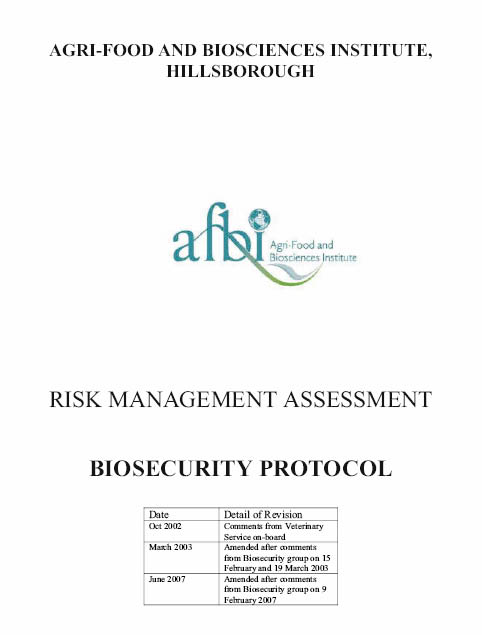
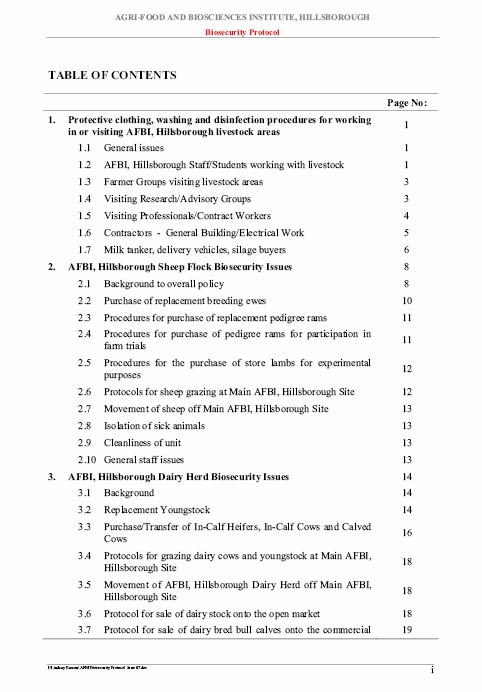
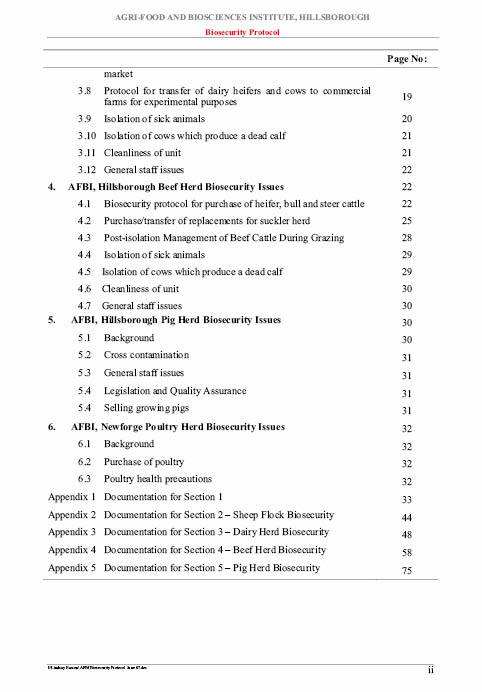

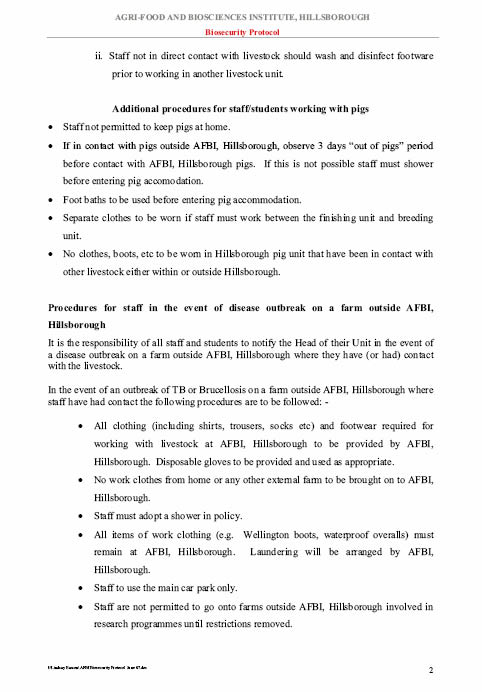
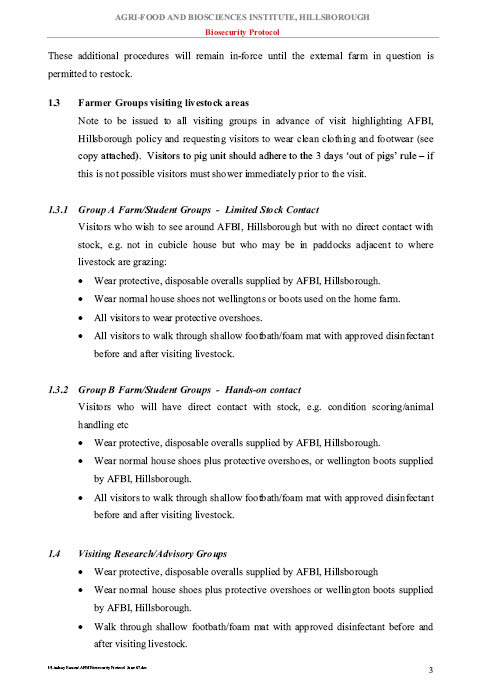


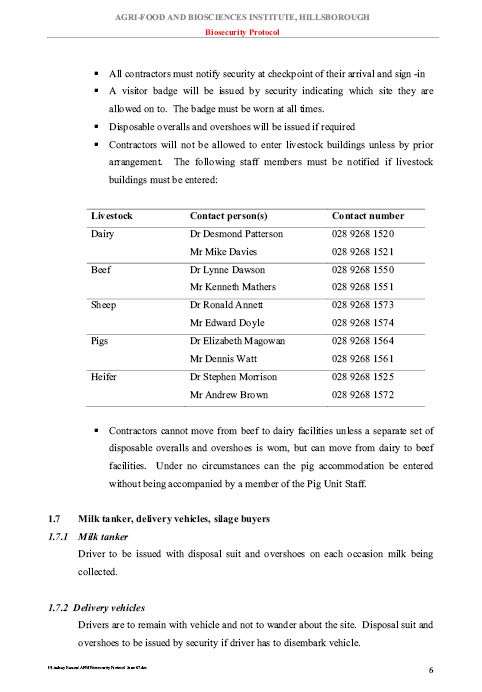
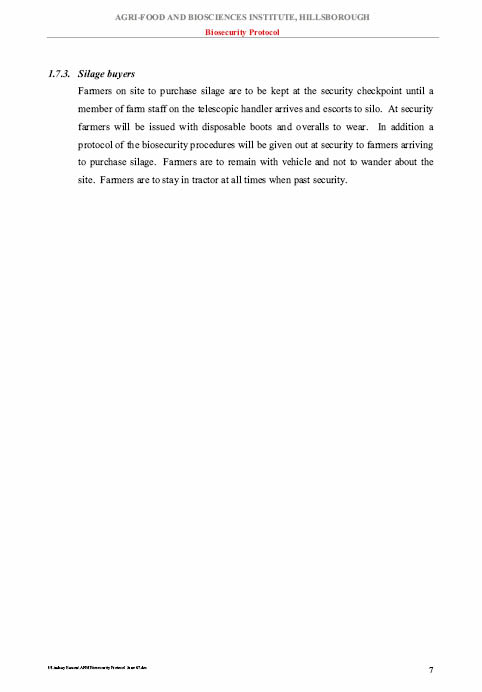
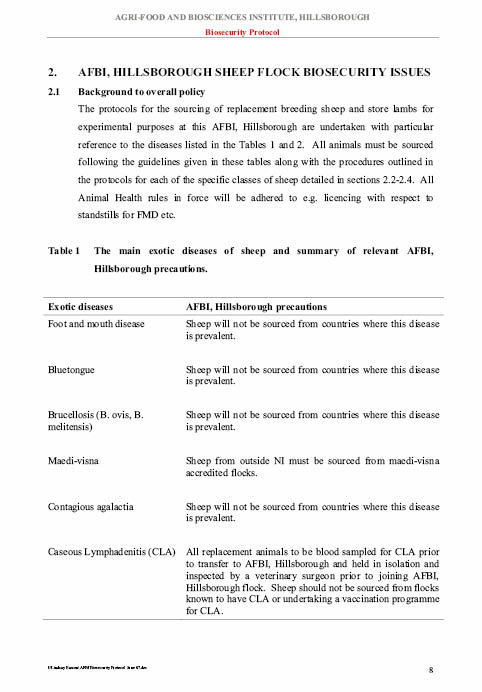
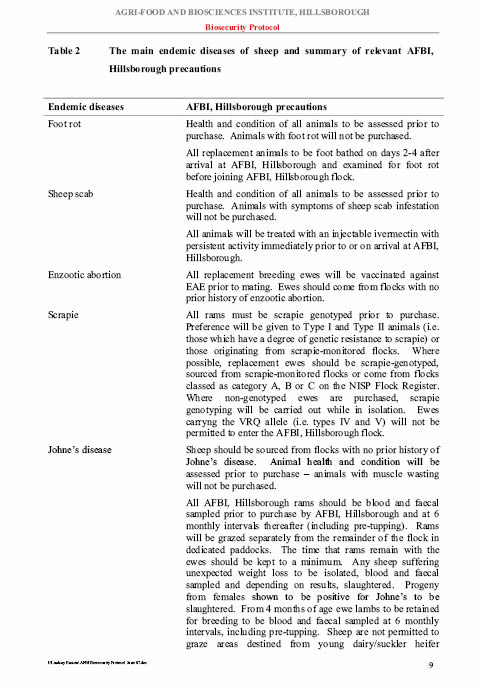
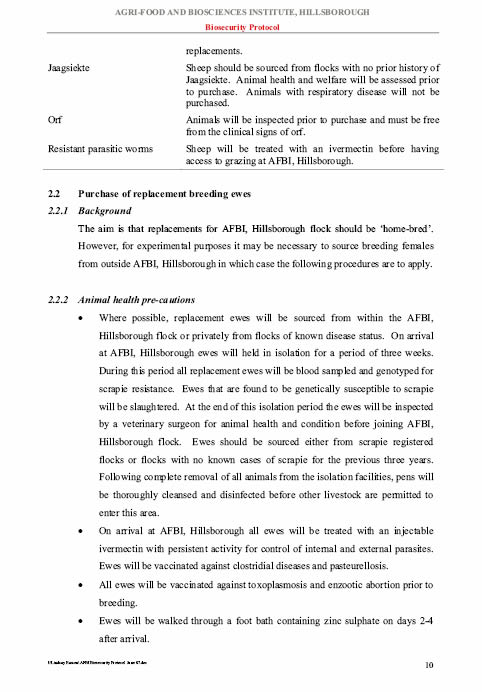

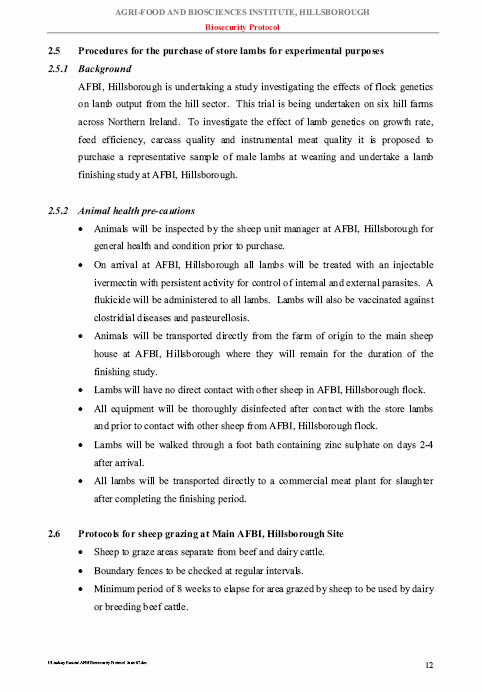



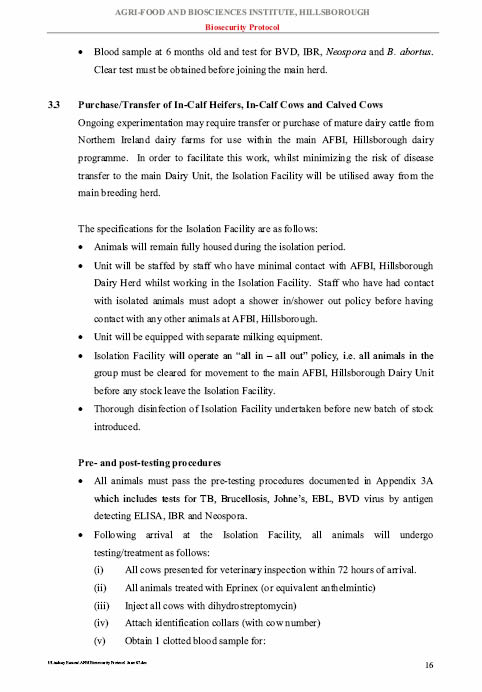
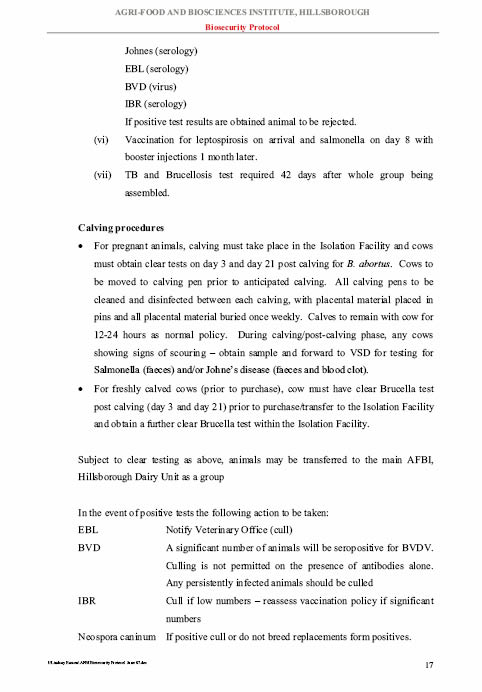

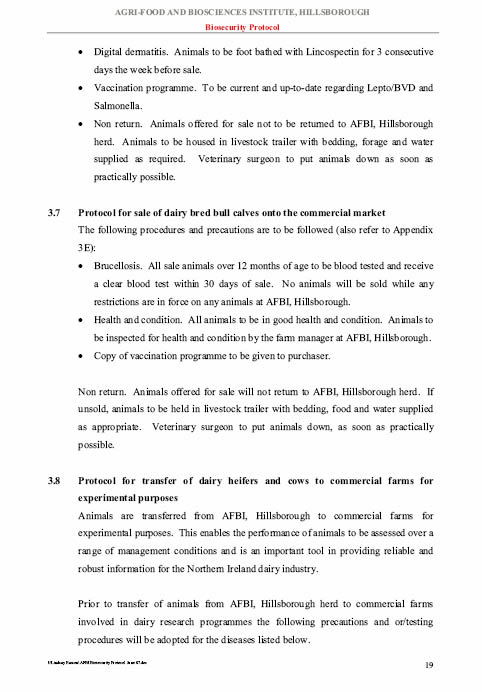
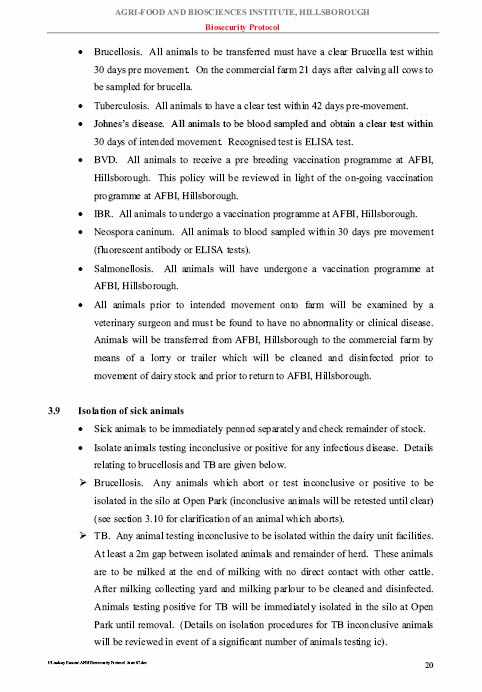
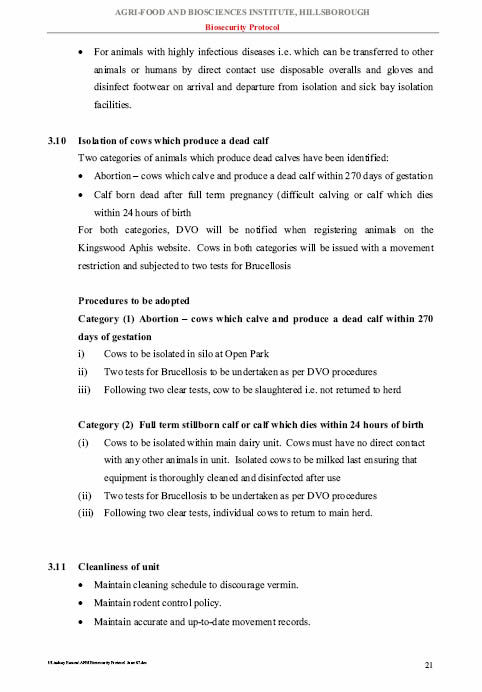
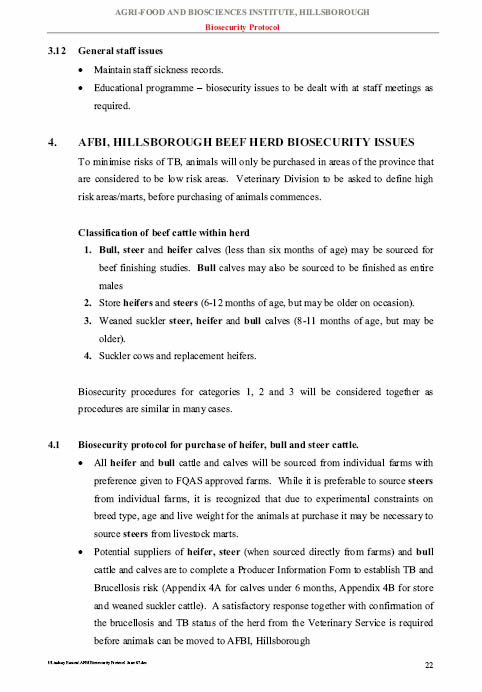
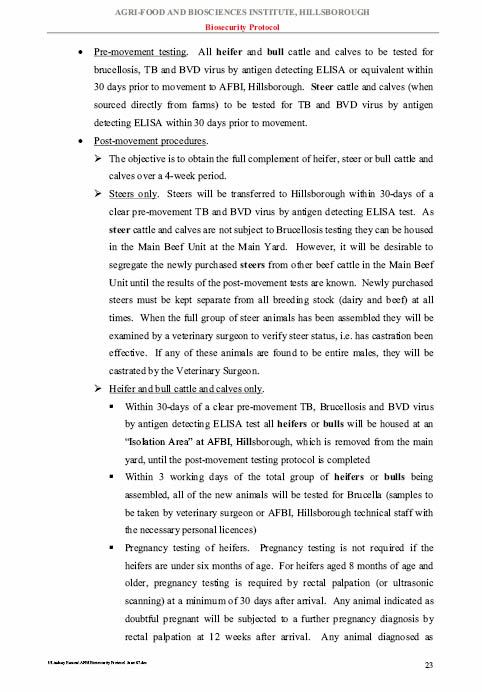

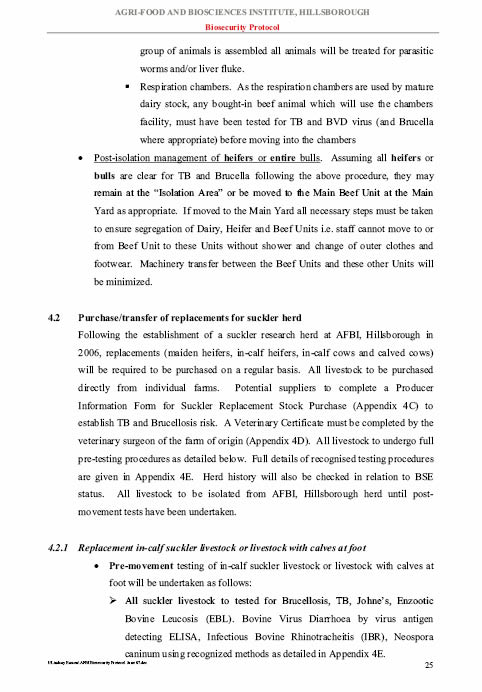
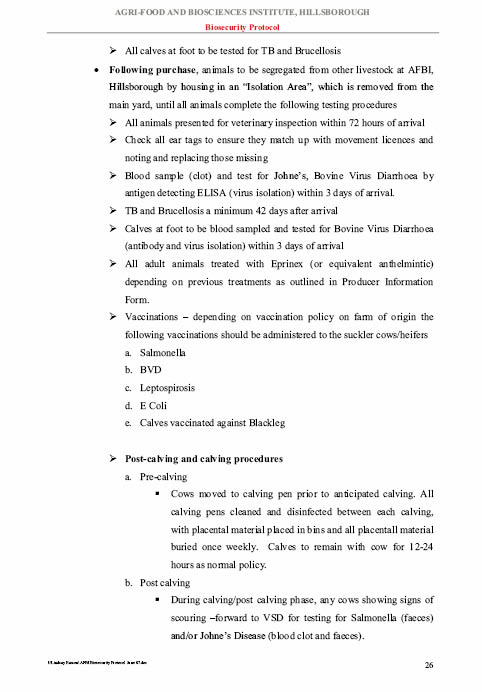
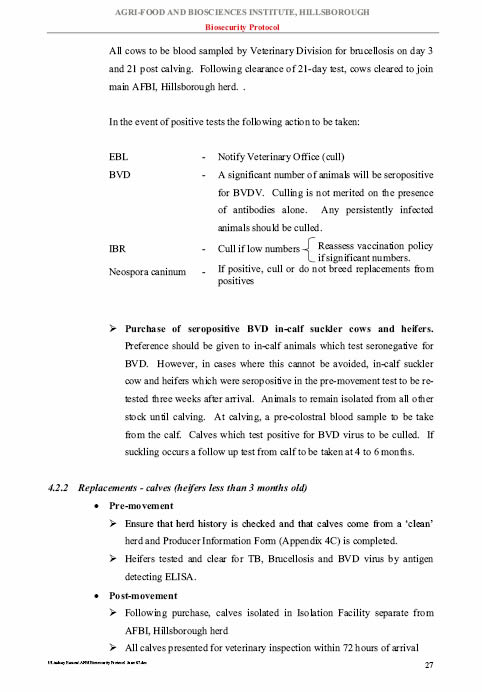
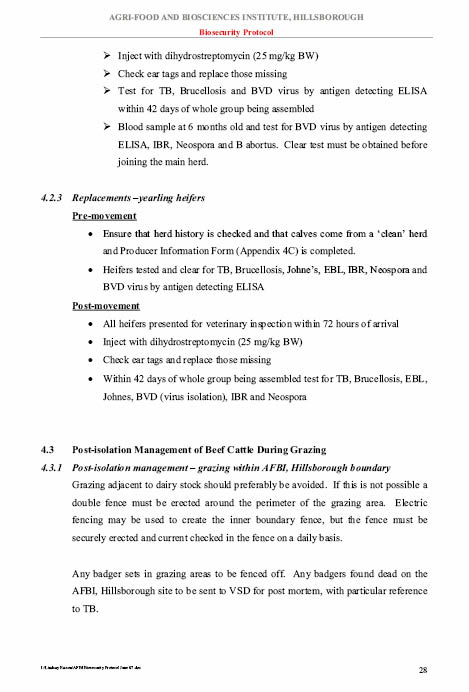


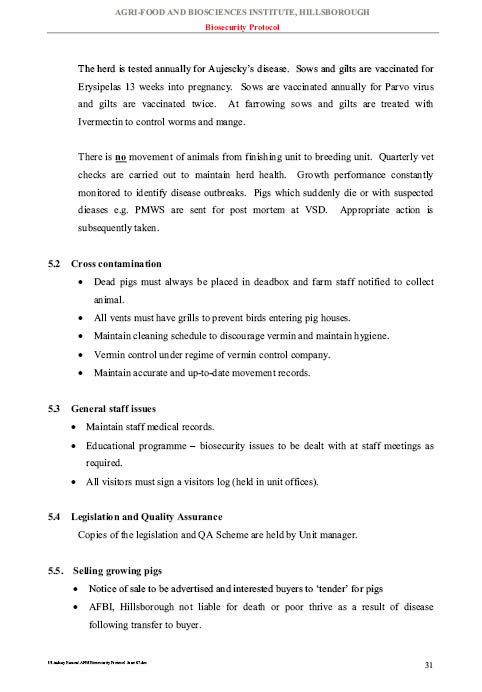
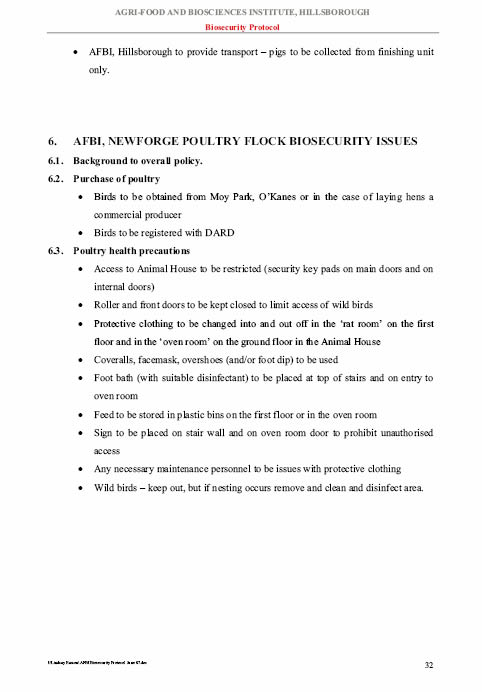

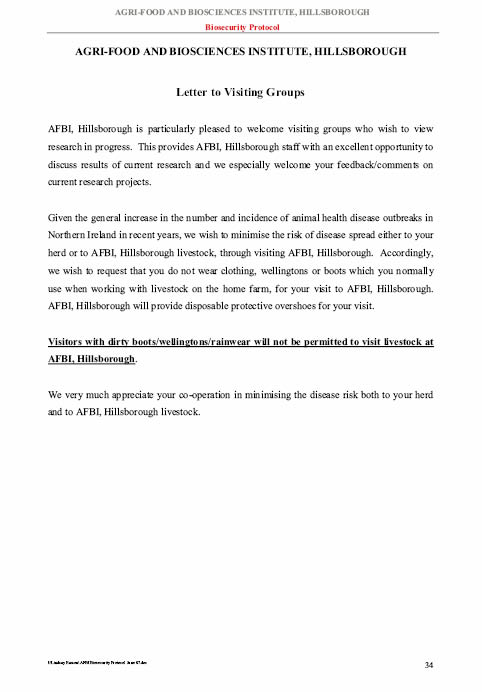

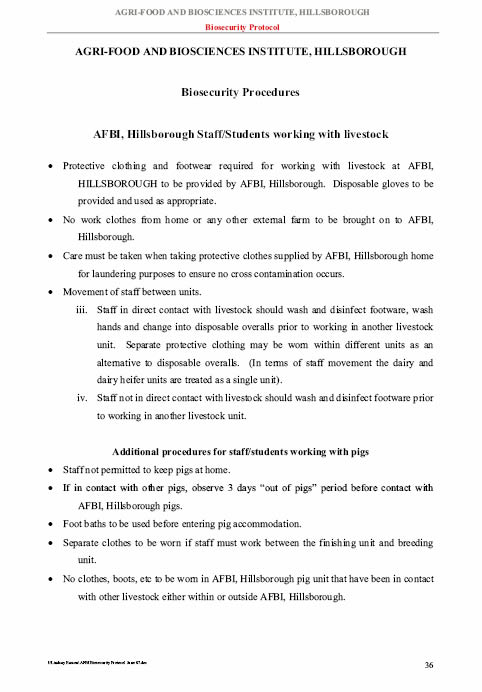
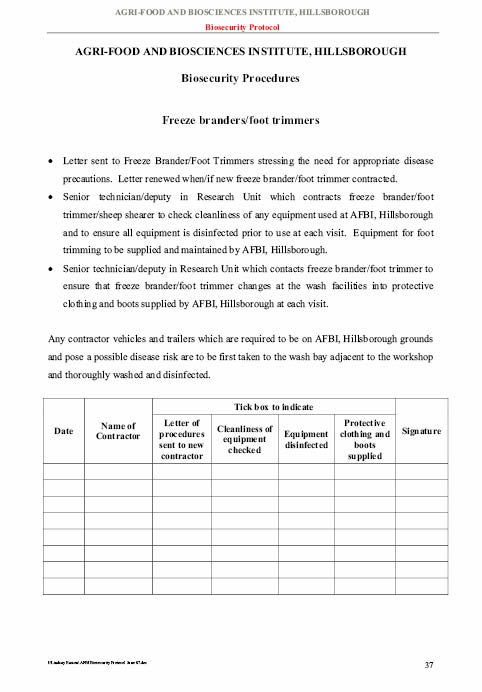
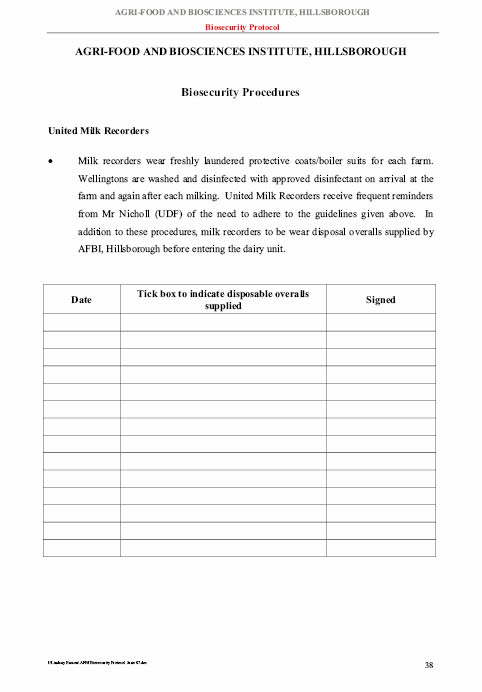
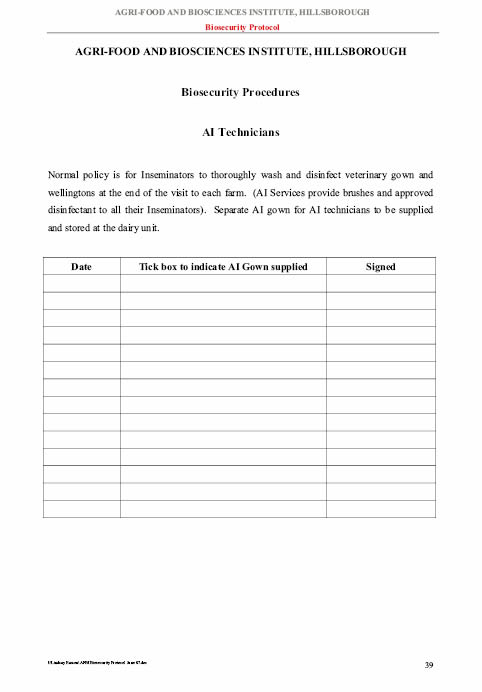



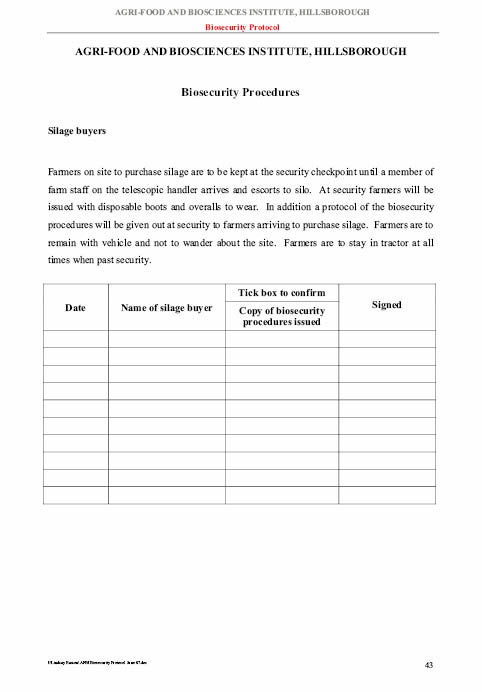





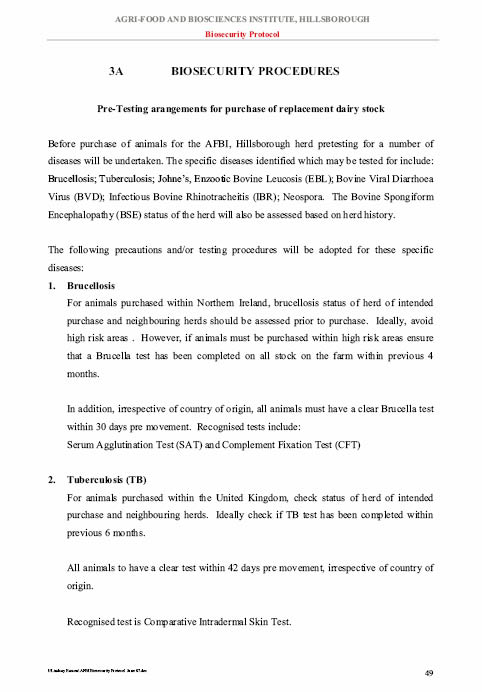


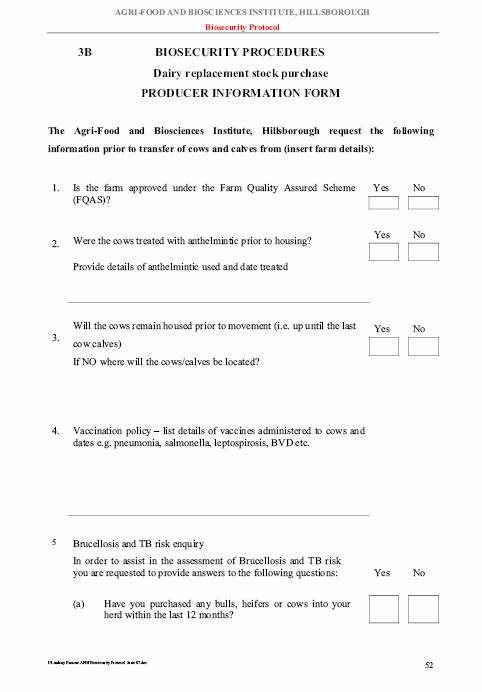
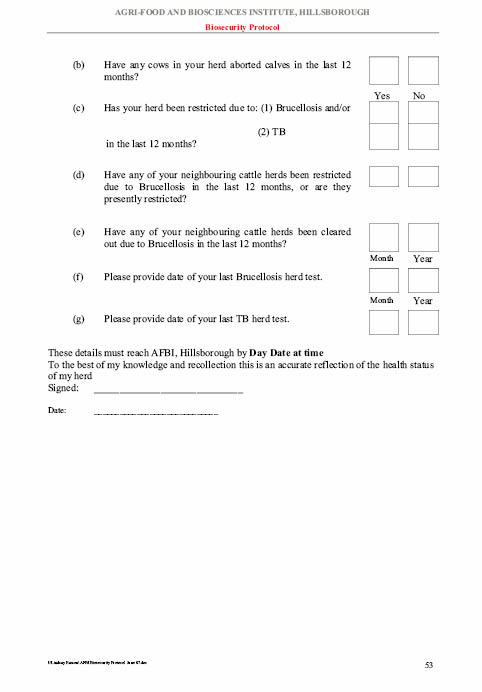


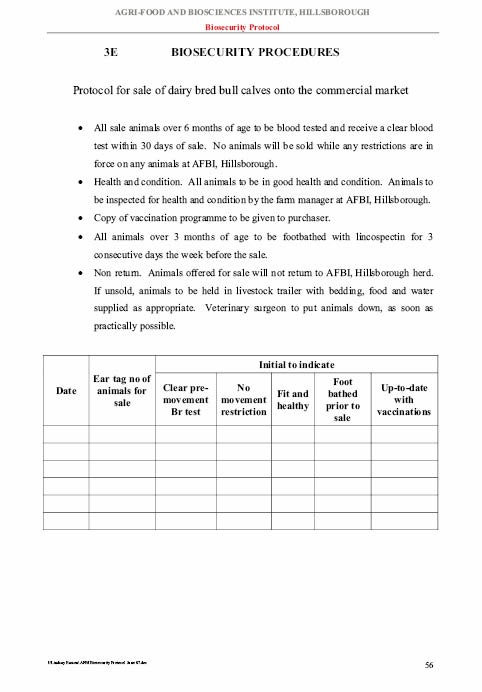

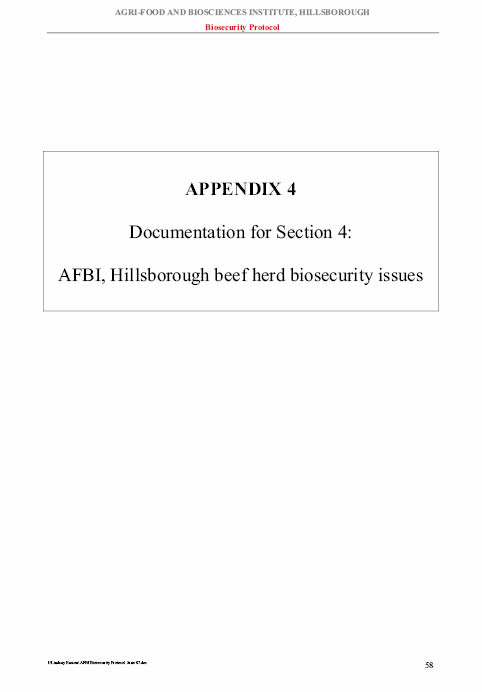
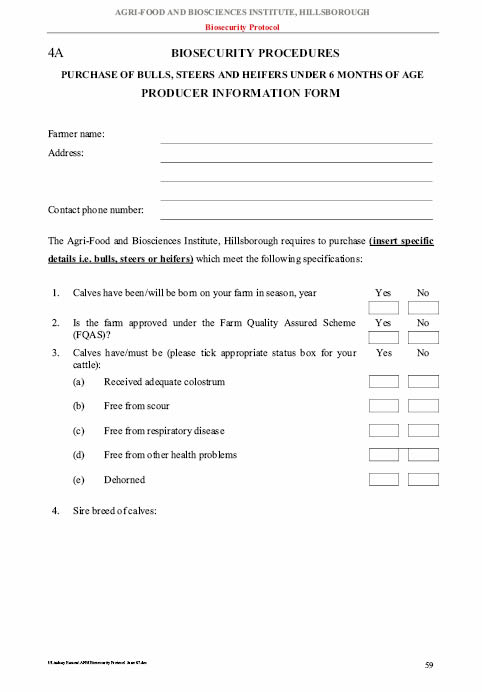
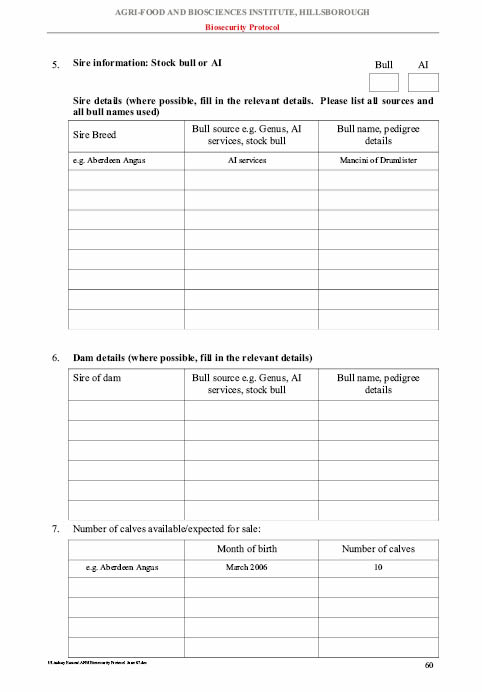
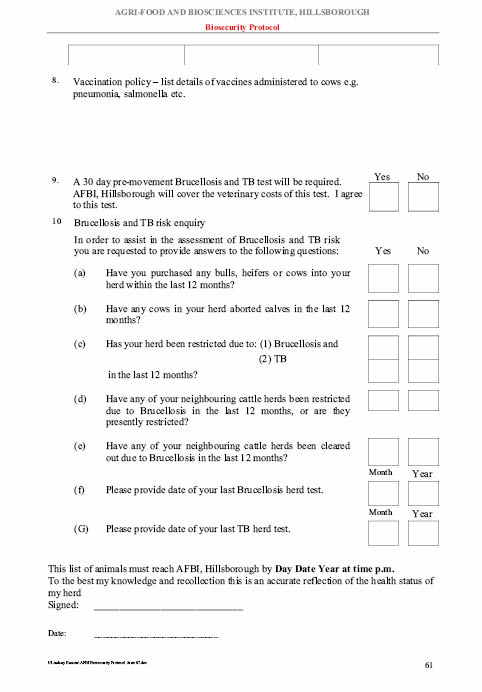
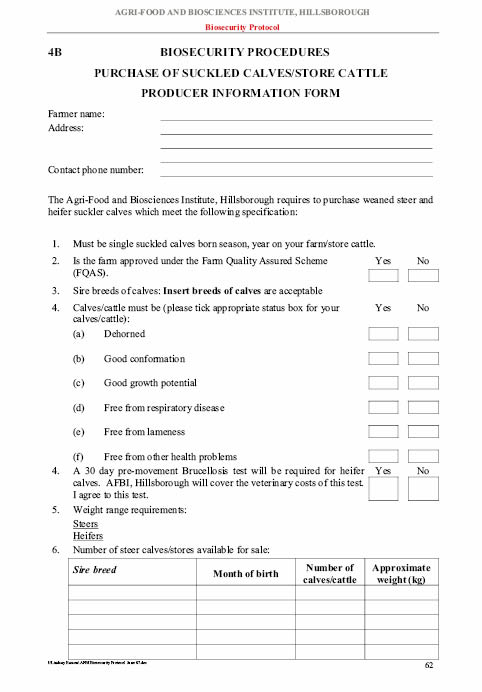


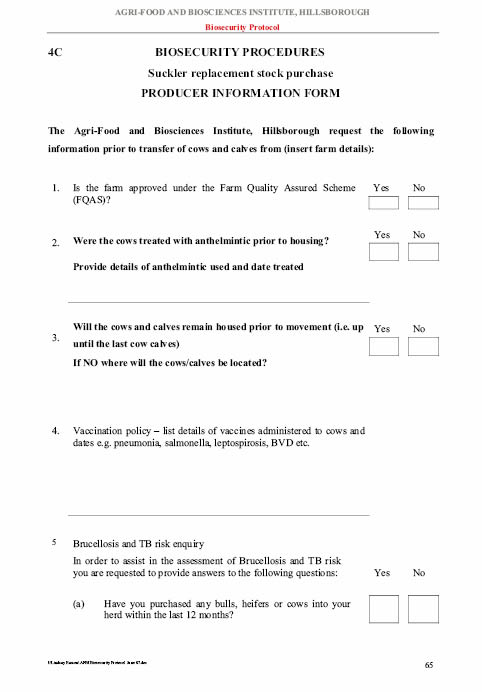
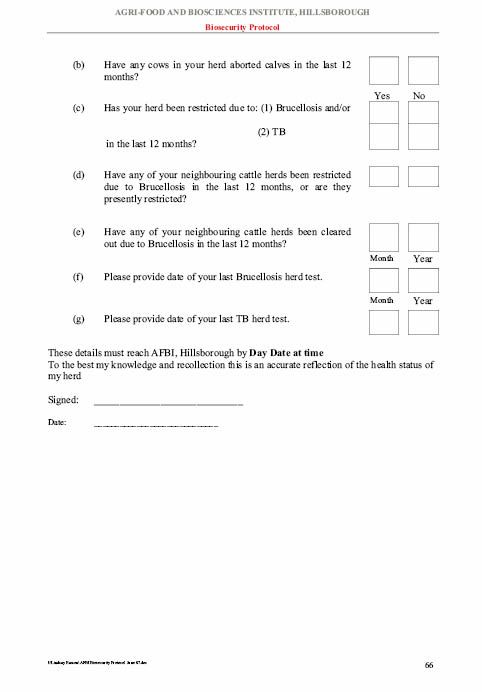

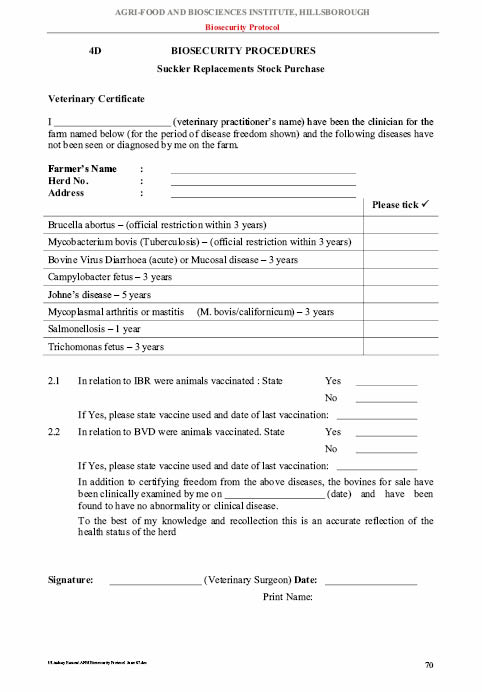
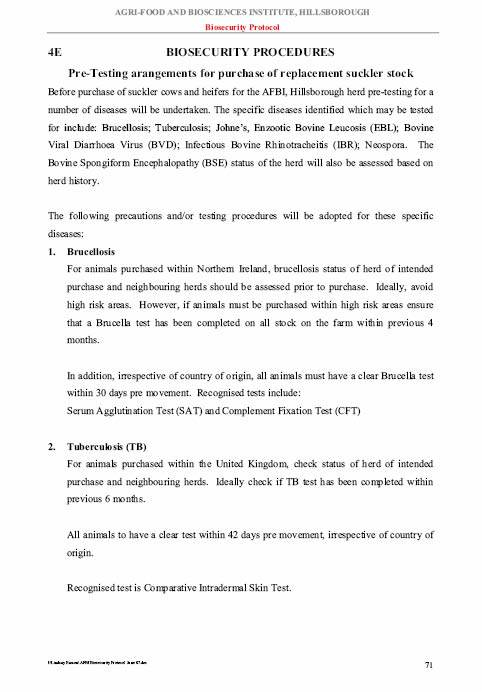
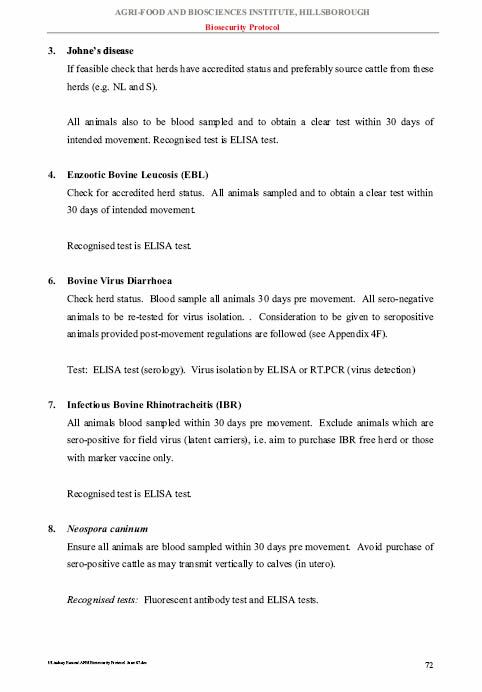
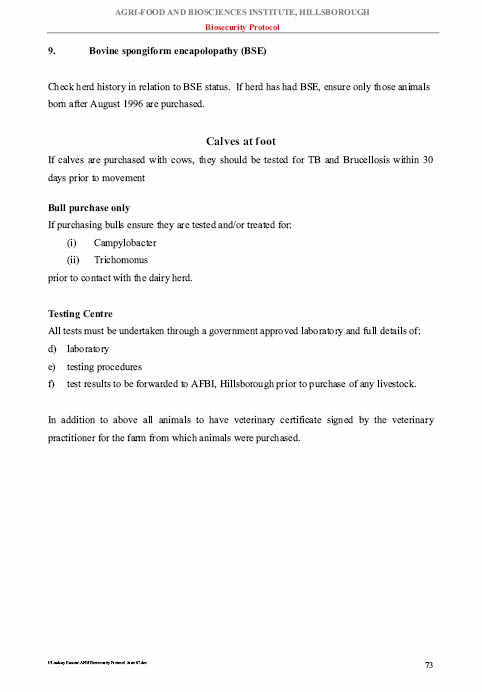



Chairperson’s Letter of 5 May 2009
to Dr Malcolm McKibbin
Public Accounts Committee
Room 371, Parliament Buildings
Belfast BT4 3XX
Tel: (028) 9052 1208
Fax: (028) 9052 0366
Email: Aoibhinn.Treanor@niassembly.gov.uk
Dr Malcolm McKibbin
Accounting Officer
Department of Agriculture and Rural Development
Dundonald House
Upper Newtownards Road
Belfast
BT4 3SB Date: 5 May 2009
Dear Malcolm
NIAO Report: Recoupment of Drainage Infrastructure Costs (HC 614) and Departmental Responses to Recommendations in NIAO Reports (HC 1149)
Memoranda of Reply: DARD: The Sheep Annual Premium Scheme; and DARD: Brucellosis Outbreak at the Agricultural Research Institute
Thank you for your responses of 20 January 2009 and 4 March 2009 to the Committee’s request for written evidence in relation to the NIAO report and Memoranda of Reply above, which were considered at Committee meeting on the 30 April 2009.
This information will be included in the report which the Committee will publish in due course.
Yours sincerely

Paul Maskey
Chairperson
Public Accounts Committee
